|
Death Valley
Historic Resource Study A History of Mining |

|
SECTION IV:
INVENTORY OF HISTORIC RESOURCES--THE EAST SIDE
A. The Bullfrog Hills
1. Introduction
In 1900 the state of Nevada was entering its third decade of depression. The incomparable Comstock Lode, which had stimulated the migration of 60,000 people into the Nevada territory, had financed a major portion of of the northern effort during the Civil War, had made Nevada into a state, and had spawned numerous smaller mining booms between the 1805s and the 1870s, had died out by 1880. Since then, no new strikes of importance had been found, the population of the state had fallen to 40,000, and the economy was suffering the effects of twenty years of decline. Some cynics even suggested that Nevada should revert to territorial status. Such was the fate of a state whose entire economy was built around the boom and bust cycle of a mining frontier. [1]
In 1900, however, the cycle was reversed. Silver was discovered at Tonopah that year, and massive high-grade gold deposits were located at Goldfield two years later. The great boom days returned to Nevada, and prospectors, spurred by dreams of untold riches, once again blanketed the mountains and deserts of Nevada. No more discoveries were made which rivaled the riches of Tonopah and Goldfield, but numerous smaller camps were established which bloomed briefly on the desert, dreaming of becoming another Virginia City. Rhyolite, the metropolis of the Bullfrog district, was one of these camps.

|
| Illustration 1. Map of the Bullfrog Hills Area. |
Gold was first discovered in the Bullfrog district in the summer of 1904. The initial finds were high-grade surface ore assayed at $700 per ton--just the kind of stuff to start a boom. Shorty Harris, one of the discoverers, later described the reaction of Goldfield when he and his partner, Ed Cross, brought in their samples:
I've seen many gold rushes in my time that were hummers, but nothing like that stampede. Men were leaving town in a steady stream with buckboards, buggies, wagons and burros. It looked like the whole population of Goldfield was trying to move at once. Timekeepers and clerks, waiters and cooks--they all got the fever and milled around wild-eyed, trying to find a way to the new "strike".
A lot of fellows loaded their stuff on two-wheeled carts--grub, tools and cooking utensils, and away they went across the desert, two or three pulling the cart and everything in it rattling. Men even hiked the seventy-five miles pushing wheelbarrows.
When Ed and. I got back to our claim a week later, more than a thousand men were camped around it, and more were coming every day. A few had tents, but most of them were in open camps.
That was the start of Bullfrog and from then things moved so fast that it made us old timers dizzy. [2]
Although Shorty Harris was guilty of much romanticizing in his later interviews, events did indeed move fast. Towns sprang up overnight in competing locations. Amargosa was laid out on September 30th and had sold 35 lots within three weeks. Beatty, to the southeast, was located on October 20th, and the towns of Bullfrog, Bonanza and Rhyolite were started by competing townsite companies in November--all within a few miles of each other. Amargosa reported 1,000 lots sold before the town was two months old, some for as high as $200 each, and by November the town boasted three stores, four saloons, two feed lots, restaurants, boarding houses, lodging houses, a post office and 35-40 other tent buildings. Prices, of course, were in proportion to the boom atmosphere and the costs of freighting 70 miles from Goldfield. Lumber for building was scarce and sold for $100 per 1,000 board feet, while hay for prospectors' burros and teamsters' mules went for $100 a ton.
The boom continued through the spring of 1905. Thirty teams a day left Goldfield for the Bullfrog district in January, and one traveler counted fifty-two outfits arriving in the district during one day in March. Confusion reigned supreme, especially for prospectors who left town for a few days in March, to find upon their return that the entire town of Amargosa had picked up and moved a few miles south to the town of Bullfrog. Bonanza's citizens had the same experience, as their town was moved to Rhyolite. Mining claims changed hands furiously, for ground near a publicized claim was worth $500 to $2,000, even if a pick had yet to strike the earth. By May, Rhyolite counted twenty saloons, a sure sign of wealth. [3]

|
| Illustration 2. Early advertisement from the town of Bullfrog. From the Bullfrog Miner June 9, 1905. |
By late spring, the dust had settled a little, at least to the point where one could leave home overnight and expect the town to be in the same location when returning. Rhyolite and Bullfrog, located only three-fourths of a mile apart, had become established as the leading towns of the district, with Beatty, four miles to the east, running a poor third, and Gold Center barely surviving. Four daily stages connected the district with the outside world, post offices were running at Beatty, Bullfrog and Rhyolite, lots in Rhyolite which sold for $100 in February were selling for $4,400, and wheel and faro games were going twenty-four hours a day. "It reminds one of the old times," remarked one prospector. In addition, Rhyolite, Bullfrog and Beatty each had a bank, and each had a weekly newspaper. The Bullfrog Miner printed its first issue on March 31st, the Beatty Bullfrog Miner on April 8th, and the Rhyolite Herald on May 5th.
The boom kept pace through June. 3000 people were estimated to be in the district, the telephone line was completed to Bullfrog and Rhyolite, and the telegraph office opened. Over 300 messages were sent over the wires on the first day of operation, mostly to Goldfield brokers and stock dealers. By the first anniversary of the district in August, both Bullfrog and Rhyolite had their own piped-in water systems, Rhyolite had yet another bank, and the two towns had a population of 2,500, with another 700 at Beatty and 40 in the tent city of Gold Center. The Rhyolite Herald listed 85 incorporated companies working in the district. [4]
The pandemonium subsided somewhat in 1906, as the rush phase of the boom slowly turned into the more controlled phase of development. 165 mining companies were reported working in the district, and all had hopes of developing another mother lode with just a few more feet of digging. Rhyolite gradually won the battle with Bullfrog and by spring had emerged as the metropolis of the southern desert, when Bullfrog's store, saloons and newspaper moved up the hill to Rhyolite. Not one, but three railroads announced plans to construct lines into the district.

|
| Illustration 3. Bullfrog, Nevada, November 1905. Courtesy, Nevada Historical Society. |

|
| Illustration 4. Rhyolite, Nevada, November 1905. Courtesy, Nevada Historical Society. |
Then, the first hint of disaster struck, with the earthquake and fire of San Francisco. Feverish developments slowed momentarily, as miners, owners, and promoters waited to see what effect the destruction of the west coast's financial center would have upon their fortunes. The boom spirit was still too prevalent, however, for the effect to be prolonged, and with the promise of financial aid (if needed) from mining promoter Charles Schwab, the bustle returned to camp. By the end of 1906, Rhyolite seemed assured of its self-proclaimed title of Queen of the Desert, when the Las Vegas and Tonopah Railroad completed its tracks into town. With the advent of cheaper rail freightage rates, the camp was certain to add to its monthly payroll of $100,000, and to continue its development. [5]
The year of 1907 was another good one. Fifty cars of freight per day were arriving over the Las Vegas & Tonopah in February. The town had grown to a population of 3,300, and lots at the heart of Rhyolite were selling for $10,000. A school census was taken which showed 250 children of school age, so a wooden schoolhouse was built, as was a concrete and steel jail for older folks. The Rhyolite Stock Exchange was incorporated and opened on March 25th, to ease the effects of feverish stock trading on the over-worked telegraph wires to Goldfield and San Francisco. In June, the Bullfrog-Goldfield Railroad came into town, opening rail connections with the north, and in September electric power was brought into town over the poles of the Nevada-California Power Company. The power was hooked into the already-wired homes, stores and offices of Rhyolite, as well as into the machinery of the big Montgomery-Shoshone mill, which soon began operations. Another newspaper, the Rhyolite Daily Bulletin appeared to compete with the district's three weekly papers. Production figures for the district went over $100,000 for the first time during the month of September, and the arrival of the Tonopah and Tidewater Railroad the next month augured even more prosperity. [6]

|
|
Illustration 5. Home of Taylor & Griffiths, Rhyolite
Brokers. Mining was the name of the game. For those who were not lucky enough to own their own mines, stock dealing was the next best thing. The firm of Taylor & Griffiths, one of Rhyolite's leading brokerage houses, was the site of much dealing, speculation and stock promoting. Photo from Rhyolite Herald, 15 June 1906. |

|
| Illustration 6. Prospecting in Death Valley was not a venture to be taken lightly. This victim, who was never identified, was found in the valley in 1907. Prospectors who found him estimated that he had been dead for two days. Photo courtesy of Death Valley National Monument Library, Neg #1138. |
Even the panic of 1907, which some would call a depression, did little to dampen the spirits of Bullfrogers. Newspapers noted, almost with wonder, that the panic seemed to affect the Bullfrog district much less than it did other mining camps in Nevada and California. The local banks were forced to issue script for a few months, due to the shortage of cash, but the local merchants gladly accepted it--even advertised for it--and the panic was put down to the manipulations of greedy eastern financiers. Despite the panic, property values sky-rocketted during 1907, and the year-end tax rolls reflected the prosperity of the young town, which was assessed taxes on almost two million dollars worth of real and personal property. [7]
1908 followed suit. The year opened with the big Montgomery-Shoshone mill treating 200 tons of ore per day, and with the promise of more mills to open soon, thus increasing the district's production and prosperity. To house all this money, the grand three-story, $60,000 John S. Cook Bank Building was completed in January. By February, all the banks were back on a cash basis, and reported that they had needed only half the amount of script which had been printed for use during the Panic. Production soared as new mills and mines went into operation, reaching an estimated $170,850 in the month of April. By September, the Bullfrog district ranked as the third largest producer in the state of Nevada, trailing only Goldfield and Tonopah. The Las Vegas and Tonopah Railroad finished its magnificent passenger station in June, which immediately became one of the showcases of the southern Nevada region. By the end of the year, the Rhyolite Herald estimated the total production for 1908 as close to $1,000,000.
Construction continued apace, as the three-story concrete and stone Overbury building was completed in. December at a cost of $50,000. Now at its height, Rhyolite fairly bustled with activity. The newspapers enthusiastically claimed a population of 12,000, although a more probable estimate would be 8,000. The town now had an opera house, a new $20,000 concrete and steel, two-story school building, hotels, ladies' clubs, and even a swimming pool. The large concrete and stone buildings which dominated the main streets were flanked by hundreds of wooden stores, offices and residences, although a few late-arrivals still lived in tents on the outskirts of town. The Western Federation of Miners' local union, with its healthy membership, union hall and hospital, threatened to surpass the local at Tonopah. Rhyolite even had a manufacturing base of two foundaries and machine shops, and the Porter Brothers, leading merchants, had built their original tent store into a imposing building complete with freight elevators and a stock worth $100,000. Dane halls and brothels, ever a sign of prosperity in a mining camp, spilled over from their assigned districts on several occasions, drawing the attention of the town council. Rhyolite and the Bullfrog district, it seemed, had arrived. [8]

|
| Illustration 7. Rhyolite near its height in February 1908. The Overbury building, and the John S. cook Bank building, to its right, dominate the city. The tracks of the Bullfrog and Goldfield Railroad may be seen in the lower right and lower left corners. The lumber yard of the Tonopah Lumber Company is in the lower right, next to the city jail. The school house is not yet built. Various mines can be seen in the background, and the former city of Bullfrog is at the extreme left background. Photo courtesy of Nevada Historical Society. |
In the meantime, the Rhyolite and Bullfrog boom were having much the same effect upon the surrounding Death Valley country as Goldfield and Tonopah had had upon the entire state. Spurred by the Bullfrog boom and dreams of wealth, prospectors swarmed out of Rhyolite into the hills and deserts of southeastern Nevada and southwestern California. Backed by flush Rhyolite merchants and promoters, these men examined the countryside as it has never been examined before or since. For a while, the results seemed almost too good to be true, for strikes and mining camps blossomed out of the wilderness almost everywhere one could see. On the east side of Death Valley, the entire South Bullfrog district grew up around the Keane Wonder mine, while farther to the south arose the boom camps of Lee, Echo, Schwab, Greenwater, Gold Valley and Ibex. Farther to the west, across the Death Valley sink, prospectors out of Rhyolite found and established the mines and camps of Emigrant Springs, Skidoo, Harrisburg and Ubehebe. All these camps looked upon Rhyolite as the metropolis of the desert, and Rhyolite merchants, teamsters and outfitters, located at the railhead, profited immensely from being situated at the distribution center for the region.
As usual, however, the gold fever which swept the country contained more fever than gold. Some of the smaller camps died almost as soon as they were born, leaving little more than a ripple on the surface of time. Some, like Greenwater, spent all their energy on booming, and when the dust had settled, nothing was left to be seen. Most lasted a year or two, or even three. But with the exception of Skidoo and the Keane Wonder, all the smaller camps died before Rhyolite, and the fate of the offspring presaged the fate of the parent.

|
| Illustration 8. Sketch Map, Bullfrog District. |
On the surface, Rhyolite seemed as robust as ever in early 1909, and the citizens of the town even started a movement to split the county in two, making Rhyolite the county seat of the southern portion. Such ambitions, however, were hopeless, for the cracks were already appearing in the facade. Although the boom spirit had carried the Bullfrog district through the San Francisco disaster and the panic of 1907 without appearing to harm the camp, underlying problems were beginning to surface. Investor confidence was weakened by the financial difficulties, a fatal blow to any mining camp. Two of the three Rhyolite banks had closed by the end of 1909, and shady dealings involving two of the district's most promising mines further shook investor confidence. The Montgomery- Shoshone mill continued to mill its low-grade ore throughout 1909, but there is nothing romantic about low-grade ore. A brief new boom at Pioneer, to the north, seemed to arrest the process of decline for a short time, but a disastrous fire roared through that camp before it was even built, and it never recovered.
The process of decay is harder to document than that of boom, since the local newspapers would never, dare print any discouraging news, but the evidence was there. The Rhyolite Daily Bulletin was the first newspaper to close, printing its last issue in May of 1909, and the Bullfrog Miner followed suit in September. The December tax rolls told the real story. When the time came to ante up for county taxes, owners of 156 properties--or 28 percent of the total tax base--elected to quietly leave town and let their properties be confiscated by the county treasurer, rather than spending more money in a losing cause. As the Mining World summed up, "Mining operations in the Bullfrog district were rather dull last year." [9]
The camp plodded through 1910, struggling to keep alive, and hoping that some prospector would make the strike which would bring back the days of prosperity. Their hopes were doomed, however, and when tax time rolled around again, 168 taxable properties (44 percent) were left to the care of the county treasurer, as their owners had departed. The First National Bank closed its doors that year, the fast bank to leave Rhyolite.
The trend accelerated in 1911, when the Montgomery-Shoshone, the only mine to make any significant production in the district, finally shut down in May. The 1911 tax rolls again showed owners of 1.18 properties (43 percent) leaving town rather than pay taxes, and the Mining World sounded the death knoll. "The Bullfrog district is almost deserted, save by a few lessees, who at intervels [sic] make a small production . . . . The Montgomery-Shoshone, after demonstrating that ore averaging $6 a ton could be profitably milled, has closed down, having exhausted its pay ore." [10]
The Bullfrog district, too, was exhausted. The town and camp did not die with a bang, and hardly with a whimper. Companies who had money left in their treasuries held on to properties, hoping for a comeback, and several dozen intrepid souls stayed on in Rhyolite, eeking out existence by leasing mines and extracting occasional small shipments of ore. The great days, however, were definitely gone forever. The Rhyolite Herald finally gave up and closed down in June of 1912, and the town slowly died.
Periodic efforts were made to reorganize and rework the mines on a small scale, which kept Rhyolite from becoming a complete ghost town for several years, but none were successful. In 1914, the Las Vegas & Tonopah discontinued service to the town, above the protests of the few remaining citizens. In 1916, the Nevada-California power company cut off electricity to Rhyolite, and began to salvage its poles and wire. The Inyo Register described the once thriving town in December of that year: "Rhyolite, once a camp claiming several thousand population, is practically a deserted village . . . the movable buildings have been moved away from time to time, and the process is still going on. At present it is contributing to the upbuilding of the camp of Carrara. . ." By 1920, although a few companies and individuals still held on to their Rhyolite properties, hoping against hope for a revival, the camp was completely deserted." [11]
And so Rhyolite was slowly dismantled to serve the needs of new boom camps, and the cycle was completed. Although small-scale efforts were made to revive the camp from time to time--including one during the fall of 1978--the good days were gone. Today, the crumbling remains of its once imposing structures, together with its picturesque location, make it one of the west's most popular ghost towns. Ironically, Beatty, 4 miles to the west, which played little sister to Rhyolite throughout the boom years, was saved from decline by the construction of Nevada Highway 95, and today that little town of several hundred thrives on the trade of tourist, military personnel and truckers traveling between Las Vegas and Reno.

|
| Illustration 9. Rhyolite, 1978. John S. Cook Bank building. Photo by John Latschar. . |
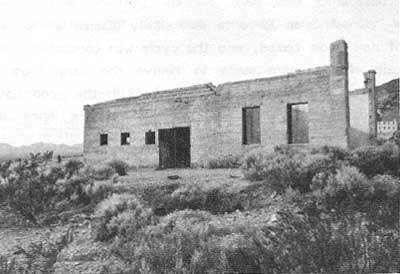
|
| Illustration 10. Rhyolite, 1978. Rhyolite jail. Photo by John Latschar. |
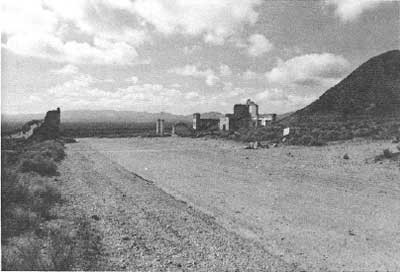
|
| Illustration 11. Golden street, Rhyolite, looking south from John S. Cook Bank building. Facade of Porter Brothers store on left, ruins of Overbury building on right. Photo by John Latschar. |
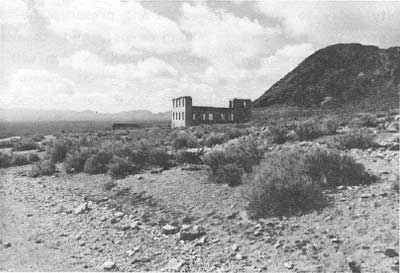
|
| Illustration 12. Rhyolite's pride, the $20,000 school building. Completed after the boom had left the Bullfrog rose, the building was never used to capacity. Photo by John Latschar. |
All was not in vain, however. The Bullfrog district produced $1,687,792 worth of ore in the four short years between 1907 and 1910, doing its part, along with the other small camps and the bonanzas of Goldfield and Tonopah, in pulling Nevada out of its two-decade slump. Without the stimulus of this early twentieth-century mining boom, of which Rhyolite and the Bullfrog district were a distinct part, Nevada would not have had the new economic base with which to survive the great depression, and to emerge as a prosperous mineral, tourist and military state of today. [12]
Just as important, without the boom and bust days of Rhyolite and the surrounding territory, we would not have the opportunity today to study, appreciate and preserve the memories of these early twentieth-century mining camps. And, thanks to the Bullfrog boom, Death Valley National Monument is rich with such a heritage of bygone days.
2. Original Bullfrog Mine
a. History
In the late summer of 1904, two wandering prospectors happened to meet at the Keane Wonder Mine, on the east slope of Death Valley. Ed Cross, the first, was an occasional prospector who had participated in mining rushes from time to time. Cross, however, was an "amateur" prospector, since he had a home and farm in Long Pine, California, to which he would return between forays. Attracted by the Goldfield boom, Cross was on his way towards that region, and had stopped off at the Keane Wonder to look over the country surrounding that recent discovery.
The other prospector, Frank "Shorty" Harris, was a veteran desert rat. Shorty bragged that he had attended every mining rush in the country since the 1880s, including those of Leadville, Coeur d'Alene, Tombstone, Butte, British Columbia, and others. Like most prospectors, Shorty had, as yet, nothing to show for his efforts. He had already been through the initial Tonopah and Goldfield booms, but had gotten there too late to locate any close-in ground. Now, like Cross, Shorty Harris was determined to give the Goldfield territory another look, and the two men teamed up.
Like countless other prospectors who were scurrying around the deserts, Cross and Harris dreamed of finding another bonanza like those of Goldfield and Tonopah. As the two men trugged across the Amargosa Valley, that dream loomed large before them, for they were about to make the discovery which would initiate the great Bullfrog boom, and which would change forever the history and territory of southwest Nevada.
Accounts of the next few days vary wildly, as romantic tales of big discoveries are wont to do. Both Cross and Harris repeated their versions in later years many times over, and it is difficult to find any two versions which agree. Apparently Shorty persuaded Ed to make a detour on the way to Goldfield, in order to examine some rock outcroppings which he had noticed on an earlier trip. There, on the east side of the Amargosa Valley, the discovery was made. Both men knew at first glance that they had found something big, but how big would have to be determined by the Goldfield assayer's report. Quickly locating a claim, staking the ground, and naming the mine the Bullfrog, for the distinctive mottled green ore, the two men set out north for Goldfield, to record their claim, have their samples assayed, and to celebrate.
The rock samples indicated that the mine had ore worth over $700 to the ton--truly bonanza stuff. News of the discovery soon spread through Goldfield, and by morning the rush to the newly named Bullfrog District was on. In the meantime, Ed Cross went north to Tonopah to record the claim there in addition to Goldfield, since no one knew whether the mine was located in Esmeralda or Nye county. By the time Ed got back, Shorty was half-way through a six day drunk, sometime during which he sold his share of the Bullfrog mine. Cross later claimed several times that Shorty got no more for his share than $500 and a mule, although Shorty once claimed to have received $1,000, and thirty years later said he got $25,000. At any rate, Shorty Harris was out of the picture. Like most old-time prospectors, he had spent most of his life looking for a gold mine, and had sold it for a pittance when he found it.
Ed Cross was more business-like, as he reported to his wife. After several deals feel through, Ed sold his share to a group of mining promoters for cash and a share of the stock in a company formed to exploit the mine. Ed later claimed to have received $125,000 for his share of the mine, but that figure is probably inflated. But whatever the exact amounts, both Cross and Harris had sold out--one for drink and the other for stock certificates. Which would prove to be the better deal was yet to be seen. It is certain, however, that neither of the two prospectors who started the great Bullfrog boom made much profit from their discovery--but that is nothing new in the history of mining. [13]
By early fall, the Bullfrog boom was in full bloom. Tents, towns and prospectors surrounded the area of the Bullfrog Mine, as prospectors and promoters rushed to get in on the ground floor. In short succession, mine after mine was discovered in the vicinity, and the Bullfrog District became the talk of the west coast. In the meantime, the Original Bullfrog Mines Syndicate, organized to operate the original discoveries, was incorporated by the Goldfield promoters dealing with Ed Cross, and actual mining was started. The company advertised a capital stock of 1,000,000 shares, with a par value of $1 each, but they did not say how much actual cash was placed in the treasury to finance the development efforts. As events proved, it wasn't enough. Ed Cross was given a seat on the board of directors of the company, as befitted the owner of one sixth of the mine.
Initial development through the fall and winter of 1904 were promising. The company reported ore assaying as high as $818 to the ton, and began sacking high-grade ore for shipment to Goldfield smelters. On March 23, 1905, the original Bullfrog Mine made the first big shipment out of the new district. Ore estimated to be worth $10,000 was escorted through Rhyolite by five armed guards and the Rhyolite band. The Original Bullfrog Mine, symbol of the entire Bullfrog district, was now a shipper and a producer. More good strikes were made in the shafts and tunnels through May and June; sixteen men were employed at the mine; a 15 horsepower gasoline hoist was ordered to enable deeper sinking; and the mine superintendent expressed the hope that shipments of high-grade ore would pay for all development costs, thus saving a strain upon the company's treasury. By August of 1905, the superintendent estimated that the company had between $750,000 and $1,500,000 worth of ore in sight in the mine. [14]
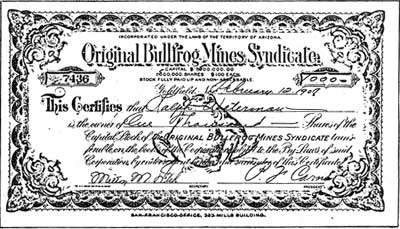
|
| Illustration 13. Certificate for 1,000 shares in the Original Bullfrog Mines Syndicate. Courtesy Dr. Richard Lingenfelter. |
The Original Bullfrog Mine continued to reflect the optimism of the entire district throughout the fall and winter of 1905. As shafts and tunnels went deeper, ore veins continued to show profitable values in gold, even though no rich shoots were found, such as the early surface discoveries. The Bullfrog District became so famous on a national level, that the United States Geologic Survey decided that it was worth examining. Frederick L. Ransome, an eminent western mining expert, made a study of the district's geologic formations and mines during the fall of 1905. Since Ransome was the first detached, outside observer of the district, his conclusions are of interest. The district, he wrote, was predominantly a low-grade proposition, and would have trouble making a profit, due, to problems of transportation and water supply. After the first publicized shipments, such as that from the Original Bullfrog Mine, none of the mines planned to make further shipments, due to excessive costs, until the railroads arrived. In essence, he concluded, the Bullfrog District was not the bonanza it liked to believe it was, but the mines could be made to pay on a large-scale basis, given careful and economical management. Nor was Ransome more impressed with the Original Bullfrog Mine than with others. "Some bunches of rich ore have been found," he wrote, "but the mass as a whole is of very low grade." [15]

|
| Illustration 14. The Original Bullfrog Mine in the summer of 1905. The short-lived tent city of Amargosa may be seen in the distance. Photo from Sunset Magazine, August 1905, p. 321, courtesy Nevada Historical Society. |
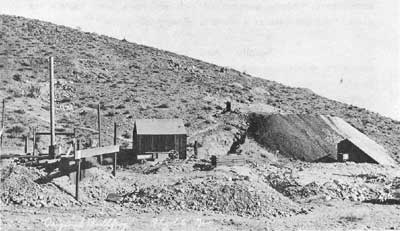
|
| Illustration 15. Original Bullfrog Mine, November 1905. Photo courtesy of Nevada Historical Society. |
Happily for the Bullfroggers, however, Ransome's report was not printed for another two years, and the district hummed along merrily in the meantime. The Original Bullfrog Company continued to get encouraging results from its development works, and applied for a U.S. patent to their claims in January of 1906. A distinguished mine superintendent was hired away from the famous Gilpin County district of Colorado in the late spring, and the company installed a gas hoist and gallows frame on its property, in order to facilitate deeper mining. Even the brief financial panic brought about by the San Francisco earthquake and fire failed to slow development work, and William Ress celebrated his first anniversary as proprietor of the Original Bullfrog boarding house in May.
After examining the mine and its future prospects, Samuel Newell, the new superintendent from Colorado, decided that he would be there long enough to settle down, and set home for a bride. Mrs. Newell arrived in August and moved out to the mine site to live with her husband. Unfortunately, the summer climate of the Nevada desert did not agree with her, and she died in late September of "desert fever." [16]
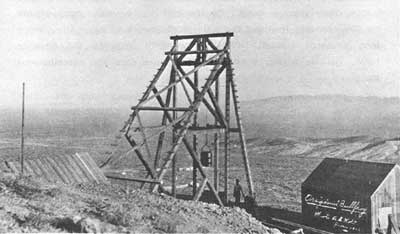
|
| Illustration 16. Original Bullfrog Mine near its peak, June 1906. The new large gallows frame, with its bucket hoist, dominates the picture. Photo courtesy of Nevada Historical Society. |
The tragic loss of his two-month bride failed to diminish the energy of superintendent Newell. With the arrival of cooler weather in October, development was increased at the mine. The main shaft was now 250 feet deep, the mine was employing two shifts, of miners, and landlord Ress was feeding 30 miners, most from the Original Bullfrog. By November the shaft was down to 300 feet, and although no rich ore had been found since, the shaft had left the surface, the newspapers reported "encouraging values," a vague description at best. By the end of the year, improvements on the property included the main shaft, two working shafts, and a long crosscut tunnel. Physical property included the gasoline hoist, gallows frame, a small orehouse, ore cars and miscellaneous tools.
In the meanwhile, another development had taken place. On October 26th, Ed Cross had taken a lease from the company to work a 200 by 300 foot tract of the Original Bullfrog claim. Leasing at this stage of the mine's development could only mean that the company directors no longer felt that it was financially feasible to maintain a monopoly on development rights to its own property--a sure indication that things were not looking good. Cross, in a typical lease, was given one year to work the property and take out ore, while paying the company a royalty on any profits he was able to make. Cross had good luck initially, and by the end of 1906 was employing twelve men on his lease and had built an office. [17]
As 1907 began, the Original Bullfrog Mine had already seen its best days. Even though the railroad had now arrived, making possible the shipment of lower grade ore, the mine was not able to gain a profitable status. Development work continued throughout the year, by both the company itself and by Ed Cross on its. lease, but time was running out. The initial treasury fund was almost depleted, and the advent of bigger and more promising mines in the district discouraged stock sales. Shares in the Original Bullfrog Mines Syndicate, which had sold for 25¢ in November of 1906, had fallen to 74¢ by July of 1907. Desperately, the company continued, hoping to find that elusive high-grade vein which would make the mine a boomer once more, but hopes were doomed.
Ed Cross, despite his limited success on his lease, saw the handwriting on the wall, and decided not to renew the lease when it expired. Finally, the Panic of 1907 dealt the death-blow to the Original Bullfrog mine. With the treasury stock depleted, and with several of the leading owners facing extreme financial difficulties brought on by the panic, there were no more funds for-development work in the mine. On August 26th, the mine was closed and the employees laid off. The company's president issued a statement claiming that the closure had nothing to do with the financial crisis, but no one held their breath while waiting for the mine to reopen. For the rest of the year, the mine was not worked, and when tax time rolled around in December, the company let its property go on the delinquent roll, rather than pay $46.20 in taxes. Shares of Original Bullfrog stock were now selling for 3¢ each. [18]
In the spring of 1908, the mine was reactivated, but on a small scale. No longer did the superintendent announce grand plans for future development works, or the building of mills. Rather, the mine limped along on a very small scale, attempting to extract enough ore to cover operating costs. Leasing arrangements were sought, in order to bring more money into the treasury, and several individuals were lured by the magic of the Bullfrog name. Superintendent Newell managed to make several shipments of ore, but in small quantities--total April production, for example, reached the grand sum of $350, while lease-holders managed to ship $790 worth of ore in May.
Even these low figures did not reflect profits. One shipper, who had ore worth $160 a ton from a Bullfrog lease, paid over $20 to the railroad for shipping charges and over $37 to the Goldfield smelter for reduction charges, leaving him with a profit of $103 for his labor, before he paid the Original Bullfrog Company its royalty. By now it was clearly evident, as Ransome had pointed out several years before, that the Original Bullfrog Mine was a very low grade proposition, which could not be profitably exploited under present conditions. By the end of 1908, both stockholders and the company had come to agree with that assessment. Stock sales had slumped to 1¢ per share, and the company again could not find the money to pay its $34.65 in county taxes. Still, hoping against hope, several tease-holders hung on. [19]
In March of 1909, the Rhyolite Herald in its grand pictorial supplement, gave a long history of the discovery and developments of the Original Bullfrog mine, sadly concluding that The work has not proceeded . . . to the point of placing the property in the regular producing list." This was as far as a Rhyolite newspaper was willing to go towards admitting that the mine was dead. The Nye county treasurer, however, was willing to go farther, and in August of 1909 seized the movable property of the company in consideration for two years of unpaid taxes. Still, some hardy and hopeful individuals were willing to risk a few months' labor in the hope of finding the elusive green ore, and the property was working sporadically on a leasing basis.
By 1910, when it was becoming apparent that the entire Bullfrog District was dying, the Rhyolite Herald indulged in that favorite speculation of what-might-have-been. After discussing the early glory days of the district and the Original Bullfrog Mine, when high-grade ore was being shipped under armed guard, the Herald lamented: "If that kind of stuff, which ran up into the many hundreds of dollars per ton, had stayed in the Original instead of pinching out, the story of Bullfrog would be "another tale than what it is." True, but, Although the boom days were now definitely over, hope still persisted, as it can only do in a mining camp. In 1912, the success of a neighboring mine provoked rumors that the Original Bullfrog would be reorganized and reopened, but nothing happened. Small time operators continued to work the ground in 1913 and 1914, through leases. The patented claims of the mine lay on the delinquent list of the county tax roll, for want of anyone to pay, back taxes and reclaim the land. In 1917 a group of promoters incorporated the Re-Organized Original Bullfrog Mines Syndicate, but again nothing came of that effort. [20]
Nothing is harder to kill than the mystique of a name, especially a name such as the Original Bullfrog, with its intimate connections with the glorious boom and bust of the Bullfrog district. Time and again, throughout the following years, miners, prospectors, promoters and even movie stars were attracted by the prevailing mystique of the Original Bullfrog Mine. Surely, they thought, there must be something there, if this was the mine which started the whole thing. Their efforts were met with various degrees of middling success.
In the late 1920's the New Original Bullfrog Mines Company was organized and fitful shipments were made for several years before the enterprise folded. In 1930, Roy Pomeroy, a Hollywood executive, put together an organization with the backing of contemporary movie stars, and bought the Original Bullfrog as well as several other mines in the district. The Nye County treasurer, however, was soon listing all those properties once again on the delinquent tax roll.
In 1937 the Original Bullfrog, along with other mines, was purchased by the Burm-Ball Mining Company, which operated for several years, extracting small-scale shipments, before leasing them to other operators. These lease-holders operated intermittently through the 1940s and into the 1950s, but without any significant success. In 1955, one E.J. Kingsinger bought the mine, and like the Burm-Ball, continued to pay taxes on it, without deriving much benefit. In 1961, Kingsinger sold the mine to the H.H. Heislers, an old-time couple who moved back to Rhyolite and settled into the old Las Vegas and Tonopah passenger station. The Heislers in turn sold out to the Nevada Minerals Exploration Company in 1974, and the claims were again sold in 1976, to Boyce Cook and Lenard Cruson. [21]
So lived and died the Original Bullfrog mine. Considering its history, which saw only insignificant production and small-scale mining efforts, the mine itself would hardly be worth remembering. It was, however, much more Than just a mine--it was and is the symbol of the entire Bullfrog mining district, and all that that entails. The Original Bullfrog Mine was the spark which lit the Bullfrog boom, and that boom was in turn responsible for several other booms, the building of two towns, Rhyolite and Beatty, and the transformation of the entire history and economy of a large portion of the southwestern Nevada region.
And what of the two lonely prospectors who made the discovery? Shorty Harris went on, as most old-time prospectors did, to hunt again for gold in the desert. Amazingly, Shorty found gold a second time, at Harrisburg, on the western rim of Death Valley. Again, however, Shorty was unable to capitalize upon his discovery, and he died in 1934, alone on the desert, still looking for gold, and with little but his burro and his blanket to his name. Ed Cross, after giving up on his lease at the Original Bullfrog, returned to his home and farm in California and died at his daughter's house in 1958. [22]
b. Present Status Evaluation and Recommendations
Due to the close proximity of the Original Bullfrog Mine to the workings of the Bullfrog West Extension Mine, the physical remnants of the two mines have been confused more often than not by recent studies. Since the mines were owned and operated, in recent years, by identical parties, the discussion of the historic structures, together with conclusions and recommendations, will be found at the end of the West Extension section.
3. Miscellaneous Bullfrogs and Tadpoles
One of the first rules of the mining game is that one must get in on the "ground floor" in order to make money. If possible, an experienced prospector will hurry to the scene of the latest strike, locate ground as close as possible to it, and form a company with a similar sounding name. Between 1905 and 1910, this game was played to perfection by various and sundry miners and promoters in the Bullfrog District, as ninety companies were incorporated with the magic word "Bullfrog" somewhere on their letterheads. A few of these companies were in the vicinity of the Original Bullfrog, most--but not all--were within the boundaries of the Bullfrog District, and all hoped to lure stockholders' funds by advertising their proximity to the big strike. Some of the companies even went so far as to try mining.
A goodly number of these miscellaneous Bullfrog companies located ground within the present boundaries of Death Valley National Monument. Some, like the Bullfrog Winner Mining Company, the Bullfrog Western Mining Company, the United Bullfrog Mining Company, the Bullfrog Plutos Mining and Milling Company, the Bullfrog Gold Note Mining Company, and the Bullfrog Jumper Company, never did more than locate their claims, incorporate a company, sell stock to gullible investors, and never sank a pick into the ground. [23]
Other "close-in" companies were more interested in actually mining. Among these were a group of assorted Bullfrog mines which surrounded the Original Bullfrog on all sides, much like ants around a pool of honey. These companies, all of which were located and incorporated soon after the beginning of the Bullfrog rush, all sank shafts as close as possible to the Original Bullfrog claims, hoping that the peculiarities of geologic formations would cause the rich green ore found by Harris and Cross to dip and angle into their properties.
Of the seven companies which surrounded the Original Bullfrog ground, six were utter failures, and one--the Bullfrog West Extension--got lucky, for the unpredictable Original Bullfrog ledge penetrated its property. Although this seems like a high rate of failure, it was about the norm for the risking business of mining. The Bullfrog West Extension was the earliest of the mines which sprung up around the Original Bullfrog, thus emphasizing another mining dictum that the "firstest gets the mostest." As an example of an unusual success, its story will be told later. The other six mines were not so fortunate, and the following are the brief tales of some ill-fated companies which attempted to cash in on the Bullfrog bonanza.
a. Bullfrog Extension Mining Company
On August 25th and 26th 1904, a group of prospectors located two claims, the Delaware #2 and the Last Chance, on the north and east sides of the Original Bullfrog.. Together with the Bullfrog Extension #1 and #2, on the southeast of the Original Bullfrog, these four locations were incorporated in February of 1905 as the Bullfrog Extension Mining Company. The incorporation was the usual one, with 1,000,000 shares of stock offered to the public at a par value of $1 each, and it was backed by San Francisco financiers. In May the company had enough money in its treasury to begin mining, and by June a six-man crew had sunk an inclined shaft 75 feet into the ground. Development continued through the summer and fall, and in November the company was the proud owner of a 25-horsepower gasoline hoist, a frame office building for the mine superintendent, and a 141-foot shaft. By January of 1906, the company felt confident enough to advertise that it had a "magnificent quartz" ledge on its property which was "conservatively estimated" to be worth $500,000.
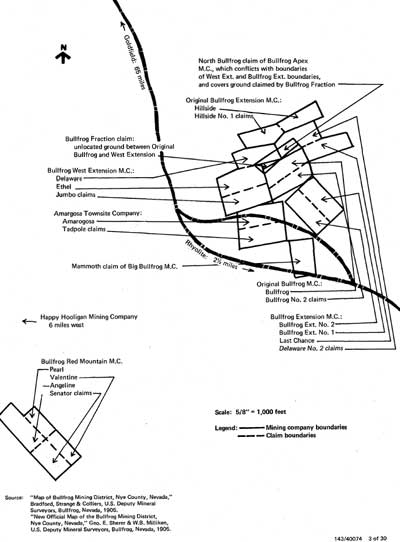
|
| Illustration 17. Sketch Map, Bullfrog claims, 1905. |
The promising developments at the Bullfrog Extension were halted by the San Francisco earthquake and fire in mid-April of 1906, and the mine was idle from then until June. Even though stock in the company was selling at its all-time high of 13¢ per share in late June, work was again halted for unknown reasons, and was not resumed until late October. By the end of 1906, although the company was still delving for ore, no significant discoveries had been made. Still, the company readily paid its county taxes of $24.86, assessed on personal property consisting of a 25-horsepower gas hoist, a twelve by sixteen-foot frame engine house, and a small office building, one ore car, and miscellaneous tools. [24]
Developments continued during the first part of 1907, as the company vainly attempted to find traces of the Bullfrog ore on its property. For a few months, prospects looked good, as described in the Bullfrog Miner on March 29th. The Bullfrog Extension, it reported, was "sinking at the rate of two shifts a day on a practically sure thing." Stockholders shared the optimism of the company and the newspaper, as the price of Bullfrog Extension stock was still holding at 12¢ per share in April. The panic of 1907, however, which hit the Bullfrog district in the fall, had a decided effect upon the fortunes of the company. The stock, after dropping from 12¢ to 5¢ in one month, had completely disappeared from the trading board by October. For a mining concern heavily dependent upon stock sales for operating cash, this was a disastrous blow.
The company rallied, however, and on November 1st announced an assessment of 24¢ per share of stock, payable to the secretary by December. Stockholders were thus faced with the choice of paying 2¢ a share more into the company treasury in an attempt at saving a mine whose stock was then worthless, or of forfeiting their shares to the company. (Assessment was illegal in Nevada, due to many past abuses, but the Bullfrog Extension was incorporated in Arizona, a more permissive state.) The assessment was partially successful, for the company was able to raise enough cash to pay its 1907 taxes--although they were paid late--but not enough was collected to pay for any future development works. The mine lay idle throughout 1908, and the company was forced to call for another assessment of 14: per share in December of that year. This time so few stockholders responded that the company was not able to pay its taxes, and the property of the Bullfrog Extension Mining Company entered the county's delinquent tax rolls [25]
In 1909, one last attempt was made to revive the fortunes of the Bullfrog Extension. This time the owners had no hope of raising enough cash to operate on their own, so in June of that year they advertised in the hope of attracting lessees. It would seem strange that the Bullfrog Extension would still be attempting to develop a mine in 1909, since the Original Bullfrog--the catalyst of the district--had already died. The neighboring West Extension property, however, was uncovering good ore, so the Bullfrog Extension changed its emphasis, and advertised its potential as a neighbor of the West Extension, rather than as a neighbor of the Original Bullfrog.
The advertisements were successful, and the property was leased in October. The new promoters then advanced a scheme which was absolutely fantastic, even for the Bullfrog district. The lessees incorporated not one, but three separate leasing companies, each of which had a lease on a different section of the Bullfrog Extension ground. The promoters then placed a long and confusing advertisement in the Rhyolite Herald attempting to explain their scheme. Potential stockholders were invited to invest in each of the three companies, which jointly held a three-year lease to the Extension property. Although the leasing companies were incorporated separately, they would then develop the Extension mine on a combined basis. As an extra added bonus, the purchasers of the first 50,000 shares of stock in each of these companies would receive, "free of cost," an equal number of shares in the Bullfrog Extension Mining Company--a promotional gimmick of no real risk, since Bullfrog Extension stock had been worthless for two years by this time.
The leasing scheme, as fantastic as it was, enabled the company to raise enough cash to hire a miner to do the annual assessment work on the Bullfrog Extension property, and to pay the 1909 county taxes of $18.00. Too few investors, however, could be fooled all the time, and the leasing companies folded before doing any work. The property was idle throughout 1910, although the company still retained enough cash to pay for the annual assessment work and the $18.00 in county taxes. By September of 1911, the company had finally given up hope, and the gas hoist and gallows frame were dismantled from the Bullfrog Extension property and shipped to Rawhide, for installation on a promising mine in that district. It was a very typical fate for mining equipment, buildings, tools, and anything else of value in a dying mine. [26]
b. Big Bullfrog Mining Company
Located in the south of the Original Bullfrog, this mine had its inception in August of 1904, when "old man" Beatty, a local small-time dry rancher for whom the town of Beatty was named, located the Mammoth claim. Beatty soon sold out to a group of San Francisco financiers, who incorporated the Big Bullfrog Mining Company in 1905. The company owned just the one claim, but nevertheless formed the usual organization, with 1,000,000 shares of stock, par value $1. Developments commenced, and by the end of 1905 the company boasted of a 16-horsepower hoisting engine, and a 2-horsepower blower engine for the ventilation of its 120-foot shaft. The company was described as "exhibiting good ore" in a Rhyolite newspaper, whatever that meant.
Developments continued on an optimistic level in early 1906, as the company succeeded in finding some ore which assayed as high as $180 per ton. Stockholders, on the basis of this discovery, offered to sell. their stock for 14¢ a share, but no one was willing to buy. In March the company announced that it had uncovered a body of milling grade ore worth $14 a ton. Excitement mounted, since $14 ore was enough to make the Big Bullfrog a paying proposition, provided that great care and economy was taken, and that the ore deposits proved to be massive enough to warrant a large-scale operation.
In April, however, the San Francisco disaster drastically undercut the fortunes of the Big Bullfrog Company. The superintendent halted work at the mine when he learned of the calamity, and did not resume operation until the middle of September. The company then reported that "satisfactory progress" was being made through October and November, but no more ore bodies were found. At the end of 1906 the company held assets of one 16-horsepower engine, an engine house and gallows frame, several ore cars, and mining tools, for which it paid $29.32 to the county in taxes. [27]
The Big Bullfrog Company opened 1907 with a flair of development work, sinking its shaft to the 250-foot level, and opening up two ledges, with "fair values exposed." By March, however, the flair had definitely fizzled, for as the Bullfrog Miner wrote, the mine had "no material values." "Last week work was suspended for unknown reasons," continued the paper, as if the absence of any paying ore was not reason enough to close the mine. Stock in the mine slowly settled to 14 a share, and then disappeared from the trading board altogether, as it became evident that the mine would never again reopen. The Big Bullfrog had breathed its last, and with the exception of annual assessment work done in January of 1908, no further word was heard from another failed venture. [28]
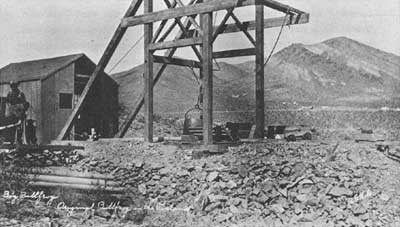
|
| Illustration 18. The Big Bullfrog Mine in November of 1905. Note the gallows frame, the ore bucket, and the engine house. The dumps of the Original Bullfrog Mine may be seen between the legs of the gallows frame, and a few tent buildings of Amargosa are just to the left. Photo courtesy of Nevada Historical Society. |
c. Bullfrog Fraction
In December of 1904, Len P.: McGarry, mining promoter, stock dealer, and president of the Bullfrog West Extension Mining Company, noticed that the ground claimed by his company did not coincide with the boundaries of the Original Bullfrog. Between the Bullfrog claim of the Original Bullfrog company and the Delaware and Ethel claims of the West Extension, there lay a parcel of land, 1.7 acres in all, which was unclaimed. McGarry immediately located and recorded this ground as the Bullfrog Fraction claim. Then, interestingly enough, he sold it to outside mining promoters instead of selling or deeding it to his own company. Although this would seem to be a clear conflict of interests, such moves were not that unusual in the cut-throat business of mining.
Fractional claims are the bane of miners, and the delight of lawyers, and this one was no exception. Hardly had the new owners started to work, when their claim was disputed by the owners of the Bullfrog Apex Mining Company, owners of the North Bullfrog claim, whose boundaries conflicted with those of the Fraction, as well as those of the West Extension and the Bullfrog Extension. When the Apex company filed for a patent to the North Bullfrog claim in May of 1906, both the West Extension and the Bullfrog Extension filed adverse actions against the granting of the patent. Then, when high grade ore was found on the Fraction claim in June, matters got even more serious. For a while, the big companies tried to settle the matter by furiously working the ground in question, with the Bullfrog Fraction caught hopelessly in the middle. Then, in July, the West Extension and Bullfrog Extension both filed suit in court against the Bullfrog Apex Company, and a long legal battle ensued. The Rhyolite Herald correctly surmised that the struggle would be lengthy and costly for all concerned. "If they fight it out someone is bound to lose, while all will be put to great expense," wrote the editor. "Think it over, gentlemen, think it over."
The gentlemen involved, however, had already thought it over as much as they wished, and during the remainder of 1905 and for most of 1906, the case wound its way slowly through the Nevada court system. In the meantime, the owners of the Bullfrog Fraction, surrounded by litigants which desired their ground, continued to develop their claim, and continued to find good ore leads. As their claims grew more valuable, and as the court battles grew more involved and more expensive, it became clear to them that they could no longer protect their claim by themselves. Accordingly, in November of 1906, they gave up and sold the Bullfrog Fraction to the West Extension Company. That company in turn incorporated the West Extension Annex Company to develop the Bullfrog Fraction claim, and began to operate the two mines as one.
The Bullfrog Fraction thus disappeared as a separate mine, and became part of the West Extension holdings--where it would originally have been had the president of the West Extension, Len P. McGarry, seen fit to benefit his company rather than his pocketbook two years previous. As a bonus to the West Extension, and as a great aid in its fight against the Apex, the Bullfrog Fraction was granted a patent (which had been applied for by the previous owners) in March of 1907. [29]
d. Bullfrog Apex Mining and Milling Company
The Bullfrog Apex Mining and Milling Company was incorporated on August 4, 1905 by a group of promoters headed by J.J. Fagan and E.L. Andrews. The incorporation was a rather typical one, listing capital stock of 1,000,000 shares, par value $1 each. The company listed itself as the owner of 15 claims, only one of which was ever worked--the North Bullfrog. There was only one problem with the North Bullfrog claim: it intruded into the boundaries of the Delaware claim of the West Extension Company, the Delaware 4$2 claim of the Bullfrog Extension Company, and completely covered the small parcel of ground known as the Bullfrog Fraction.
As events were to prove, the organizers of the Apex Company knew about these conflicting boundaries when the North Bullfrog claim was filed, but they forged ahead anyway., hoping to capitalize upon a few technical mistakes committed by the other companies.. Work on the Apex ground started in the fall of 1905, and soon all the competing companies were sinking shafts within a stone's throw of one another. The original Bullfrog shaft was the focal point, with the Apex Company sinking only forty feet away from it, the Bullfrog Extension working on the east, the Bullfrog Fraction on the west, and the West Extension to the west of the Bullfrog Fraction.
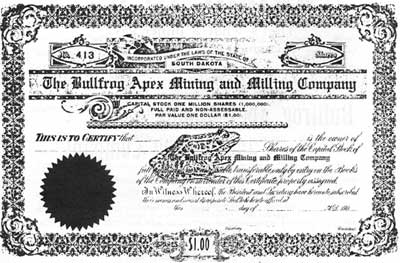
|
| Illustration 19. Stock certificate. Courtesy Nevada Historical Society. |
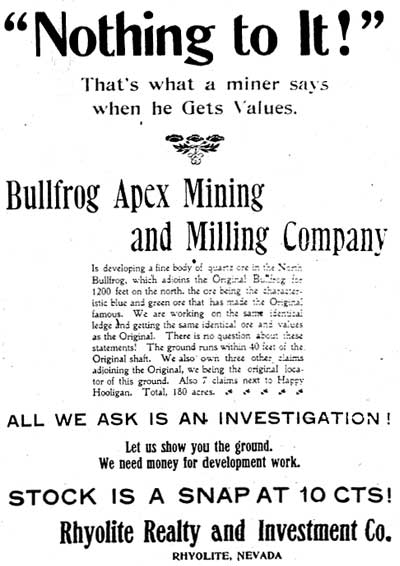
|
| Illustration 20. Advertisement from the Rhyolite Herald, November 10, 1905. |
The development race between these companies continued through the early part of 1906. The Apex encountered encouraging ore values, stock sales were adequate at 114: per share, and the promoters were confident enough of the mine's prospects that they decided to apply for a patent. That, however, was the move which spelled the end of the mine. When the Apex filed its papers for patent, the local newspapers, as required by law, published the legal description of the claim boundaries. When these were published, the West Extension Company immediately realized that the Bullfrog Apex was attempting to patent land which the West Extension had a prior location to, and it filed an adverse action against the Apex application, and then filed for its own patent. [30]
While the patent applications and adverse suits were slowly winding their way through the jurisdiction of the U.S. Land Office at Carson City, both companies continued to sink development shafts and tunnels, trying to find the elusive ore bodies, and determine if there was anything underneath the ground worth fighting for. When the Apex Company uncovered a vein of gold assaying $251 to the ton, the question was settled, and the legal battle intensified. The Bullfrog Extension had by now realized that the Apex patent also infringed upon its ground, and filed a second adverse suite against it. At about this time, the struggle was elevated from the Land Office to the civil court system of Nevada.
Law suits, then as now, took time, and in the meanwhile all the companies involved continued to develop their mines. At the very least, the company which lost the suit hoped to extract the best ore from the ground before the case was ever heard, thus minimizing its losses. By October, the Bullfrog Apex realized that the West Extension was winning this particular race to gut the contested ground, and managed to obtain a writ of claim and delivery, stopping the West Extension from shipping high grade ore from the mine until the suit was settled.
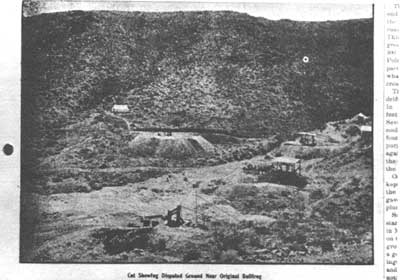
|
| Illustration 21. Photo from the Rhyolite Herald of July 27, 1906, showing the location of the ground in dispute between the Bullfrog Apex, the West Extension, the Bullfrog Extension, and the Bullfrog Fraction. The shaft and windlass at the bottom of the picture are on the property of the Original Bullfrog; immediately above it can be seen the circular dump of the Apex; the right-center workings are on the Bullfrog Fraction; and the right-top workings belong to the West Extension. The ground in dispute between the Apex and the Bullfrog Extension is off to the right, out of the picture. |
When the first hearing of the case took place, in the local Rhyolite court on October 9th, the judge soon realized that the case was too complex for him, and transferred it to the district court at Tonopah. The move meant higher legal costs to all parties involved, but it also meant more time to exploit the mines while awaiting results. But by this time the Apex was running into trouble. The great publicity surrounding the court suit was taking its toll upon the company, for the Apex was a relatively unheralded company, compared to the well-known West Extension and the less famous Bullfrog Extension companies. As a result, the stock of the Apex, which had been selling at a high of 11¢ per share in May of 1906, fell completely off the trading board within a few weeks of the announcement of the legal suits. Strapped for money to proceed with either the development of its prospect or the long legal battle, the Apex took its case to the people, in the form of a long newspaper advertisement. The appeal, however, seemed to have little effect, for Bullfrog Apex stock did not reappear on the market. [31]
As 1906 gave way to 1907, conditions remained much the same. The case slowly ascended the court calendar in Tonopah, and the West Extension, Bullfrog Extension and Bullfrog Apex companies continued to develop their respective portions of the disputed ground. By this time the West Extension Company had increased its stake in the affair, through the purchase of the Bullfrog Fraction ground, which effectively doubled the amount of land at dispute between it and the Apex. On February 8th, the case was finally heard in the district court at Tonopah, and the opposing factions were given another thirty days to file final briefs.
Finally, during the first week of May, the Tonopah court rendered its judgement. The ground known as the Delaware claim of the West Extension, and that known as the Bullfrog Fraction, the court announced, had been located and recorded properly prior to the location of the North Bullfrog claim of the Bullfrog Apex Company. Thus, despite the contentions of the Apex attorneys that the former claims had been allowed to relapse, the court found that such was not the case, and ruled entirely in the favor of the West Extension and Bullfrog Extension companies. The West Extension gleefully placed a full page ad in the Bullfrog Miner,, announcing that title to its ground was now uncontested. The Bullfrog Apex was left in the cold--its claim to the North Bullfrog ground was completely invalidated.
Although the Apex Company owned other property, such as seven claims near the Happy Hooligan, six miles to the west of the Original Bullfrog, the company had exhausted its treasury through its hectic development of the North Bullfrog claim, and through the legal costs of the court suit. Now, with no more money to pursue further mining, and with the utter loss of public confidence prohibiting the sale of further stock, the Bullfrog Apex Mining and Milling Company quietly closed its doors and went out of business. The company had taken a calculated gamble and had lost. [32]
e. Original Bullfrog Extension
On April 13, 1905, a group of five hopeful promoters incorporated yet another Bullfrog mine, this one called the Original Bullfrog Extension Mining Company--not to be confused (except perhaps by investors) with the Original Bullfrog or with the Bullfrog Extension. The Original Bullfrog Extension was the owner of two claims called the Hillside and Hillside #1, which were situated directly north of the Delaware claim of the West Extension Company arid the Delaware 42 claim of the Bullfrog Extension, respectively.
Despite the close similarity of names, the Original Bullfrog Extension was neither an "original" nor a true extension of the Original Bullfrog. That in itself was no great problem, but when potential investors figured out that the Original Extension was separated from the Original Bullfrog by the claim of the West Extension and the Bullfrog Extension, the company failed to attract much interest, and its stock was never placed on the trading boards. Nevertheless, the company went to work, with the forlorn hope that either the rich Bullfrog ledge would dip entirely through the intermediate properties and enter its ground, or that they would have the great luck of finding a separate ledge upon their own ground. By the end of 1905, pursuing these hopes, the Original Bullfrog Extension had sunk a shaft to a. depth of one hundred feet, and had equipped its property with a horse whim for raising the rock. [33]
The company continued its development work through the early part of 1906, but without much luck. Neither the Bullfrog ledge nor any other ledge appeared on its property. Then, in April, the Original Bullfrog Extension temporarily shut down work, while its superintendent traveled to San Francisco to learn the effects of that city's recent disaster upon the company's finances. The mine lay idle throughout the summer, but by September the company had recovered enough to announce that work would soon be started. Soon, however, turned out to be a long time coming, and work did not resume at all that fall. In December, with the property still laying idle, the company gave up the hope of developing the mine on its own, and advertised for a contract to sink fifty feet in the shaft. The advertisement described the company's property as being equipped with a 155-foot deep shaft, a good whim and a blacksmith shop. The company offered to provide the contractors with timbers for the shaft and with tools for mining.
The contract was let, and by March of 1907 had been completed. No ore was found, however, and the Bullfrog Miner was forced to admit that "nothing of importance has thus far developed" at the Original Bullfrog Extension. Nevertheless, the company continued to work through April, before finally giving up hope. Throughout the rest of 1907 and most of 1908 the property was dormant, with only the minimal necessary annual assessment work being done. In 1909, however, even the assessment work was not done, which meant that the Original Bullfrog Extension Company relinquished title to its claims. Another Bullfrog mine had died. [34]
f. Bullfrog Red Mountain--Rhyolite Bullfrog
The Bullfrog Red Mountain Mining Company had even less of a claim to the magic Bullfrog name than any of the above mines, for its four claims were situated almost a mile southwest of the Original Bullfrog. Undaunted, the company was organized early in 1905, and started to work, reporting that they had found ore worth $47 per ton. Despite this claim, efforts to develop the mine were not successful. By the time the Red Mountain had organized, approximately seventy-five other companies in the district had already used the Bullfrog name, with a noticeable cheapening of its value in attracting investors. This, along with the remote location of the mine, made it evident to any half-way careful speculator that the Red Mountain outfit had absolutely no hope of cashing in on the Original Bullfrog ledge, and just as remote a chance of finding another ledge of its own. As a result, although the Bullfrog Red Mountain announced the usual incorporation of 1,000,000 shares worth $1 each, the stock never hit the trading boards.
Before the company had really got work off the ground, the San Francisco disaster cut off operations. The mine was idle through the rest of 1906, even though it did take the public relations step of announcing that Sam Newell, superintendent' of the Original Bullfrog, had also been appointed as superintendent of the Red Mountain. Unfortunately, Newell had nothing to supervise, and nothing happened.
Then, in early 1907, the mine was sold to a new group of promoters, and the cycle started all over again. The new owners, led by two men named Voorhees and Taylor, decided to reincorporate and change the mine's name, hoping thus to sever all connections in the investors' minds with the losing predecessor. Since Voorhees and Taylor were two of Rhyolite's leading stock promoters and brokers, the new company had all the benefit of their experience and connections. From January to April, the Rhyolite newspapers carried weekly descriptions of the reorganized mine, thus keeping it in the public's mind, even though no work was being done. Finally, on April 6th, the new company incorporated itself as the Rhyolite-Bullfrog Mining Company, capitalized as usual for $1,000,000 and with the grand total of $1,003 in the treasury. [35]
With a newly incorporated company and with money in the treasury, the Rhyolite-Bullfrog Company underwent a flurry of development work. Camp buildings were completed in early October, including a boarding house, stables, blacksmith shop and a superintendent's office. Sinking was resumed by three shifts of miners, $10 ore was reported, and the company cleverly circulated the rumor through the newspapers that it had a good treasury reserve, in an attempt to bolster investor confidence. The papers were full of encouraging news carefully planted by the skillful[ stock brokers running the company. During the fall and winter of 1907 reports of $23 ore, "solid values", "promising" finds, and surface showings "the best in the district" appeared almost weekly. Then, suddenly, with the end of 1907, all work ceased. Despite all the promotional gimmicks, the mine was not attracting investors.
Through the entire years of 1908 and 1909, little work was done at the Rhyolite-Bullfrog, even though the company did display ore samples at the American Mining Congress convention in Goldfield in the fall of 1909--another good promotional stunt. That was the company's last gasp, however, and the mine lay idle through 1910 and 1911. Finally, in March of that year, the company's four claims were sold at auction by the Nye County sheriff, under a writ of execution brought by two disgruntled stockholders who wished to recover their ill-spent funds. The two men received title, to the mine for their efforts, and even tried a little prospecting work on their own, but the Rhyolite-Bullfrog, nee the Bullfrog Red Mountain, soon died an untroubled death. The venture had proved once again that even the very best of promotional campaigns could not save a mine which had no ore. [36]
Such were the varied fortunes of those who tried to find success in the shadow of the Original Bullfrog strike. As noted before, the above mines were the more honest of the many which carried the Bullfrog name, for they at least tried to find ore on 'their grounds. In this sense, they gave their investors a better run for their money than did the promoters who merely took stockholder's funds and ran. In the end, however, all came out equal, for no one made any money, and some merely lost it more quickly than others.
Had things, been different--had the Original Bullfrog been another Comstock--these surrounding mines could have made fortunes. That was what the promoters and stockholders had' bet upon, but as the twists of fate and geologic formations would have it, the Original Bullfrog itself turned out to be a low-grade proposition, despite the early finds of rich pockets of gold, and the surrounding mines found no ore at all. The early demise of the Original Bullfrog thus spelled doom for all the neighboring tadpoles, but such is the nature of the mining game. You pay your money and take your chances. The story of these mines is important, though, for they are typical tales which are repeated again and again in all the camps of the western mining frontier.
g. Present Status Evaluation and Recommendations
Due to the limited nature of the activities which took place on the property of these various mines, comparatively few structures were ever erected. Only a few of the mines had hoists or gallows frames, as most did not pass the windlass or whim methods of raising ore. Likewise, most of the mines never employed enough miners to warrant the construction of boarding houses or similar buildings. And, since all these mines failed before the general exodus of the Bullfrog district took place, the few improvements and structures located at their sites were immediately salvaged for use elsewhere, in the time-honored manner of desert mining, where wood was always a scarce commodity.
As a result, there are no structural remains at any of these mines. The only clues to past activities are the numerous pits, prospect holes, adits, and shafts which dot the landscape around the Original Bullfrog. The limited remains of these limited mining efforts are not of National Register significance.
Interpretive signs, which would point out the location of these mines, and briefly tell the story of their vain attempts to cash in on the Bullfrog bonanza, would be of historical interest and educational value to the visitor. Unfortunately, in the history of man's efforts to extract wealth from the earth, the failures of small-scale mines such as these are far more typical than is the small percentage of mines which actually made money.
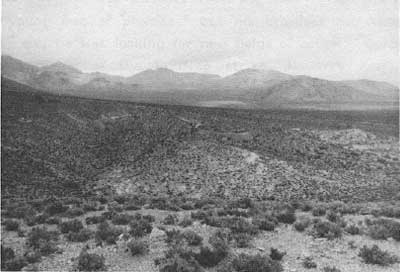
|
| Illustration 22. Dumps of the Bullfrog Extension Mine, looking southeast from the Original Bullfrog, may bee seen in the center and left-center of the picture. These lonely scars are typical of the only clues remaining to tell the story of feverish attempts to cash in on the glory of the Bullfrog bonanza. 1978 photo by John Latschar. |
4. Bullfrog West Extension Mine
a. History
While Shorty Harris was drinking in Goldfield in celebration of the discovery of the Original Bullfrog mine, he met an old acquaintance named Len P. McGarry. McGarry had been born in Eureka, Nevada, and had spent his entire life in the mining state, cutting his eye teeth on the rushes to Tonopah and Goldfield. He was the sort whom the local newspapers described as a "young man of promise," but his promises had temporarily run out, and he was looking for new fields of action. Quickly realizing the potential of the Bullfrog strike, McGarry reestablished his friendship with Shorty, and accompanied him back to the scene of the strike. There, on August 26, 1904, McGarry staked out some claims to the immediate west and north of the Original Bullfrog.
For a while, McGarry became sidetracked from mining, as he was one of the first investors and promotors of the Bullfrog townsite. His claims were recorded, but were not worked for over a year. But when the Original Bullfrog Mine started shipping its pockets of high-grade ore in 1905, McGarry regained interest in his claims, and went looking for financial backers. By December his search was successful, and on the 7th of that month the Bullfrog West Extension Mining Company was incorporated, with McGarry as president. Although the incorporation was very typical on paper, with 1,000,000 shares of stock listed at a par value of $1 each, the company decided to retain the majority of the stock, and sold a mere 125,000 shares, at 12-1/2¢ each, in order to raise the initial development fund. Stock sales were brisk, due to the location of the company next to the Original Bullfrog, and the West Extension was soon ready to begin work. [37]
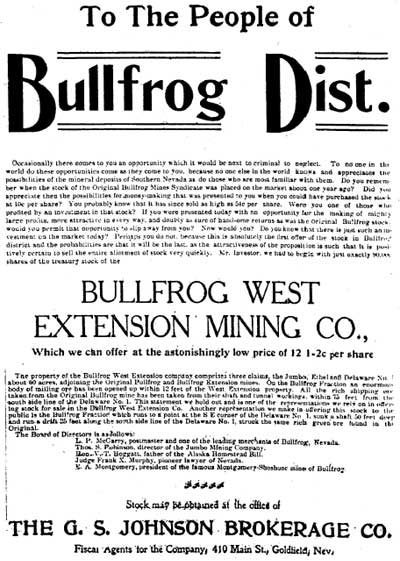
|
| Illustration 23. Advertisement from the Rhyolite Herald, October 27, 1905. |
From the very beginning, the West Extension had better chances of intercepting the Bullfrog ledge upon its property than any of the other Bullfrog tadpoles, simply because it was the last to begin active operations. By the first of 1906, most of the mines surrounding the Original Bullfrog were showing signs of failure, and the Original itself had lost the rich ore ledge which had stimulated the first glory days. By process of elimination, this meant that if the Bullfrog, ledge went anywhere, it had to go through the West Extension property. The company followed this philosophy, and began sinking its shaft at the likeliest point.
By May of 1906, after only a few months of exploration work, the West Extension seemed to discover the first signs of the Bullfrog ledge, and the local newspapers duly reported the presence of "fine ore" in the company's shaft. Unfortunately, this was, the exact time at which the West Extension discovered that the Bullfrog Apex was encroaching upon its ground, and the long and costly legal struggle, described above, began. Nevertheless, the West Extension carried on, and began taking out high-grade ore, worth up to $200 per ton, to be sacked for, future shipment.
Within a few months, the early indications seemed proven, and in July the company's directors decided to withdraw the stock from the trading market, in order to capitalize upon the future profits of the mine themselves. With the mine reporting ledges averaging $50 per ton, with some rich pockets running as., high as $2,670, the decision seemed fully justified. For another two months the company explored, results continued to be encouraging, and in September the decision was made to shift from exploratory mining to development on a larger scale. A $5,000 hoisting plant was ordered, consisting of a 25-horsepower Fairbanks-Morse engine, a four-drill capacity air compressor, and accessories. Len P. McGarry, who was acting as superintendent of the mine, as well as president of the company, increased the work force to ten miners. In answer to inquiries from eager investors, the company announced that it had ample funds to pay for the escalated development plans, thank you, and that none of the company's stock would be offered for sale.
Despite the continuing annoyance of the law suit versus the Bullfrog Apex, which among other things prevented the West Extension from adding to its treasury by shipping the high-grade ore, the company forged ahead. The big new hoisting plant arrived in late October and was soon installed and working. The Bullfrog Fraction claim was purchased and the West Extension Annex company was formed to exploit it. By this time the growing West Extension complex looked so strong to local and state investors that when the company announced that it would sell 150,000 shares of the Annex stock at 15¢ each, over 50,000, shares were purchased in two weeks--despite that fact that 15¢ per share was an exorbitant price for stock in a company that had not yet commenced mining. As 1906 came to an end, the West Extension looked like one of the best properties in the Bullfrog district, even though title to some of its land was still a matter of dispute. [38]
The mine continued to prosper in early 1907. Another shoot of rich ore, assaying up to $900 per ton, was opened in January, and more encouraging discoveries were made the following month. The Bullfrog Miner, after describing the latest strike in its February 22d issue, concluded that even though the "West Extension is only a baby as yet," it was. "unquestionably" the "finest piece of goods" in the district.
Although the West Extension might be considered a baby, it had already spawned one subsidiary in the West Extension Annex company, and another soon followed. In March, the claims of the Bullfrog Teddy group, which joined those of the West Extension, were purchased, and. the Bullfrog Teddy Gold Mining Company was organized. The officers and directors of this company were identical to those of the West Extension, and the promotion of the company soon began. The Teddy, the advertisements read, would be developed to catch the West Extension ledge, just as the West Extension had caught those of the Original Bullfrog, and the public was invited to share in the undoubted success of the venture. Response was again satisfying, with 140,000 shares of Teddy stock sold in March, and by April the price of the stock had risen to 16-1/2¢ per share. Obviously, investors who were frozen out of the West Extension, since it was operating as a closed corporation, were more than anxious to get in on its neighboring prospects. After all, the West Extension had good ore reports, its neighbors probably would also, and all three companies were under the same management. Len McGarry, for example, was the president of the West Extension, the West Extension Annex, and the Bullfrog Teddy, and would also be the superintendent of all three mines. In addition, Bullfrog Teddy and West Extension Annex stock was available for purchase from the office of the L. P. McGarry Brokerage Company of Rhyolite, Nevada.
Things were going so well for McGarry that he even ordered a hoisting plant for the Teddy, before active developments commenced. His luck held. During the next few weeks the West Extension found more ore, some assaying up to $264 per ton, and the Teddy found a ledge averaging $26.40. McGarry publicly offered to buy back the stock of the West Extension from anyone who had. been lucky enough to purchase it the last fall, but no one seemed willing to sell. When the board of directors of the company held its first annual meeting on March 15th, the directors were so impressed with McGarry's reports that they voted once again to keep West Extension stock off the trading board. This decision meant that the directors would have to finance development work on their own, but that seemed to be no problem, as the papers reported that $50,000 was raised in fifty seconds. [39]
By this time the West Extension properties were becoming famous throughout Nevada, and Len McGarry granted an interview to a reporter from the Reno Journal. The mine, he said, had rock averaging $20 per ton throughout its workings, more than enough to support a mill upon the site, and had encountered pockets and streaks of free gold, one of which assayed at $10,000 per ton. By the end of March the hoisting plant for the Teddy had arrived, the two shifts of miners at the West Extension had piled over a hundred tons of high-grade ore on the dump, and McGarry announced that the mine had thousands of tons of milling grade rock in sight. Again, rumors of a proposed milling plant were circulated.
Another strike of $99 ore was made at the West Extension in April, and the Teddy completed the installation of its hoisting plant and a blacksmith shop. Then, in May, the big news came. The West Extension won its suit against the Bullfrog Apex, and Was finally free to develop its mine unmolested, and to ship its high-grade ore, which was sacked and ready on the dump. Strangely enough, however, the company did not ship. Instead, development work went along as usual for another month, and then the mines were suddenly shut down. The company announced the reason for work stoppage as being the need to thoroughly survey the mines, in order to draw up final development and production plans, and to come to a decision regarding the construction of a mill. The shut-down, McGarry assured the papers, was only temporary. Holders of Bullfrog Teddy stock, however, were not fully convinced, and the price of the stock plunged to 3¢ per share. [40]
The mine was idle until the end of August, when the company announced its new plans, based upon the recommendations of several mining engineers who had inspected the ground during the shut-down. Once the decisions were reached, the mines reopened, work resumed and progressed satisfactorily throughout the fall, despite the effects of the panic of 1907. By December the owners announced that they had $195,000 worth of ore blocked out in the mine, and the directors again contributed more cash to finance the work. Again, rumors circulated through the newspapers concerning the erection of a milling plant for the West Extension. But despite all these indications of success, something was wrong with the finances of the company. The 1907 county property taxes were not paid on time, and for the want of $46.20 the property was listed on the delinquent list for several months.
In January of 1908, the West Extension executed another suspicious move, when that company bought out the stock of the Bullfrog Teddy. Although this would seem to be a meaningless move on the surface, since the two mines were already operating as one, it made a difference to stockholders of Teddy stock. The merger was quick, and the stockholders were helpless to prevent it, since the major stockholders and directors of the Bullfrog Teddy were one and the same with those of the West Extension. The real effect was that Bullfrog Teddy stock immediately became worthless, and according to the dictates of the directors, holders of it were forced to exchange it for stock in the West Extension at a ration of four to one. Bullfrog Teddy stock had last sold for 64: per share on the Rhyolite exchange, so for the stockholders to come out even West Extension stock would have to be worth at least 24¢ per share. But since West Extension stock was untraded, no one knew for sure what it was worth, except the directors of the company. In summary, the dealings of a company which formed a subsidiary, sold stock in it, and then absorbed that company and forced stockholders to exchange their stock for one of unknown value, were suspect.
In order to bolster the confidence of the suspicious stockholders, the West Extension announced at the same time that it was planning to construct a reduction plant at Gold Center, where ample water supplies were available; and that new financial backers had pitched their lot with the West Extension, including John Campion of Leadville, Colorado, and Fred Bonfils, one of the owners of the Denver. [41]
Hardly had these grand organization and building plans been announced, than another peculiar event took place. During the second week of February, the West Extension granted an eighteen-month lease to a pair of miners, for mining rights on a portion of the Delaware claim--the same claim for ownership of which the company had been willing to fight the Bullfrog Annex. Ordinarily, a company which had ample capital and a promising mine, which the West Extension claimed to have, would never lease a portion of its property, since the employment of lessees cut down on the potential profit of the mine. Yet the West Extension, which had never looked better, according to the reports it released to the Rhyolite newspapers, was doing just that. No one seemed to question why. The lessees, however, were not about to look a gift horse in the mouth, and immediately incorporated themselves as the West Extension Leasing and Milling Company, and went to work.
By the middle of March, the plans of the company changed once again. This time, the West Extension announced that it had reached an agreement with financiers from Salt Lake City and Chicago relative to the construction of a mill. In return for the West Extension's guarantee to deliver 20 tons of milling ore per day for one year, the financiers announced plans for the construction of a custom reduction mill at Beatty. At the same time, the West Extension also announced that the U.S. Government had approved its patent application for the Delaware, Ethel and Jumbo claims. Following these announcements, development proceeded at the mine, and the company shortly reported the location of another ore body, this one assaying as high as $800 in spots, with average values throughout of $40.
The company now had three shifts working its mine continuously, and began to stope the best ore for future milling operations. The mine superintendent reported that he could extract forty tons of milling grade ore per day without untoward effort. The major stockholders and directors of the mines continued to be impressed with its prospects, and once again raised $50,000 among themselves during the annual meeting on March 28th.
More strikes were reported in April, as the mine continued to find good ore. Assay reports differed from week to week, but it was undeniable that the West Extension had sufficient ore to support a mill. Work started on the custom mill at Beatty, and the construction superintendent estimated that the 10-stamp complex would be ready to accept ore in ninety days.
Work was "pushed night and day" as April gave way to May. The company announced that the average ore throughout the mine assayed from $22 to $30, which would make the West Extension one of the richest mines in the Bullfrog district, were it true. Yet at the same time that the company was making final arrangements for the milling and production of its ore, it also inexplicably let another lease on its property, for the duration of one year. [42]
As the summer progressed, developments continued. The West Extension worked its ten miners in two shifts during these hot months, and announced plans to raise the payroll to thirty--which was not done. The papers continued to announce good ore finds in the mine, and the lessees also reported good luck, one of them sacking thirty sacks of high-grade ore within the first month of operation. A constant stream of visitors inspected the now-famous mine, and all came way murmuring that they were impressed. But, on June 1st, an event occurred which the West Extension company did not report to the friendly papers, for the summer installment of county taxes on the Bullfrog Teddy property was not paid.
In August, the company announced that it had already had over $50,000 worth of milling ore stacked on the dump, awaiting the completion of the custom mill at Beatty, and that it had the capacity to deliver up to forty tons of ore to the mill per day.
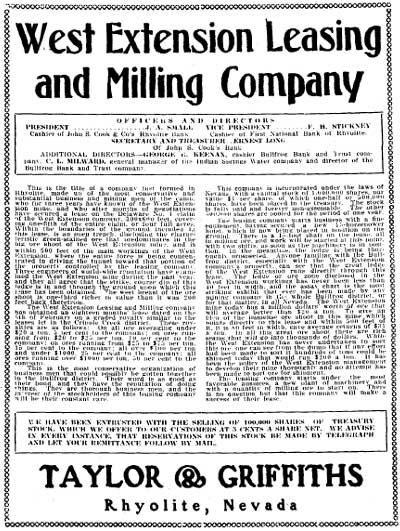
|
| Illustration 24. Advertisement for the leasing company operating on the West Extension property. From the February 1908 issue of Death Valley Magazine. |
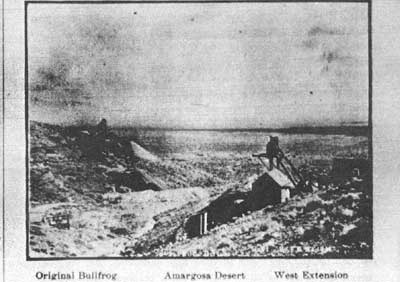
|
| Illustration 25. The West Extension Mine, looking east-southeast towards the Original Bullfrog, shows the close proximity to the two. Photo from the Rhyolite Herald, March 22, 1907. |
The company also announced an agreement with the Las Vegas & Tonopah Railroad, whereby an 850-foot spur would be built to the mine. In return the West Extension guaranteed to ship thirty tons of ore per day via the railroad at a cost of 60¢ a ton--a substantial reduction of the usual freight rate.
Towards the end of August, however, hitches began to develop in company's plans. The mill promoters announced delays in construction, due to difficulties in obtaining machinery and parts, and the West Extension, with time and money running out, began to negotiate with the Montgomery-Shoshone Mill about the possibilities of getting its ore treated there. In September, with the Beatty custom mill still far from complete, the West Extension finally made its first shipment of ore, twenty-five tons worth an estimated $2,000, to a smelter at Murry, Utah. After over two years of development and promotion, the West Extension had belatedly entered the list of Bullfrog producers. [43]
As October went by, the Beatty custom mill still showed no signs of an early completion date. The impatient West Extension directors held more talks with the Montgomery-Shoshone Company, but no agreement was reached. Negotiations were also initiated with the Bonnie Claire Mill, approximately twenty miles north of Rhyolite, but again the results were unsatisfactory. The West Extension therefore decided to attempt to build its own mill, at the mine site, and began preliminary surveys for a water pipeline from Rhyolite to the mine.
Even though a decision to build a mill meant that the West Extension would need more money than ever, the company also decided not to ship any more ore, preferring to wait and run it through its own mill in the future. The company also decided once again to avoid selling West Extension stock to raise money, and the directors met in Utah with their Colorado partners to iron out the details of the financial campaign. The results of that meeting were evidently satisfactory, for after the surveyors reported that water could be piped from Rhyolite to the mine site, the company announced that it would definitely build a mill. During the latter part of November, survey teams inspected the area around the West Extension mine, prior to selecting the best site for the mill.
Several mill machinery companies were invited to submit plans for the mill, and alternate proposals soon came rolling in. Since the mine had sufficient ore on the dumps for several months of mill supply, and more in the mine ready to hoist to the surface, the underground miners were laid off, until final details for the future of the mine and mill could be reached. Towards the end of December, 1908, the company tentatively agreed to mill plans submitted by the Joshua Hendy Company of San Francisco. The plans called for the erection of a 10-stamp mill, with treatment by stamp crushing, followed' by plate amalgamation, the "perfect" system of concentration and final treatment by cyanide lixiviation.. The plant was to be powered by electricity, and the Hendy Company estimated that it would take four months to build. Final contracts for the construction of the mill awaited only the official approval of a meeting of the full board of directors.
Thus, as 1908 ended, the West Extension appeared to be poised on the verge of becoming one of the Bullfrog district's important producers. Still, with all its promise, signs of financial difficulties continued to appear in the organization. In 1908 the Nye county taxes on the West Extension property were again paid late. Taxes on the Teddy property owned by the company were not paid at all, as the Bullfrog Teddy Mine had been abandoned shortly after the merger of the two companies. Ironically, a United States patent to the abandoned mine was received on January 15, 1909. [44]
During the first months of 1909, the ambiguity surrounding the future of the West Extension did not become any more clear. The directors held their annual meeting on January 30th, and re-elected Len P. McGarry as president of the company. That, however, was the only, definite news release to the press. Although the Rhyolite papers felt "certain" that the mill plans were approved, they were also forced to admit that "Little is being said about the mine proper of late, and it is impossible now to estimate with accuracy its ability as a producer." The silence of the company seemed ominous, since it had always been the first to let the papers know whenever something good was to be reported.
In the meantime, the West Extension Mine lay idle, as the directors tried to figure out what to do next. As January gave way to February and March, the directors still failed to reach a decision, and the mine, with its reported $50,000 worth of ore on the dump, was not touched. Rumors circulated that the Montgomery-Shoshone had taken a lease on the West Extension property, in order to ship its ore to the Shoshone Mill, but nothing happened. During the summer, several independent leasing outfits attempted to secure rights to work the ground, but all were unsuccessful, and the mine still lay idle.
By September of 1909, the West Extension Mine had not been worked for almost a year, and creditors of the company lost patience. A Goldfield legal firm sued the company to recover $2,400 in back fees, and a group of Rhyolite merchants were forced to initiate another suit to recover a paltry $600 in overdue bills. The company, in the meantime, underwent a private reorganization, and G. S. Johnson replaced Len McGarry as president. No reason was given for the change of leaders. Johnson promised payment in full to all creditors, and tried to dampen the unwelcome publicity, but gave no explanations for the recent puzzling lack of action at the mine. Despite Johnson's promises, however, the company's debts were not paid, and the creditors were forced to take the matter to court. The Bullfrog Miner expressed the public's bewilderment at the strange lack of action at the West Extension, for according to the company's reports, it could easily liquidate all debts merely by shipping the ore it said it had ready on the dump. Still, nothing happened.
By the end of 1909, the inevitable result was beginning to become plain for all to see. The last official announcements of the West Extension Company had been full of breathless figures of ore on the dumps, enormous ore deposits in the mine, and plans for a reduction mill. That, however, had been over a year previous, and nothing had been done since. The Mining World assessed the West Extension as a promising property, but "one in which lack of ample capital is holding back work, while absence of milling facilities is keenly felt. Much of the ore on this and other properties is of too low grade to warrant shipping to smelters." The Nye County Treasurer also summed up the situation in his own inimitable way, for when the West Extension failed to pay its 1909 county taxes on time, he immediately placed the property on the delinquent tax list. [45]
By 1910, the West Extension appeared to be a dead mine, but the local folk refused to let it die in peace. Indeed, the entire Bullfrog District was in a decided decline by now, but the stalwart at heart refused to believe. Admittedly, some of the most promising mines in the district had already gone under, but in the eyes of the faithful the Bullfrog District was not yet finished. The lead article in the January 1st issue of the Rhyolite Herald entitled "New Years Dawn Full of Promise," symbolized the optimism of the remaining Bullfroggers. With this attitude, it is a small wonder that the papers would not leave the West Extension alone, for it had been one of the latest mines of promise, and to admit that it had failed would be to admit the same for the entire district. As the above article continued, the West Extension, surely, "will be soon put into shape for production."
Accordingly, every straw was seized at. When a mining engineer from the huge Goldfield Consolidated firm, for example, made an inspection of the West Extension property in June and again in November, the paper hopefully printed rumors of the purchase and re-opening of the mine. Likewise, when the West Extension Company reorganized and reincorporated itself in September, the Herald saw certain signs of the imminent resumption of work. But 1910 ended the way it had begun--no work was done on the property for the second straight year, and the company's taxes were again delinquent. To add insult to injury, the private residence of Len P. McGarry, former president of the Bullfrog West Extension Mining Company, the Bullfrog Teddy Mining Company, the West Extension Annex Mining Company and the L. P. McGarry Brokerage house, was also placed on the delinquent list for the non-payment of county taxes. [46]
As usual, things got worse before they got better. In April of 1911 the West Extension estate was put under the auctioneer's hammer, to satisfy the claims of its creditors, who had won their suits against the company. As the Rhyolite Herald sadly noted, "The Extension is one of the truly bright prospects of the camp, and it is a matter of deep regret that financially it is on the breakers."
Towards the end of the year, however, prospects revived. The Mayflower Leasing Company, a consortium of promoters who were not yet ready to give up on the Bullfrog district, decided to take a look at the West Extension. The Mayflower Company had already had a limited degree of success in combining the ore output from several mines in the district for reduction at the Eclipse Mill, which it owned, and it soon decided that the West Extension could make a contribution towards this effort. In December, the company executed a long-term lease with the West Extension and announced that it would put two shifts of miners at work to extract ore for its mill. Interestingly enough, the Mayflower spokesman gave the Rhyolite Herald a much lower estimate of the value of the West Extension's ore than the figures received from McGarry et. al. in past years. The leasing company's assays showed that the mine had average values of from $12 to $15 per ton, enough to give the company a profit after deducting the foreseen costs of $7 per ton for mining, freightage and milling. The grateful McGarry, who was still listed as the principal owner of the West Extension, was finally able to pay the 1911 county taxes of $110.80, from the proceeds of the lease. [47]
As 1912 opened, the West Extension was thus literally given a new lease on life. This was made more evident on January 13th, when the Mayflower Company announced that it had gone one step beyond the leasing agreement, and had bought the West Extension property outright. The mine would be opened soon, the announcement continued, the long-awaited railroad spur to the property would be built, and best of all, the Mayflower itself would be reorganized, so that stockholders would have "a chance to get in on the new company." The Rhyolite Herald was ecstatic. This "is the first ray of sunshine with no clouds hovering near that Rhyolite has seen for many a day. This may prove the starting of a new era for the Bullfrog region, and be the first of a large number of companies to commence operations on a sensible, economical basis, and show to the world that this district can become a steady and profitable producer."
Although everything the Herald hoped for did not come to pass, the Mayflower Company did begin work. By February 10th, the mine and mill were both operating, and within a week the Eclipse Mill was treating twenty-five tons of West Extension ore per day. The new manager of the West Extension Mine estimated that it had enough ore in sight to supply the mill for one year, unless new ore bodies were uncovered. In the meantime, L. P. McGarry, left out in the cold, watched helplessly as the First National Bank of Rhyolite sold 30,000 of his shares in the old West Extension at auction, for repayment of a bad debt of $3,800.
By March, the reorganization plans of the Mayflower Company were complete, and it announced its incorporation as the Southern Nevada Mining company. The main assets of the new company were the West Extension Mine and the Eclipse Mill, as well as leasing rights on several other mines. The following week, the first cleanup was made at the mill, and the bullion was shipped to Utah. The company made no public statement concerning the estimated value of the recovered gold.
Another cleanup was made in the latter part of March, although no values were given, and holders of old West Extension stock were advised to exchange it for the new Southern Nevada stock as soon as possible. By the first of April, the mill had consumed the ore from the West Extension dumps, and the mine began extracting ore from the depths for shipment to the mill. A new boarding house was built at the mine, and the mill made another shipment of bullion. The March report of the Southern Nevada stated that 830 tons of West Expansion ore had been reduced, with an extraction rate of 90% of the gold value.
The success continued through May. Bullion shipments were made regularly, and the Las Vegas & Tonopah Railroad announced that the traffic flow warranted all north and south-bound trains stopping at the West Extension, for pickup and discharge of freight, ore and passengers. (The passenger rate from there to Rhyolite was 25¢.) As May passed into June, the Rhyolite Herald reported continued success in both the mine and the mill, and the company reported that enough ore had been blocked out in the mine to supply the mill for another year.
That, however, was one of the last reports printed by the Rhyolite Herald for the last surviving paper of the Bullfrog district ceased publication on June 22d. Although the Southern Nevada mine and mill were enjoying success, not enough other mines were still operating in the district to support the paper. As a result of the Herald's demise, our day-to-day knowledge of the West Extension comes to an end, and the recorded history of the mine becomes much more sketchy. [48]
We do know that the Southern Nevada was still operating the West Extension property at the end of 1912, for the company readily paid its taxes of $39.38, assessed on personal property consisting of one 15-horsepower Fairbanks-Morse hoisting engine, an engine house, a blacksmith shop, a gallows headframe, and mining tools. Sometime in 1913, however, the mine ran out of ore, as had been predicted, for the 1913 taxes were not paid. Apparently the mine was shut down rather early in 1913, for the tax rolls noted that less than $100 worth of labor had been performed on the company's claims that year.
But the Southern Nevada was not yet ready to give up. From 1914 to 1920, the company maintained enough faith in the future of the mine to pay taxes each year, even though no work was performed. Then, in 1921, the taxes were marked delinquent, and the property was deeded to the care of the Nye County Treasurer the following year. [49]
The West Extension Mine was dormant through the rest of the decade, until 1929, when its fortunes became interwined with those of the Original Bullfrog. As noted before, the magic of the Bullfrog name survived the life of the Bullfrog District, and between 1929 and 1978, various individuals, out of hopes of profit or feelings of loyalty to a bygone era, bought, sold, operated and leased the Original Bullfrog, the West Extension and other ghost mines of the district. During the majority of this time, the West Extension and the Original Bullfrog were owned by the same people, and neither enjoyed any significant recovery. Some of its owners merely held title for a period of years, and some, like the Burm-Ball Mining Company, operated the mine or leased it to others. Production was minimal and profits undoubtedly nonexistent, but the owners held on in hope and faith. The West Extension property was last purchased in 1976 by Boyce Cook and Lenard Cruson, the owners of the Original Bullfrog Mine. [50]
In terms of longevity, the West Extension was one of the most successful mines of the Bullfrog District, for it outlived the Original Bullfrog, all the Bullfrog tadpoles, and even the Montgomery-Shoshone Mine, which recorded the largest ore production in the district. In terms of profit, however, the West Extension could hardly be termed a success. The mine never made any money during the McGarry years, and whether or not it did while operated by the Southern Nevada is an unanswered question, due to the failure of latter to publish bullion figures. At best, the West Extension mine can only be considered as a very minimal producer.
But the mine did typify several aspects of early twentieth-century business procedures. It was an early and "close in" location, in the best traditions of mining, and was promoted by one of the Bullfrog District's most skilled stock dealers. Had the mine proved to be a bonanza, which was always the hope of its owners, they would have become relatively rich. Since it did not, they at least lost their own money, and comparatively little of others'. Thus, despite several shady deals, such as those surrounding the sale of Bullfrog Teddy and West Extension Annex stock, the attempt to develop the West Extension Mine seems to have been fairly honest. Finally, like all the other Bullfrog mines, the West Extension was able to extract ore at a profit only when it was operated on a large-scale and tight economic basis. The West Extension proved, if nothing else, that the best promotion and intentions in the world will fail to make a winner out of a low-grade mineral deposit.
b. Present Status Evaluation and Recommendations
Due to the close proximity of these two mines, the West Extension has rarely been identified as a separate mine from the Original Bullfrog. The confusion is natural, since the pits, shafts, tunnels and dumps of. the two mines run into each other on the ground, and especially since the two were owned and operated as one between the 1930s and the present. Given this status, and the fact that their histories are closely connected, there is no compelling reason to treat them separately at this point.
The physical structures remaining on these sites are not impressive. Both mines show evidence of much work, with numerous shafts, dumps, etc., dotting the landscape. In addition, a collapsed headframe, a water tank, a cement engine foundation and timber debris are scattered around the area. All in all, the two sites denote the scene of much past activity, but very little remains with which to interpret that past.
Nevertheless, the Original Bullfrog-West Extension site will be nominated to the National Register, due to the tremendous impact which the discovery of the Original Bullfrog Mine had upon the entire southern Nevada and southeastern California region. The discovery of the Original Bullfrog was the catalyst for one of the most colorful and enthusiastic mining booms in the area, and certainly sparked the greatest mining effort that Death Valley has ever seen. As such, the site of the original mine should be preserved. In addition, the sites of the Original Bullfrog-West Extension mining camp and of the short-lived tent town of Amargosa deserve the attentions of a historical archaeologist.
The interpretive potential of this site cannot be overstated. At present, there are absolutely no signs or indications of where the Original Bullfrog Mine is, or what it meant to the history of this entire desert region. Indeed, on most of the roads leading into the Bullfrog District, there are no signs informing visitors that they have entered National Monument boundaries. At the very least, interpretive signs, and something on the order or an outdoor exhibit should be erected at the site, in order to tell the story of the discovery and history of the Original Bullfrog and West Extension mines, and their influence upon the surrounding territory. The interpretive exhibit should also include a brief description of the canvas city of Amargosa, the first in the district, which was platted on National Park Service land, just south of the Original Bullfrog Mine.
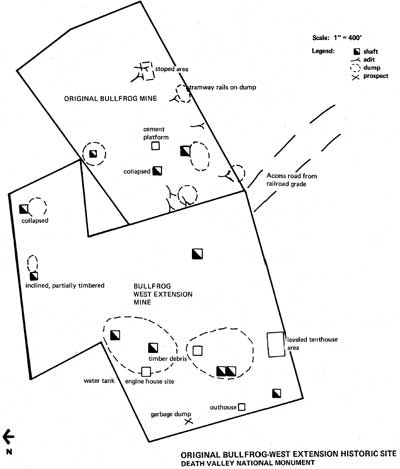
|
| Illustration 26. Sketch Map, Original Bullfrog-west Extension Historic Site. |
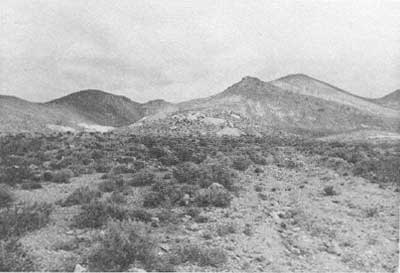
|
| Illustration 27. View from the site of Amargosa, looking northwest towards Bullfrog Mountain. The dumps of the Original Bullfrog cover the small knoll in the center, with the dumps of the West Extension tucked away in the small valley to the left. The grade of the Las Vegas & Tonopah Railroad, not visible in the picture, runs in front of the Original Bullfrog. 1978 photo by John Latschar. |
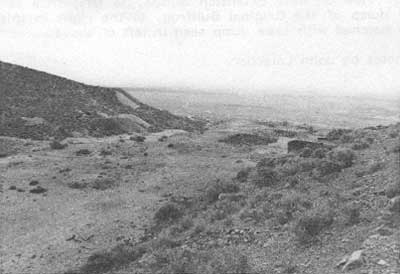
|
| Illustration 28. Reverse of above view, looking southeast from the West Extension towards the Amargosa site. Large leveled dumps of the West Extension are in the foreground, with two of the Original Bullfrog's dumps visible towards upper left. Collapsed headframe of West Extension is just to the left, foreground, off the photo. Compare this view to the March 1907 photo from the Rhyolite Herald. 1978 photo by John Latschar. |
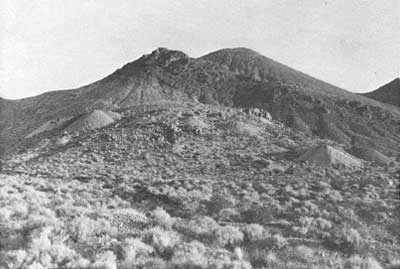 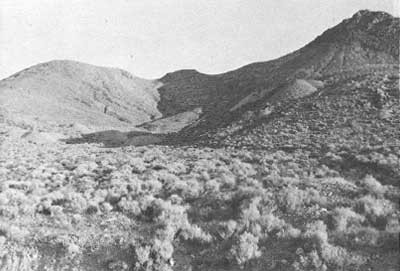
|
| Illustrations 29-30. Top: Closer view of the Original Bullfrog dumps, from the Las Vegas & Tonopah Railroad grade, looking northwest. Bottom: View of West Extension dumps to left, from the same spot. Conical dump of the Original Bullfog, to the right in this photo, may be matched with the same dump seen in left of above. 1978 photos by John Latschar. |
5. Gold Bar Mine
a. History
The early twentieth-century strikes at Tonopah and Goldfield attracted miners from all parts of the United States. Among them were two miners from Cripple Creek, Colorado, named Ben Hazeltine and N. P. Reinhart. Although they arrived in Goldfield too late to capitalize upon that rush, they soon found jobs in local mines. By the time the news of Shorty Harris' and d Cross' strike hit Goldfield, Reinhart and Hazeltine were ready for another rush, and they joined the great migration to the new Bullfrog District. Finding that all the close-in ground was already staked out, the two men drifted farther afield, prospecting in the upper Bullfrog Hills. On October 10, 1904, their persistence paid off, for they found and located the Hazeltine claims, approximately four miles northwest of Rhyolite, and two miles north of the Original Bullfrog.
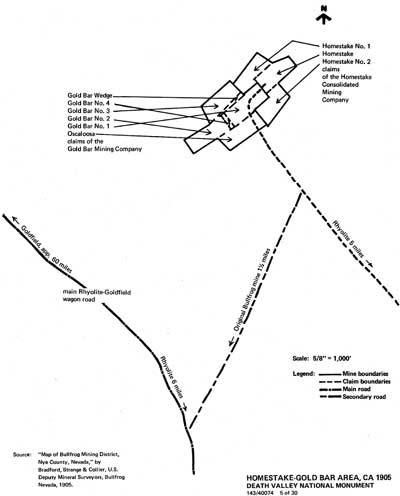
|
| Illustration 31. Sketch Map, Homestake-Gold Bar claims, 1905. |
The two men worked the mine by themselves for a short while, and regularly brought in ore samples to be assayed at Rhyolite. The rich results of the assay tests did not go unnoticed, and early in 1905 Reinhart and Hazeltine sold their mine. If the newspaper accounts are reliable, the two men joined that very select group of prospectors who were able to make good on their finds, for the reported sale price was $117,000 in cash and treasury stock of the purchasing company. The Rhyolite Herald hailed the sale as "the first deal of importance made in the district." The new owners, headed by Goldfield promotors J. P. Loftus and J. R. Davis, soon organized themselves as the Bullfrog Gold Bar Mining Company, and set to work. [51
The Gold Bar Mine immediately caught the attention of the Bullfrog District. By the end of May 1905, after only six weeks of exploratory work, the mine had run into ore ledges averaging $15 per ton, and had uncovered small rich pockets, one of which assayed at $1,458 a ton. The company ordered a 25-horsepower hoisting engine to replace its horsedrawn whim, built a wagon road to the mine, and began construction of a shaft house and other auxiliary structures. As the summer progressed, the mine raised its work force to fourteen miners, and continued to uncover evidence of paying ore. Although the small rich pockets were few and far between, the mine reported in July that it had an abundance of good ore worth $50 a ton. Towards the end of the summer, with the mine well into its development phase, a new boarding house had been completed for the convenience of the miners, and the Herald characterized the Gold Bar as "one of the surest and most dependable properties in the district."
Good news continued to flow via the mine's reports during the fall of 1905. By this time the mine was exploring the ground through three different shafts, one of which was down to the 150-foot level, and all three shafts reported paying ore. Superintendent L. E. Bedford reported that the company had spent almost $1,400 in development work, at the rate of $7.50 per foot of work. Further strikes in the Gold Bar caused its stock to jump from 104 per share to 35¢ in two weeks. With the continuing success of the Gold Bar Mine, and the opening of the Homestake Mine next door, a group of Rhyolite promoters located ten claims just south of the Gold Bar property, with the intentions of starting another town.
On November 17th, the Rhyolite Herald described the Gold Bar property in some detail. The mine, said the reporter, showed bigger continuous free milling ore deposits than any other property in the Bullfrog District, with a reported 350,000 tons of ore in sight. The Gold Bar had been the first mine in the district to discard the hand windlass in favor of a horse whim for raising ore. Even that, however, had proved insufficient, and the company had recently ordered a gasoline hoisting plant. The company owned a fifteen by twenty-one foot bunkhouse which slept fourteen miners, a boarding house, and superintendent Bedford was building a bungalow for himself, constructed of lumber and canvas. The company had begun to sack its high-grade ore for shipment, and was discussing plans for the construction of a 40-stamp reduction mill on its property. [52]
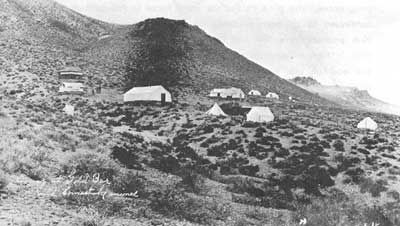
|
| Illustration 32. View of the Gold Bar and Homestake mining camp in November of 1905. Miners from the two companies shared living quarters in the fledgling townsite. The very small dump at the top of the picture belongs to the Homestake Mine--the Gold Bar workings are out of the picture to the left. Photo courtesy of Nevada Historical Society. |
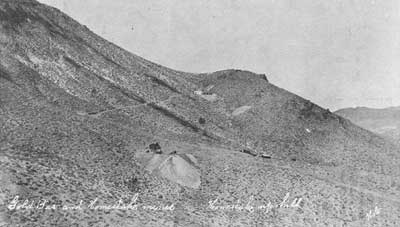
|
| Illustration 33. Another view of the Gold Bar-Homestake complex in late 1905, taken up the hill to the northwest of the previous picture. The dump and hoist in the foreground are the main workings of the Gold Bar Company, and the buildings in the center of the picture are also part of the Gold Bar complex. The two dumps and the structure towards the top of the hill belong to the Homestake Company. Photo courtesy of Nevada Historical Society. |
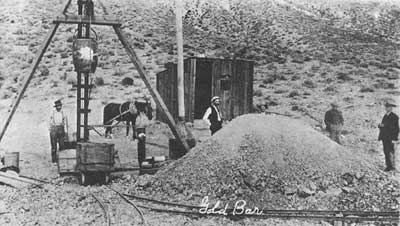
|
| Illustration 34. Close-up of the main Gold Bar shaft, in November of 1905. Note the rather crude hoisting frame, which was powered by the rather tired-looking horse in the background. The high-grade ore was stacked next to the shaft, for future sacking, as shown in the picture, while the waste was hauled via the ore car to the edge of the dump. Photo courtesy of Nevada Historical Society. |
The new hoisting plant for the Gold Bar arrived early in January of 1906, and after delays in obtaining enough timber to construct the gallows frame, development work resumed. By this time the company had completed over one thousand feet of underground work in its shafts, drifts and crosscuts, and all indications pointed to a very large body of ore. Stock in the mine rose to 49¢ per share, and local brokers advised their customers that it was a good buy at that price. The Gold Bar Company agreed, and on February 9th, applied for a patent to its claims.
In early March, the Herald again described the condition and prospects of the mine. The Gold Bar, according to the paper, now had the second largest hoisting plant in the state of Nevada. It consisted of a 28-horsepower Hercules gasoline hoist and a 1-ton ore skip with an automatic dumping capability, which could raise 140 tons of rock per day from a maximum depth of five hundred feet. The gallows frame of the hoist was fifty feet high and contained 20,000 board feet of lumber. Interior developments were also impressive. By the end of March the three shifts of miners had made lateral connections between the two main working shafts, while above ground other employees were sacking $350 ore for shipment. In order to improve communications, a telephone line was being built from Rhyolite to the mine. New strikes were being reported, with some assays running as high as $450 to the ton. The company continued to contemplate the building of a mill, if transportation problems could be solved, and had purchased water rights in the Grapevine mountains, eight miles to the west. Work started on improvements at that spring, which initially had a flow of three miner's inches an hour, enough to operate a small 10-stamp mill.
In the meantime, investors were eagerly buying stock in the promising mine. Shares of Gold Bar stock which had sold for 40¢ each in January jumped to 604: in February, and reached the magic figure of $1 each by, the first of March. Although the Bullfrog Miner, expressed mild surprise "at this almost phenomenal advance in the price of the stock of a company that has not yet shipped a pound of ore, the advance continued, and the Gold Bar stock reached the price of $1.92-1/2 per share on March 30th. [53]
In April, the fortunes of the mine reached a turning point, as the Gold Bar Company gave Charles M. Schwab, the famous steel millionaire and mining promoter, an option to purchase the property. Descriptions of the deal varied, but Schwab apparently had an option to purchase the mine for $1,000,000 by May 1st. Schwab sent his engineers out to examine the mine, prior to exercising his option, and the Bullfrog District waited in anticipation. The control of a mine by a man with the assets of Schwab could only mean good things for the entire district.
While Schwab pondered the deal, the Gold Bar continued to report discoveries of valuable ore, and the month of April saw so much promising development take place that the owners of the mine privately expressed the hope that Schwab would let his option expire without buying the mine. The Herald after digesting the latest company reports, called the Gold Bar "one of the biggest things in the far famed State of Nevada."
But the San Francisco fire and earthquake dampened the mood of unbounded optimism. Schwab requested an extension of twenty days on his option, due to financial difficulties caused by the disaster, and the Gold Bar Company approved his request--which seems to indicate that they were a bit more anxious for Schwab to buy than they had said. A further ten day extension followed the first, and finally Schwab decided not to buy. The newspapers advanced several causes for the decision. Some speculated that Schwab was hurt more than he was willing to tell by the San Francisco disaster. Others felt that Schwab's engineers had not given him favorable report on the mine, and one paper wrote that the present Gold Bar owners had killed the deal, by insisting upon being given too large a share in the new ownership of the mine.
Nevertheless, the deal fell through, and the owners put on a good face, declaring that they were glad that Schwab had not bought. Developments at the mine continued despite the effects of the San Francisco disaster upon financial circles. Sacking of high-grade ore progressed, the new main working shaft reached a depth of 250 feet, and the company began the construction of a new boarding house with accommodations for sixty miners. Towards the end of June the Gold Bar made its first shipment, a small one of five sacks of ore, and announced that it had received a government patent for its claims. Stock sales continued to be brisk, despite the financial climate of the times, and the company was reported to have a splendid treasury balance. [54]
On June 29th, the Gold Bar company held its first annual meeting, re-electing J. P. Loftus as president and J. R. Davis as vice-president and general manager. Davis reported that the company had spent $48,660.55 in the last year on development work and capital improvements, and that the mine had an estimated $2,347,000 worth of ore in sight. The company had $28,893.20 in cash in the treasury, and held unsold treasury stock worth $143,893.20 at the present market value. That market value had declined, though, as an inevitable result of the failure of the Schwab deal, and dropped from a high of $2.15 per share in May to a low of $1.02 in late July, before beginning to recover.
The Gold Bar Company continued operations through the intense heat of the summer. The mine now employed twenty-five men, and its main shaft reached a depth of 330 feet by the end of July. Discounting 'the small pockets of rich ore which were being sacked for shipment, values throughout the mine ran from $8 to $15 per ton. It was becoming apparent that the. Gold Bar was a low-grade mine, which would have to operate its own mill in order to make a profit. Work progressed on both the mine and the company's water rights during the fall. No new deposits of high-grade ore were found, but the company reported good milling values as the shafts reached deeper and deeper. Superintendent Bedford received praise from both the company and the local newspapers for his business-like manner, as the miners sunk their shafts, drifts and tunnels at a rate of 400 feet per month through October and November. By the end of 1906, when the Gold Bar Company paid its county taxes, the improvements listed on its property included the hoisting plant and gallows frame, a small engine house, a blacksmith shop, a boarding house, an office building, three Lenox ore cars, and mining tools and equipment. [55]
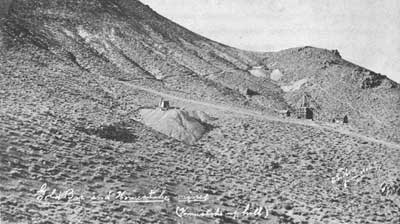
|
| Illustration 35. View of the Gold Bar workings in June 1906. The old working shaft, site of the discontinued horse whim, is in the foreground, with the new shaft and hoisting plant to the right. The dumps of the Homestake Mine appear in the top right of the picture. Photo courtesy of Nevada Historical Society. |
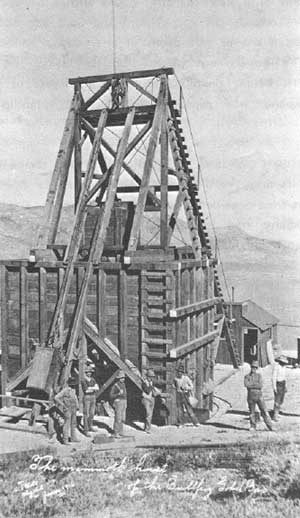
|
| Illustration 36. Close-up of the new hoisting plant of the Gold Bar in June of 1906. The massive gallows frame and ore bin dominate the foreground, with the engine house behind. Photo courtesy of Nevada Historical Society. |
In early January of 1907, the Gold Bar announced that it would definitely build a mill on its property, but no further details were released. In order to help finance the construction, the mine began to ship ore to the newly completed Las Vegas & Tonopah Railroad terminus at Rhyolite. Upwards of thirty tons were shipped by the end of February, estimated to be worth $8,000 to $9,000. Work on the water rights in the Grapevine Mountains continued, and the company installed a gasoline-powered pump at the spring to help improve the flow of water. By this time, the Gold Bar and the Homestake mines were together employing so many miners that the men briefly considered splitting off from the Bonanza Miners Union of Rhyolite, and forming their own local.
Two more carloads of high-grade ore were shipped via the Las Vegas & Tonopah in March, and the company received a check from the mill for February's shipment Although the returns from the first shipment were $7,000, less than had been expected, it still represented the best net profit to date of any shipment from the Bullfrog district. The Bullfrog Miner, summarizing the details of over 4,750 feet of development work at the Gold Bar, called the mine "the biggest milling proposition in the state of Nevada today."
When the Rhyolite Stock Exchange opened for its first day of business on March 29th, 1,000 shares of Gold Bar stock were sold for $1.15 each. In spite of the announced mill plans, and the fact that the Gold Bar had started shipping its high-grade ore, the growing realization that the mine was essentially a low-grade operation had steadily driven down prices from the highs of the previous summer. Stock which had opened the year at $1.50 per share had dropped to $1.25 in February and declined further in March.
Despite this decline in stock values, the Gold Bar seemed to have enough money in its treasury, due to shipments of high-grade ore and past stock sales, to press ahead with its mill plans. On June 22, the company announced that it had let a contract to a construction firm for the erection of its mill. The name of the construction firm was the Loftus-Davis Corporation, an ominous sign which went unobserved by the local newspapers. The mill plans called for the crushing of the ore by ten stamps, followed by amalgamation and cyanide treatments. Since the majority of the Gold Bar's ore was free-milling, more sophisticated and costly treatment was not necessary, in the view of the company. Work began for the mill foundations, and the company started laying a pipe line from its spring to the mill site.
Machinery for the mill was ordered, and shipped from the manufacturer in July, and the pipe line was almost complete by the end of August. The annual report of the company showed a total expenditure of $119,000 to date, and Loftus and Davis were re-elected to their posts at the head of the company. Later in August, mill machinery began to arrive via the railroad, while grading work at the millsite continued. Despite the physical evidence that the Gold Bar was evolving from a developing to a producing mine, stock prices continued to fall. $1.15 quotes in late March fell to 80¢ by the middle of May, to 70¢ by the end of July, and to 584: on the first of September. [56]
Work on the mill slowly progressed during the last months of 1907. The Nevada-California Power Company informed the Gold Bar that electric lines could not be extended to its property before March of 1908, so the company was in no great hurry to complete its mill. The underground miners were laid off, since the company felt it had enough ore blocked out to support the mill for several months, but work continued on the surface preparation for the mill. By the first of October, the excavation and grading work was completed, and the men began pouring the concrete foundations. These were finished by the first of November, and the framework of the mill building was begun.
Detailed plans for the mill were finally released to the press in early November. Power would be supplied by a 50-horsepower electric, motor, assisted by the gravity flow of the ore. The mill would have ten stamps, each weighing 905 pounds, for the crushing of the ore. Each stamp would have a 6-inch drop, at the rate of 100 per minute, giving the mill a crushing capacity of forty to fifty tons per day. From the stamps the ore would pass over 120 square feet of amalgamation plates, then into a Huntington mill, and over the plates again, in a surprise move, the company announced that cyanidation had been eliminated from the treatment process--a very unusual omission.
In addition, the Gold Bar began construction of a 50,000 gallon water tank above the millsite. With the ore already developed in the mine, whose main shaft now reached a depth of 600 feet, the company grandly announced that it had "immense reserves of milling ores which will keep the ten-stamp mill busy for years." The Rhyolite Herald also quoted the Gold Bar as stating "that there is enough ore in sight to run a 100-stamp mill at full capacity for two years, in which case there must be close to 400,000 tons blocked out." If the company's figures were true, and the average ore value is placed at a very low estimate of $7 per ton, then the Gold Bar Mine had almost three million dollars worth of gold waiting to be milled, and could look forward to a long and prosperous career. Investors, however, did not seem to believe the figures released by the Gold Bar Company. Stock in the mine continued to decline, from 42¢ at the end of September, to 38¢ at the end of October, and 30¢ by the end of November.
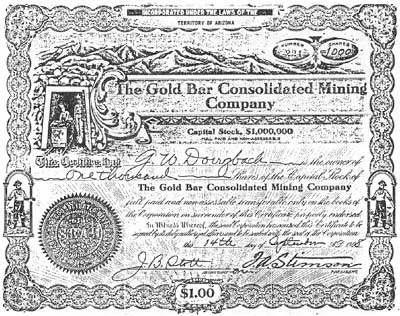
|
| Illustration 37. Stock certificate. Courtesy Dr. Richard Lingenfelter. |
Delays also began to plague the company. Although the mill building was completed by the first week of December, and the machinery was being installed, work on the power line was interrupted due to a conflict between the Nevada-California Power Company and the Western Federation of Miners. For an unknown reason, the union would not let any of its miners work for. the power company, and delays continued until a subcontract was let for the construction of the line. In the meantime, the Gold Bar had resumed underground work, in anticipation of the completion of the mill, and all the mill equipment was in place by December 7th, with the exception of the water pumps, which had not yet arrived. By January 10th, 1908, all these irritating delays had been surmounted, and the Gold Bar mill was finally ready to begin operations. Investors took heart, and stock in the company closed the year of 1907 with a brief flurry, rising to 37¢ per share. [57]
On January 11, 1908, the Gold Bar Mill began operations, amid much excitement and anxiety. The worries turned out to be justified, as the mill was forced to shut down within a week, due to excessive leaks in the pipe line. After several weeks of delay to replace the broken pipe, the mill started up again during the first week of February, and on February 22d, the first clean-up was made, resulting in $2,000 worth of gold bullion. The mine announced that this trial run had resulted in a recovery ratio of 86% of the gold content of the ore, and that it planned to treat 35-40 tons of $15 ore per day. President Loftus also announced that the success of the mill and the ore reserves of the mine practically guaranteed that the company would add thirty more stamps to its mill within six months.
Superintendent Bedford brought in another bar of bullion from the mill on the first of March, this one estimated at a value of $3,000 to $4,000. This was the result of two more week's production, which had continued despite reoccurring problems with the pipe line. The pipe delivered from a New Jersey supplier was half rotten, complained the company, and would not stand up under pressure. Despite this problem and others with the intermittent power delivered over the new electric lines, the mill treated an average of forty tons per day in March, with an average gold recovery of $350-$400 per day. The mine, in the meantime, was taking out ore at the rate of forty tons per day, sufficient to keep the mill in steady operation.
Production continued in April. On the 4th of that month, the mine shipped another bar of bullion, estimated at $4,000-$5,000 value, and the mill continued to treat approximately forty tons of ore per day, despite annoying leaks in the pipe line. Rumors circulated that the mine would be forced to replace the entire pipe line in order to solve the water problem, at the cost of considerable delays.
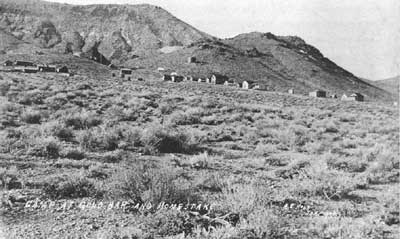
|
| Illustration 38. View of the Gold Bar-Homestake camp site in January of 1908. The recently completed Gold Bar Mill is visible towards the left top, and the very beginnings of foundation work on the Homestake Mill can be seen in the right-top corner. The population of the camp was at its height when this picture was taken, as both the Gold Bar and the Homestake were in periods of production. Note that wooden buildings have replaced the tent houses of earlier years. Photo courtesy of Nevada Historical Society. |
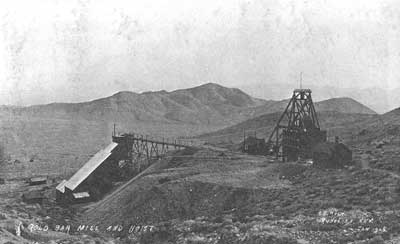
|
| Illustration 39. Close-up of the Gold Bar Mill and hoist in January of 1908. As usual, the mill was placed as close to the mine as possible in order to reduce costs of transporting ore, and was built on a slope so the force of gravity would help turn the machinery in the 10-stamp mill. Photo courtesy of Nevada Historical Society. |
Suddenly, on April 25th, the mine and mill were closed. The company announced that the shut-down was only temporary, in order to refurbish the mine and pipe line. In addition to the water problems, assay reports from the mill tailings indicated that the present treatment process allowed $3.60 per ton of gold to escape with the tailings. Losses of this magnitude obviously could not be tolerated in a low-grade operation. Belatedly, the company seemed to realize that it would have to install the relatively expensive cyanide treatment machinery in order to make a profit. Plans to replace the entire pipe line were also announced, with the New Jersey supplier providing free replacement pipe, and the Gold Bar absorbing the costs of relaying the pipe. 19,000 gallons of water was being pumped at the spring site, but only 9,000 gallons reached the mine. Ominously, the company did not announce a definite date for the beginning of the improvement work. The news hit the Bullfrog District with the force of doom, and Gold Bar stock quickly dropped to 16¢ per share. [58]
With the benefit of hindsight, it suddenly became apparent that something was definitely wrong with the Bullfrog Gold Bar Mining Company, and had been wrong for some time. L. E. Bedford, for example, who had been superintendent of the Gold Bar since 1905, had quietly resigned on March 21st, and left for California. He had told reporters at the time that he had been offered a better job, but now they wondered if he had seen something coming and had got out while the going was good. His departure, at the very time when the Gold Bar was finally beginning to produce, looked strange.
On May 6th, all suspicions were confirmed, as bad news hit town. I. K. Farrington & Company, a New York brokerage firm, announced that the recent decline of the Gold Bar stock was solely due to "the throwing over by a western bank of a large block of Gold Bar, with instructions to sell regardless of market price conditions." Evidently, someone on the inside knew that the Gold Bar was about to fail, and intended to unload. Three weeks later, the Rhyolite Herald reported that over 200,000 shares of the company's stock had been sold, as the dumping continued, and the price sank to 6¢. Loftus and Davis, in the meantime, the principal controllers of the Bullfrog Gold Bar, left for a two-month vacation in Europe, announcing that they would take a look at the Gold Bar problems upon their return.
While the pair were abroad, however, their attorneys were not idle. The Nevada Exploitation Company, an aptly named Goldfield concern, filed suit for an attachment on the assets and property of the Gold Bar Company, in order to recover $36,300 which it had advanced to the Gold Bar to finance the construction of its mill. The owners of the Nevada Exploitation company were Messrs. Loftus and Davis. In essence, Loftus and Davis were thus suing themselves, but if they won, the Gold Bar would become the property of the Nevada Exploitation Company, and all holders of Gold Bar stock would be left holding the bag. Given the fact that Loftus and Davis were controlling partners in both corporations, one could not expect that the Gold Bar Company would be adequately defended in court.
The Rhyolite newspapers smelled fraud of the worst sort, and started screaming. The Herald managed to obtain copies of the company's reports for April and June of 1908, which gave the directors' side of the story. According to Loftus and Davis, the Gold Bar had decided to borrow the money for mill construction from Nevada Exploitation Company (owned by themselves), rather than sell shares of the company's treasury stock. At the time that decision was made, stock in the Gold Bar had declined from a high of over two dollars per share to 40¢. Since they were sure that the mill would prove to be a large success, they felt that, the treasury stock would then rebound to values around $1 each, so it was in the company's best interests to hold on to its stock.
As soon as the mill opened, however, the mine superintendent suddenly reported that the values of ore in the mine were not at all what he had claimed during past years, and the mill was forced to attempt to reduce very low-grade ore. Finding that the mill was losing money, Loftus and Davis then decided to sell the treasury stock, in order to repay the company's debt to the Nevada Exploitation Company Failing in that attempt, with the company treasury depleted and the mill losing money each month, Loftus and Davis had reluctantly come to the decision to close down both mine and mill. Just as reluctantly, they had also been forced to sue themselves in order to recover their money. All in all, the two men claimed, the failure of the Gold Bar Mine was the fault of Superintendent Bedford, who had deceived both themselves and the public for over two years concerning the true value of the ore deposits in the mine. It was no wonder that he had left town.
The Herald however, did not believe a word of it. Bedford had indeed been guilt of deceiving the public, but not of deceiving Loftus and Davis, who obviously were the leaders of the company. Only when Bedford had discovered that Loftus and Davis planned to let him carry all the blame for the company's fraudulent practices had Bedford decided that discretion was the better part of valor, and left town. The Herald could cite too many direct quotes from Loftus and Davis concerning the prospects and values of the Gold Bar to believe that they were innocent. One had only to review the directors' production statements of the last several months to prove that point, for while they were claiming bullion shipments of $4,000 to $8,000 per month, the actual figures released in the official company reports were from $1,500 to $2,000. It was evident to the Herald that Loftus and Davis had intended to defraud the public from the beginning, by loaning themselves money to build a mill, releasing false claims of mill returns, dumping the company's stock on the market, then recovering their loans by foreclosing on the Gold Bar. Thus they would be left with all the profits of the mill returns and the stock sales and would lose no money at all. The public stockholders, however, would lose every penny which they had invested in the Gold Bar Mine since 1905.
Despite the extreme anger of the local newspapers and of stockholders around the nation, the plans of Loftus and Davis were completed with hardly a hitch. The Nevada Exploitation Company won its suit agains the Gold Bar Company, and in December of 1908 the Gold Bar mine and mill were sold to the. Nevada Exploitation Company. Holders of Gold. Bar stock, which had plunged to 3¢ per share, were left with nothing but waste paper in their hands.
Not content with their coup, Loftus and Davis then proceeded to announce a grand reorganization of the Gold Bar. They proposed to reincorporate as the New Gold Bar Mining Company, with a capitalization of 1,000,000 shares, par value $1 each, and offered to sell 600,000 shares in the new company to stockholders of the old, at a special discount rate of 7¢ per share. The money thus raised, they announced, would pay off the debt owed by the Gold Bar to Nevada Exploitation, after which the mine would be free to resume operations. The Rhyolite Herald managed to secure an interview with Loftus and Davis, at which "The merits and demerits of the Gold Bar freeze-out were discussed with considerable animation."
The Herald reporter showed Loftus and Davis a copy of the Gold Bar's official report of the fall of 1907, wherein the company had stated that it had $1,250,000 worth of ore in its mine. The two men insisted that the best estimates had indicated that there was that much ore in the mine, but as soon as the miners began extracting ore for the mill from the fabulous ore ledges, every single one of them disappeared. Loftus and Davis agreed that the simultaneous failure of every ore. body in the mine at the same time was "somewhat extraordinary" but it was "nevertheless true."
The Herald reporter pressed on, citing conflicting reports given to the public via the newspapers and those released at later dates as official company reports. Time and again, Loftus and Davis insisted that there had been no intent to defraud the public. Finally the reporter asked why the company had dumped its treasury stock after it had determined that the mine and mill were a failure and would have to be closed down. "What kind of treatment is that for the public to receive at your hands?" Loftus' reply amply summed up the philosophy of the Gold Bar Company. "I am not the guardian of the public. It is up to the public to decide these things for themselves." When further pressed by the reporter as to the lack of ethics displayed by the company, Loftus reiterated his feelings in the best tradition of the nineteenth-century robber barons--"The public be damned."
All this damning of the actions of Loftus and Davis, of course, could not bring back the Gold Bar. The therapeutic value of being able to identify and condemn a pair of acknowledged villains, however, seemed to be good for the Bullfrog District, and the papers continued to be full of various and sundry attacks upon the motivations, characters, and ancestry of Loftus and Davis. As the attacks continued, the Rhyolite Daily Bulletin reintroduced a factor that everyone seemed to have forgotten in the recent excitement. After digging through past copies of the Rhyolite newspapers, the Bulletin reminded the public that the contract for the construction of the Gold Bar mill had been awarded by the company to the Loftus-Davis Company of Goldfield, and another piece of the puzzle fell into place. It was no wonder, said the Bulletin that the Gold Bar Company had been willing to accept a poorly designed and built mill, with rotten water pipes, a lack of cyanide treatment facilities, and other defects.
The full extent of the fraud now became clear for the first time. Not only had a Loftus-Davis controlled company loaned the Gold Bar the money to build its mill, but the mill had then been built by yet another Loftus-Davis company. How much of the almost $50,000 paid by the Gold Bar to that construction company represented a pure profit? And how did Loftus and Davis have the nerve to sue the Gold Bar to recover the costs of construction, when they had already paid themselves for the actual construction work? The Bulletin's question, of course, went unanswered.
Indeed, Loftus and Davis inexplicably seemed to be unaware of the extreme wave of hatred directed towards them, for they blithely persisted in advertising for investors in their reorganization efforts. Needless to say, their advertisements fell upon barren ground. No one who had been burned by one of Nevada's most complete swindles was willing to suffer again, and the reorganization plans soon fizzled out. Ironically, at about this time, the United States Geologic Survey published its report on the Bullfrog district. "Although a little rich ore has been found" in the Gold Bar Mine; the report stated, 9t is evident that the deposit is to be regarded as a large mass of low-grade material, such as can be worked, if at all, only on a considerable scale and by the most economical methods possible in this district." Economical was one thing which the Gold Bar Company was not. [59]
Although the Gold Bar affair was now finished, it was some time before all the dust settled. Angry stockholders continued to write letters to the Rhyolite newspapers, denouncing the fleecing which they had taken, and Loftus and Davis experimented with several more attempts at reorganization for several months. Neither had any success. More annual reports of the Gold Bar Company were dug out and exposed in the newspapers, including one of June 1906, which stated that the company had over two million dollars of gold ore in sight. Several individuals and companies made feeble efforts towards teasing and reviving the mine, but all failed before they really got started. One thing became abundantly plain--the Gold Bar Mine did not have any paying ore at all. The Nevada Exploitation Company,, however, paid its taxes upon the Gold Bar property in December of 1909, in order to protects its investment in the mill and machinery located on the property, but no work was done upon the ground during that year.
In June of 1910, by which time the Gold Bar Mine had been idle for over two years, the Nevada Exploitation Company announced that its mill buildings and machinery were for sale, but no one seemed interested in purchasing a poorly designed mill. Finally, in February of 1911, the company succeeded in selling the mill to the Round Mountain Mining Company, for transfer to another Nevada mining district. By this time, Loftus and Davis felt safe to show their faces in the Bullfrog district, when they came to close the deal. The two men still insisted that they had been innocent all along, and that the sole cause behind the Gold Bar's problems had been the deceptions practiced by former Superintendent Bedford upon the company and the public. No one believed them, but the Bullfrog District was probably glad to see the Gold Bar mill, a constant reminder of a past failure, shipped away during April.
By this time the Gold Bar Mine had entered that company of failed mines which people will not let rest in peace. Between 1910 and 1919 the Nevada Exploitation Company continued to hold title to the ground and paid county taxes each year. The company even performed the required $100 of labor each year on each claim, in order to avoid still higher taxes. But in 1920, Loftus and Davis finally gave up, quit paying taxes, and the Gold Bar joined its Bullfrog contemporaries on the delinquent tax list of the Nye County Treasurer. [60]
The Gold Bar Mine rested on the county delinquent tax list from 1922 until 1942, with the exception of 1937, when the mine was briefly worked. Then, in 1942, the Gold Bar was purchased from the county (through payment of back taxes) by an individual from California who incorporated himself as the Gold Bar Mining Corporation. Whether for reasons of nostalgia or otherwise, the Gold Bar Mining Corporation still retains title to the mine, dutifully paying county taxes of from $110 to $150 each year. No serious mining endeavors, however, were ever carried out. [61]
The story of the Bullfrog Gold Bar Mining Company is not a pleasing one. It is, however, one that is all too typical of the mining history of the early twentieth century. What started out as a legitimate effort to exploit a high-grade gold deposit turned into a high-grade fraud when its owners figured out that the Gold Bar was a low-grade mine, and was not the sort from which fortunes are made. Like many mining promoters before and since, Loftus and Davis determined to mine the pockets of stockholders when it became evident that mining the ground would not prove profitable. Given the boom spirit and unbounded optimism of the Bullfrog District, which is most typical of mining camps throughout history, it is not altogether surprising that Loftus and Davis were so successful.
As is obvious by now, the Gold Bar mine was never a large producer of gold. I is impossible to determine how much ore was ever taken out of the ground, since the majority of the available figures are those which were released to the press by the company itself. It is doubtful, however, that the Gold Bar ever contributed a significant amount of gold to the coffers of the country. Two things, though, are abundantly clear: the private stockholders of the Gold Bar company never made any money at all, and Loftus and Davis never lost any. How much money those two promoters gained from their various swindles will never be known.
b. Miscellaneous Gold Bars
Like the area around the Original Bullfrog, the ground surrounding the Gold Bar Mine was covered with locations, prospects and mining companies shortly after the initial successes of the Gold Bar Mine were publicized. As usual, most of these companies incorporated the words "Gold Bar" into their titles, staked out ground as close as possible to it, and tried to attract investors. Like the Bullfrog tadpoles, some of these mining companies never actually mined, while a few did. All of them failed.
Chief among these companies who tried to find ore were the Gold Bar Extension, which operated intermittently from June of 1905 to February 1908; the Gold Bar Annex, which existed from February of 1906 to August of 1907; the Original Gold Bar Extension, which ran from April to November of 1906; and the Gold Bar South Extension, with a life-span from April of 1906 to April of 1907. None of these companies ever found any ore, and although a few of them were able to list and sell their stocks for a short period of time, a singular jack of success marks their efforts.
c. Present Status Evaluation and Recommendations
See the Homestake-King section, where it and the Gold Bar mines will be discussed together.
6. Homestake-King Mine
a. History
Once a prospector was lucky enough to find indications of gold on the surface of the ground, he then faced another difficult decision. Which way would the ore vein run after it disappeared beneath the surface? This was a question of great import, since all mining districts had distinct limits as to how much ground each prospector could locate. Thus, if the discoverer of surface gold guessed wrong, and the vein angled out of his claim and underneath neighboring claims, then the discoverer was out of luck, while his neighbor was in.
This was the problem which faced N.P. Reinhart and Ben Hazeltine when they discovered what became the Gold Bar Mine. Like most prospectors, they had a rudimentary knowledge of geologic formations, and an even greater store of contemporary prospectors' myths and hunches. After studying the land, the two men decided that the vein ran northwest and southeast, and staked their claims. Unfortunately, they had guessed incorrectly.
As usual with the site of a new discovery, the Gold Bar area was soon over-run with eager prospectors looking for "close-in" ground. One of these was a man named John McMullin, and the poor luck which had dogged Reinhart and Hazeltine proved to be his good fortune. McMullin studied the Gold Bar claims, examined the surrounding territory, and decided that the vein ran southwest and northeast: or perpendicular to the prior guess. McMullin therefore staked out his allotted three claims, named them the Homestake after the famous South Dakota gold mine, and started to dig.
McMullin staked his claims sometime in early 1905, and immediately found indications of good ore deposits. Within two months of his discovery eastern financiers had obtained an option on his infant mine. As McMullin continued to dig, and continued to find good ore indications, the deal was soon consummated, and in September of 1905 McMullin sold out for cash, stock and a seat on the board of directors of the Homestake Consolidated Mining Company. The Homestake was the usual corporation of the times, with the exception that it decided not to sell shares on the public market. The company was dominated by semi-retired Dallas businessmen, who were looking for a good investment and who seemed to have ample cash to finance the development of the mine. B.D. Milam, a former Dallas real estate magnate, was elected president of the company and Con O'Donnell was named general manager in charge of development. John McMullin, as promised, proudly took his seat on the board of directors, a prospector who made good.
By the end of September, after only one month of vigorous development and exploration work, the Homestake Company verified the good guess work of McMullin. The company announced that it had penetrated the Gold Bar ledge on its property and further declared its belief that the ledge ran entirely through one of its claims. The Homestake Consolidated Mining Company was in business. [62]
During the remainder of 1905, the Homestake rapidly went to work. A shaft was begun, just a few feet inside the boundary line separating the Homestake from the Gold Bar, and ore valued at $39 per ton was almost immediately uncovered. The company began to build a bunk house for its miners, and ordered a 15-horsepower hoisting engine for the property. The new hoist arrived promptly on January 5, 1906, and was soon installed and working. The future of the property seemed assured when a saloon was established near the mine, for saloon-keepers in mining camps seemed to have an uncanny ability to judge which mines would furnish long-term business and which would quickly fade away.
Flanked as it was by the Gold Bar Mine, which had completely captured the attention and the headlines of the local newspapers, the Homestake quietly developed its property without the benefit of much publicity. By the end of March, 1906, the exploration shaft had been sunk to a depth of 220 feet, which caused the company to cease sinking until means could be provided to pipe air to the miners far below ground. The Homestake kept the papers informed of its discoveries as time progressed, but the $35 ore found in that mine could not compete with the more fabulous reports from the Gold Bar Mine, and Homestake news was relegated to the back pages.
Although the Homestake Company had an official policy of not selling shares of its stock on the open market, it had no control, of course, over the sale of shares by its stockholders. Blocks of shares appeared on the local stock markets from time to time, and after a stow start, began to capture the attention of local investors. 100,000 shares were traded in early April at a price of 75¢ each, and as investors realized that the Homestake Consolidated Company meant business, the price rose to 85¢ in May. While this could not compare with the $1.60 commanded by the Gold Bar, it was a very health price for stock in a company which was still in the early stages of exploration and development. Although the San Francisco disaster depressed stock values temporarily, they soon recovered. [63]
In the meantime, another mining company had opened for business in the Gold Bar-Homestake area. Incorporated as the Bullfrog Gold King Mining and Milling Company, it was owned in large by the same people who controlled the Homestake. B.D. Milam was the president of this company, and Con O'Donnell was general manager, mirroring the same positions which they held with the Homestake. F.S. Kelly, the present superintendent of the Homestake mine, was also named as superintendent of the Gold King. The new company owned four claims and two fractional claims adjoining the Gold Bar and the Homestake on the north. Although the two companies held separate incorporations, for all practical purposes they were considered the same mine, and were developed in tandem.
As the summer progressed, the two mines were steadily developed. Good surface values were found on the Gold King, while the Homestake continued to uncover milling grade ore in its shaft, which was now down to 285 feet. Fourteen men were employed at the mines, and a 15-horsepower gas hoist was ordered to facilitate development at the Gold King. By the end of the summer, the hoist had arrived and was installed, and both mines reported continuing good ore values. Nothing sensational, however, was uncovered at either property, and the Homestake-Gold King complex continued to take a back seat in the newspapers to their neighbor the Gold Bar. Private investors showed more confidence in the mines than did the newspapers, and Homestake stock steadily advanced through the summer, until it sold for $1.15 per share in the middle of August.
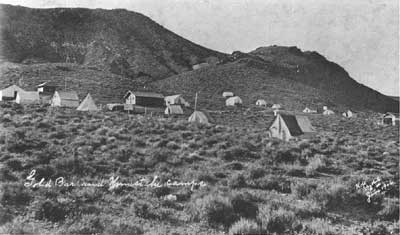
|
| Illustration 40. The Gold Bar-Homestake camp in June of 1906. The main working dump of the Homestake can be seen in the top center of the picture. Note that telephone lines have already been connected to the little work camp, and that piles of lumber on the ground indicate that wooden structures will soon take the place of earlier tent homes. Photo courtesy of Nevada Historical Society. |
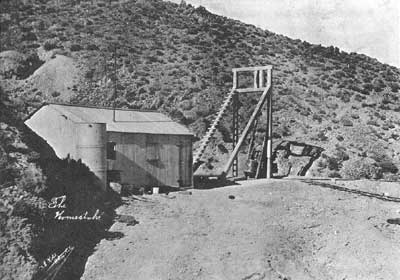
|
| Illustration 41. Main working shaft of the Homestake Mine in June of 1906. The small hoisting frame sits directly above the shaft, and the ore bucket is visible at the surface. The tin building housed the 15-horsepower hoisting engine used in the early days of the mine. A prospect hole is also visible above the engine house. Photo courtesy of Nevada Historical Society. |
By early fall, the Homestake Company was ready to pass from the exploratory stage into the serious development of its mine. Underground probes had indicated the presence of good ore bodies, and with a better idea of which way the ledges twisted and turned the company was able to plan an advanced development campaign. A new working shaft was started close to the division line between the Homestake and the Gold King claims and a 40-horsepower hoist was ordered for placement there. By way of underground connections, the company planned to use this shaft to hoist all the ore found in both mines to the surface. Investors agreed with the rosy future foreseen by the mining companies, and Homestake stock continued to record good sales at $1.15 per share. Gold King stock also entered the trading board at a price of 35¢.
During November, the realization slowly hit the Bullfrog District that the Homestake and Gold King mines were quietly developing into something big. When the companies announced plans to consolidate their workings even more, and when the Homestake ordered more cable to enable it to sink beyond the 300-foot level the news was printed on the front pages of the newspapers rather than on the back. Although neither company deluged the papers with reports of fabulous ore discoveries as most mining companies were wont to do, stock values continued to rise. Gold King hit a high of 53¢ per share on November 9th, and Homestake rose to $1.70 the following week.
Then, in December, the management of the Homestake and Gold King mines took the anticipated step and officially combined their companies. With the overwhelming approval of the stockholders and directors who were gathered in Dallas, the two companies were reorganized as the Homestake-King Consolidated Mining and Milling Company. The merger meant a stock split, and all the old Gold King and Homestake shares were called in, for exchange for the new. Gold King stock was exchanged at the ration of four shares of old to one new, and Homestake stock went on a one-to-one basis, based upon the present market value of the two stocks. The new company announced that its capitalization was for 1,500,000 shares, or half again as many shares as either company had held before. More available shares, of course, meant that each share was worth less, and although the Bullfrog District heartily approved of the merger, Homestake-King stock immediately sold for less than Homestake Consolidated had been selling.
The new company was prepared for such inevitable occurrences, and soon announced its plans for the future. The company had a $40,000 treasury, enough to finance a considerable amount of development work, and admitted that it was seriously considering the construction of a mill upon its property, should ore values continue to hold with depth. Towards the end of 1906, the company began to sack its high grade ore, worth from $350 to $500 per ton, and seemed to be in fine shape. Taxes were paid on improvements to the mines consisting of two gas hoists, one engine house, two gallows frames, mining tools, ore cars, and three lots which the company owned in Rhyolite. But investors seemed wary. Stock prices fell to $1.25 per share at the end of December, which was not unexpected due to the merger, but sales were slow. Undoubtedly, the troubles which the Gold Bar was experiencing about this time depressed the Homestake-King sales, since the two companies were mining the same ore lode. [64]
Development activities proceeded through the early months of 1907. In February, with twenty-one men employed in three shifts, the company began construction of another bunk house and a boarding house. Teams of surveyors began a search through the surrounding hills for a water source to supply the future mill. In March the superintendent was forced to halt vertical work when the shaft reached the 400-foot level, which strained the old 15-horsepower engine to its utmost. While the mine awaited its long overdue 40-horsepower engine, the men were put to work in lateral explorations, pushing drifts and crosscuts out from the shaft at the 200, 300 and 400-foot levels. Ore of good milling value was found on all levels.
At the end of March, the company leased the water rights at Mud Springs, approximately five miles north, and began improvements at the springs designed to increase the water flow to a level sufficient enough to support a stamp mill. Although no detailed plans were yet reached, the mine superintendent guessed that the future mill would have forty stamps. The Bullfrog Miner printed a summary of development work at the Homestake-King on March 29th, listing a total of 2,288 feet of underground work completed. Surface improvements consisted of one 40-horsepower hoist (which had just arrived), one 24-horsepower hoist and the old 15-horsepower engine. In addition, the company operated a 10 by 12 compressor, which powered the air drills used in the mine.
Then, on April 5th, the Homestake-King committed itself to the construction of a mill, a step which the Bullfrog District had eagerly awaited. The directors voted $100,000 for mill construction, but did not release any details concerning the reduction plans. The local papers felt assured that nothing less than forty stamps would be considered. Con O'Donnel, general manager of the company, gave the papers an estimate of 40,000 tons of $25 ore in the mine as well as 90,000 tons of $15 ore. The Rhyolite Herald thought this estimate of $2,350,000 of mineral content was too low, and speculated that the mine actually contained $5,000,000 worth of ore. Given either estimate, the company felt that all the paying ore in the mine could be profitably mined since their experts had predicted mining and mill costs of $4 per ton. Investors took heart at the announced plans, and Homestake-King stock rose slightly to $1.20 per share.
Committed to developing its mine on a large scale, the Homestake-King forged ahead. The new 40-horsepower hoist was placed above the main working shaft and sinking resumed, with the intention of doubling the depth to 800 feet. Since the ore discovered on the 400-foot level had been the best yet discovered in the mine, the company hoped for further improvements as greater depths were reached. At the same time, the surveyors reported that Mud Springs could be developed in sufficient quantity to supply the mill with adequate water, and the company negotiated for its purchase. In reply to constant inquiries, the Homestake-King promised that the papers would be given complete mill plans, as soon as water rights were secured. [65]
Work at the Homestake-King complex continued apace through the long hot summer months. The main shaft reached the 500-foot level on July 20th, and continued to show good values with increased depth. During August, the company directors met at Rhyolite to inspect the mine and then retired to San Francisco to discuss details of the proposed mill. On August 24th, they cautiously announced their preliminary plans. The mill would be large, with twenty stamps and a 100-ton daily capacity, but details of the reduction process would have to await the results of ore tests. For this purpose, five tons of ore were shipped to San Francisco for extensive tests, and representatives of several machinery firms were invited to visit the mine in order to draw up and submit bids on the construction work. Meanwhile, the company purchased the water rights at Mud Springs, and put seven men to work on a pipe line.
Ore tests were completed in October, and the company announced that the results indicated that a 96% savings ratio was possible. President Milam returned to Rhyolite to participate in ground-breaking ceremonies as the company began preliminary excavation work on the mill site. Milam told reporters that the mill, with good luck, would be completed by March of 1908, but that final contractural details had not yet been resolved. In the meantime, the miners were shifted from shaft work, and began lateral work on several levels in order to develop quantities of ore for delivery to the mill.
Final plans were announced in November. The Homestake-King signed a contract with the Nevada-California Power Company for the delivery of electric power to the mill site for ten years. The next day; on November 23d, the company announced that the contract for the construction of its mill had been let to the famous Colorado Iron Works of Denver, the winner of the five firms which bid for the job. The Rhyolite papers differed as to the costs of construction, with one reporting $150,000 and the other $200,000 but both gave details of the mill plans.
The ore would first pass through a grizzly and a McCully gyratory crusher, for preliminary crushing, and then would undergo final crushing by twenty-five stamps. From there the pulp would pass over twelve feet of copper plates, then through a Door classifier and to three tube mills for fine grinding. The slime would next be run through two settling tanks, each measuring thirty feet across and six feet deep, while tailings from the tube mills would be rerun over the plates. From the settling tanks, the slime would enter final reduction via two seventeen-foot agitators, the stock slime tanks, a forty-frame Butters filter and the gold storage solution tanks. Finally, the ore would be filtered through the zinc boxes, producing the final bullion. In addition, two twenty-foot by five-foot sand tanks were provided to treat the intermediate sands by leaching, as necessary. As was obvious to all concerned, the Homestake-King mill was the result of much testing and thought, and represented one of the finest stamp mills which money and modern technology could provide--an undoubted contrast to the rather simple mill being built at the Gold Bar.
The mill building itself would be constructed of steel throughout, and Mr. Rothwell of the Colorado Iron Works, who had supervised the construction of mills "in practically all the camps of the United States and in Mexico," would personally supervise all construction details. The design of the mill building would be such that the capacity could be increased beyond the initial twenty-five stamps in the future without impeding the day-to-day operation of the mill. On December 3rd, the Tonopah Lumber Company won the contract to supply lumber for the mill construction, and three days later excavation work began in earnest.
But despite the clear evidence of big plans in store for the Homestake-King, its stock took a beating in the fall of 1907, as a result of the great panic which was sweeping the nation. Prices fell steadily from 97¢ per share in July to 854: in September, to 75¢ in October and to 55¢ on December 4th, just a few days before construction work began. [66]
Delays almost immediately began to plague the company. The Homestake-King had contracted with the Gold Bar Company for the water necessary to begin work on the concrete foundations of the mill, but the water problems with the Gold Bar pipe line prevented it from delivering any to the Homestake-King. Nevertheless, the company steadily worked on the excavation and foundation work, with water painfully hauled from Rhyolite and from Currie's Well. Another bunk house was built at the mine to accommodate the additional fifteen men hired to work on the mill. By the end of December, the excavations were almost complete, the mill foundations were well under way, and the Colorado Iron Works notified Mr. Rothwell that the factory was ready to begin shipment of parts and machinery as soon as he was ready for them.
By the middle of January, 1908, the excavation work was complete and the mill foundations were almost finished. Carloads of material began to arrive over the Las Vegas & Tonopah Railroad, and the company had in its employ one 10-mule team used solely in hauling water, and two others for hauling rock and sand for the concrete. President Milam visited Rhyolite in order to inspect the progress of the work, and informed reporters that the total weight of the machinery to be delivered for the mill was in excess of 700 tons. Milam expected the mill to be operating by the first of May. Towards the end of February, with the foundations practically finished, framing for the mill building began, while operations in the mine continued as it readied itself to deliver a steady supply of ore to the mill.
During March the foundations were finally finished, and a Bulletin reporter wrote that they measured 231 feet from end to end and 103 feet from side to side. By now mill machinery and material was arriving almost daily over the railroad, as well as pipes for the water line. As April passed by, the battery bins were finished and the ore bins were started. The foundations for the settling, sand, and leaching tanks were completed, and the steel frame of the building was put in place. Cyanide tanks were under construction, the twenty-five stamps were installed and the tube mills were put into position. Delays in certain deliveries, such as steel sheeting to cover the building, slowed the pace of construction.
With construction lagging behind schedule at the end of April, the company increased its force to sixty-three men. Final shipments of the delayed materials were soon received, and the building began to take shape above the desert. The seventy-five ton ore bin was finished, and the 350-ton bin to hold the crushed ore was completed. The ore crushers were installed and the 50,000 gallon water tank was erected. Amalgamating tables were finished and work began on the cyanide tanks. The Homestake-King made arrangements to tap the power line of the Gold Bar mill soon after it shut down, in order to save on the cost of building another power line to the site. The company received its shipments of electric motors, consisting of two 30-horsepower, one 20-horsepower and two 10-horsepower.
During May, the company intensified the work schedule in the mine and purchased and installed a six-drill compressor plant to power additional air drills. By the middle of the month the sheet metal skin of the mill was half finished, as was the pipe line, and a week later the Nevada-California Power Company began to install the electric connections between the Gold Bar and the Homestake-King. A slight delay ensued when problems with the water pumps for the pipe line were encountered, but on June 3d the mill was complete, except for a few final finishing touches. Reporters who visited the site were dutifully impressed and glowingly described the mill.
The mill foundations rested on solid rock, and the steel framework was securely fastened to the foundations. Ample windows were provided for light inside the mill, and the company awaited only the arrival of a new pump and the turning on of the power by the Nevada-California Power Company to begin operations. According to the details of the construction contract, the Colorado Iron Works representative would supervise the operation of the mill for sixty days, and the Homestake-King would only take final acceptance of the mill after that period, after the mill had proved to be operating flawlessly.
As construction on the Homestake-King Mill had progressed, stock prices in the company had steadily gone downhill. After a brief flurry in December of 1907, when prices rebounded to 75¢ per share, the sudden closing of the Gold Bar Mill, and all the dirt which that stirred up had a deadening effect upon the fortunes of the Homestake-King. Although there were no murmurings or rumors of fraud connected with the Homestake-King, the public obviously felt that since its mill would run on the same ore ledge which had utterly failed in the Gold Bar Mine, that the same fate would be repeated at the Homestake. Stocks fell to 57¢ per share in January, to 48¢ in February, and all the way to 30¢ each in April, after the Gold Bar Mill had closed. At that point the slide slowed down, and Homestake-King stock hovered around 304 per share for several months. [67]
On June 20, 1908, the Homestake-King Mill turned on its machinery for the first time. The preliminary tests went well. No leaks were found in the water lines, and no vibrations were felt in the mill, even when all twenty-five stamps were activated. The company proudly announced that the mill was extremely well-built, and one of the finest of its kind to be seen anywhere. It was automatic, in the terms of the day, so that a force of only twenty men was needed to operate the mill around the clock. Best of all, in the light of the recent Gold Bar disaster, the Homestake-King proudly announced that there were no mortgages or outstanding loans against the company and that the mill was completely paid for. Thus, "there will never be any question about the property being taken over for debt." As a further attempt to boost the sagging investor confidence in the Bullfrog district, the company reiterated that it had "never sold a single share of stock on any exchange. The stock that has been sold on the exchanges did not come from the treasury, but has been offered by private parties."
During the first week of July, after preliminary mill tests were completed, production runs began. Approximately eighty tons of ore were sent through the workings per day, and three shifts of sixty men were at work in the mine and the mill. Towards the end of the month, the mill's capacity had been increased to one hundred tons per day, with the mill extracting 90% on the gold in low-grade ore and 95% in high-grade. On August 22d, the Homestake-King made its first shipment of bullion, weighing 925 ounces. The Rhyolite Herald estimated the shipment to be worth $17,000 and the Bullfrog Miner, guessed $25,000. Whichever was right, the Homestake-King had entered the rare and proud company of producing mines.
But on September 1st, the mill was suddenly shut down, and the entire Bullfrog District braced itself for a repetition of the Gold Bar story. Rumors flew thick and fast concerning the cause of the shut-down, with the majority holding that the Homestake-King, like the Gold Bar, had no ore in its mine. The company itself compounded the mystery and confusion by remaining silent, giving the newspapers no reason for the closure. This time, however, the district was blessed with a happier ending. Conflicts had arisen between the Homestake-King and the Colorado Iron Works concerning the final payments due on the mill, and the mill had been closed while the directors of the two companies met in the middle of September to iron out a compromise. Late in September an agreement was reached and the mine and mill resumed operations. President Milam, who belated realized the consternation which had swept through the district, apologized for the lack of information given out by the company, and promised a policy of full publicity in the future in order to avoid any further misunderstandings.

|
| Illustration 42. The Homestake-King Mill in May 1908, looking south towards Bullfrog Mountain. Note that all the windows have not yet been put into place. Photo courtesy of Nevada Historical Society. |
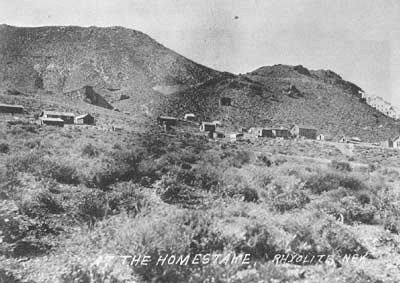
|
| Illustration 43. The Homestake-Gold Bar camp in June of 1908. The Gold Bar Mill, now shut down, is at the left, with the almost-completed Homestake-King Mill at the extreme right. Wooden buildings have taken over the camp site from the tent dwellings of previous years. Photo courtesy of Nevada Historical Society. |
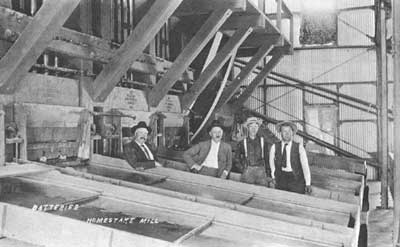
|
| Illustration 44. Interior of the Homestake-King Mill, ca June 1908, just prior to completion of the mill. This view is of the battery room, where the ore exits the twenty-five stamps. The stamps are to the left, with one each attached to each vertical shaft seen in the photo. In the rear, note the steel framework of the building, covered with sheet-metal skin. Photo courtesy of Nevada Historical Society. |
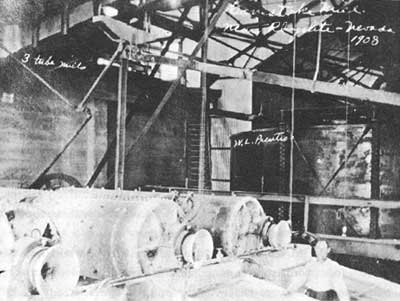
|
| Illustration 45. Another view of the interior of the Homestake-King Mill, ca June 1908. The three tube mills, used for fine grinding of the ore, are clearly visible. Note also one of the mill's large tanks to the right, and the structural steelwork of the mill building overhead. Photo courtesy of Nevada Historical Society. |
Through October, November and December of 1908, the mine and mill ran smoothly, producing a steady stream of gold bullion. Exact production figures are hard to determine. The Bullfrog Miner which seemed to have a habit of exaggerating, gave estimates of $25,000 for October, $25,000 for November and $11,000 in December. The more conservative Rhyolite Herald gave estimates for the same months as $10,000, $12,000 and $12,000. The company itself did not release monthly ore figures, but later stated that production for 1908 had amounted to $45,000 for the months of July through December. The Herald, in the meantime, took the Miner to task for publishing inflated production figures, for such practices could only hurt the district when the truth was revealed.
But whatever the exact figures, it was evident that the Homestake-King mill was a grand success. Following the lay-off of the construction workers, the company employed nineteen men in the mine and eleven in the mill, and reduced its ore at a cost of only $4 per ton for mining and milling. Since the average ore being run through the mill was worth $8.50 per ton, the company was making a good profit. The Homestake-King Mill was one of the most economical ones for its time, and had the smallest payroll for the amount of ore being milled in the Bullfrog District. With the mine and mill running smoothly, the predominate question which now affected the future of the company was the extent of its ore reserves. On November 11th, by which time the mill had been running for four months, the mine superintendent reported that the mine had. enough proven reserves to supply the mill with eighty tons per day for six more months. Needless to say, the mine was exploring for further ore reserves to lengthen that time, and had every hope that the ore ledges which it was following would continue to contain good milling ore.
Towards the end of November, with the mine and mill running at full force, the Rhyolite Herald ruefully recalled the panic of a few months earlier when the mill had shut down. So many "wiseacres, it said, had been "looking for another such an announcement as was handed out on Gold Bar, to the effect that there was nothing doing." Nevertheless, investors had been burned too often to want to put their money into another mine at this late date, and Homestake-King stock continued to slide. The panic caused by the short shut-down in September had sent stock plummeting to 204: a share, and despite a weak rise in price after the mill resumed operations, the October high was only 26¢. November saw stock in the company fall to 164: and by the end of 1908 the mine which had produced $45,000 saw its stock selling for a dismal 94 per share. There was nothing the company could do to reverse the dismaying trend. Stockbrokers were as puzzled as was the company. As one reported, "This property is now on a paying basis, and bullion shipments are regularly made. The stock, which has always gone contrary to expectations, is as low as it ever was, and it is hard to explain the slump." Even the report that the company had received patents to its property from the U.S. government could not halt the slump. [68]
There was nothing the company could do except continue milling its ore and hope for a revival of public confidence. This it did. In the meantime, the steady employment of miners and millmen in the Homestake area brought other concerns to light. An unofficial census was taken in the fall of 1908 which showed eighteen school-age children living at the Homestake-King camp. Since it was considered an extreme hardship to force those children and their mothers to live and attend school in Rhyolite, a movement was initiated to raise funds for a branch school at the Homestake. Dances, picnics and other fund-raising activities were scheduled during the last part of 1908 and the early months of 1909 to raise the necessary money. Several buildings were donated by mining companies, parents volunteered efforts, and the movement slowly build momentum.
The mine and mill, meanwhile, continued to operate, and in accordance with its new policy, submitted its annual report for publication in the Rhyolite newspapers. Although the report showed that the mine and mill were both well-equipped and operating efficiently, the company itself was not in the best of financial shape. Its account books, for the period ending on November 1, 1908, showed that the Homestake-King had expended $297,951.86 to date. Of this amount, $160,977.50 had been the cost of constructing the mill and pipeline, $86,032.90 had been expended in developing the mine and in the purchase of machinery and tools for it, and $38,936.41 had been spent in operating costs for the mine and mill since the mill had opened on July 1st. Since bullion sales from the mill had totaled only $20,116.65 between July and November 1st, it was clear that the mill was operating at a loss. As the papers pointed out, however, it was normal for a large mill to take a loss during the shakedown period, and bullion sales since November had improved, so there was little cause for worry.
The treasury stock, however, had been heavily depleted. Most of it had been pledged as security for loans to cover construction costs, which had been advanced by major stockholders in the company. As a result, the company was left with an excellent mill and a good mine, but with very little money to operate them until bullion returns improved. Accordingly, the shareholders had authorized a $200,000 bond issue at the company's general meeting during the first of December. The bonds were given to the company's creditors, most of whom were stockholders, and in return the liens were lifted from the company's treasury stock. Thus the Homestake-King hoped to be able to finance short-term operating costs from the sale of treasury stock, and to retire the new bonds from- the proceeds of bullion returns. The bonds carried a 10 percent interest rate, and were due for repayment on December 8, 1909. The interest was payable semi-annually, with the first installment due June 9, 1909. $174,227.62 worth of bonds were immediately issued, which cleared the company from all other forms of debt. Unfortunately, between the time the plan was decided upon and the end of the year, the continued fall of stock prices meant that the Homestake-King would not be able to finance as much from the sale of treasury stock as it had originally hoped.
Despite this somewhat gloomy picture of the company's finances which was revealed, the Rhyolite Herald and other papers praised the company for its open and honest policy. It was a good move, said the Herald which would "re-establish confidence" in the district, if followed by other companies. Investors, however, were not so certain, and Homestake-King stock continued to decline, ending January of 1909 at 8¢ per share.
The mine and mill continued to produce. The Bullfrog Miner estimated January's production at $16,000, and the Rhyolite Herald at $15,000, but troubles with malfunctions in the tube mills caused February's and March's figures to drop to an estimated $13,000 and $16,000. The mine, in the meantime, failed to find new ore bodies, and time began to run out on the Homestake-King. The best ore found during the month of February assayed at only $2 per ton, far too low to consider milling. In March, small bunches of rich ore were found in the lower levels of the mine, but not enough to call it a strike, and not enough to supply the mill for more than a few days. Desperately, the company decided to increase its force of miners and to sink below the 500-foot level in its search for additional ore. The mine superintendent reported that all available miners were being shifted to a search for new ore, with only a minimal force kept in the upper levels to supply the mill from the dwindling quantities of the known ore reserve.
Investors smelled doom, and Homestake-King stock hastened in its fall. Prices fell from 7¢ to 6¢ and then to 5¢ in February, and further to 4¢ in March and 3¢ in April. The stock found buyers at these low prices, but that was a small consolation to the company. Then, on April 19th, the inevitable news came. The Homestake-King mine and mill were closed. The company announced that the shut-down was for an indefinite period, but no one was deceived. Thirty miners and millmen sadly packed their belongings and prepared to move elsewhere, and Homestake-King stock immediately dropped another point, to 3¢ per share. The nine-month life of the Homestake-King mill had ended. [69]
Two days later, the Herald was able to furnish more details. In answer to telegraphic enquiries, President Milam had admitted that the directors of the company had no definite plans for the immediate future. Holders of the bond issue, however, had made no indications that they planned to forfeit on the property if the June interest payment was not made. Since the company had no hopes of raising the cash for that payment, this was good news. The mine superintendent, Milam said, had informed him that the six-month supply of ore reserves, which had been forecast last November, had been accurate. All that ore had now been milled and despite feverish explorations on all levels of the mine, no new deposits had been uncovered. Although much of the ground owned by the company was still not completely explored, the company's treasury was exhausted. Thus, unless further means of financial support were found, the Homestake-King would be unable to conduct more development work. In summary, the directors could not promise that the Homestake-King would be reopened, and the chances that it would were rather slim.
The closure of the Homestake-King mine and mill was a heavy blow to the hopes of the Bullfrog District, but the circumstances surrounding it were entirely different from those when the Gold Bar Mill had closed a year earlier. To all intents, the efforts to develop the Homestake-King into a major Bullfrog producer had been businesslike and above-board, and the Rhyolite papers paid the company its due. "Certainly the Homestake people have made a good try," editorialized the Rhyolite Herald the Bullfrog Miner, agreed, calling the company's efforts "frank and honest and conscientious." The final cleanup from the mill, made after operations had ceased, netted the company $3,200.
But the Homestake-King was not ready to give up. After all, it had one of the best reduction mills in the state, and its mine still had promise. In the short run, while the directors were searching for ways to raise more development funds, the company negotiated with several Pioneer District mines, trying to find companies willing to pay to have their ores milled at the Homestake. The negotiations fell through, however, and as the summer progressed the big mill lay idle. Stock, in the meantime, had fallen to 1 per share on May 15th, and finally disappeared altogether from the trading boards by the end of June. When the second installment of the 1908 county taxes fell due on June 1st, the beleaguered company did not have the cash to pay, and the mine and mill were transferred to the county's delinquent list. [70]
During the late summer and fall of 1909, however, it became apparent that certain minor stockholders in the company were not satisfied with the operations of the Homestake-King. Several threatened to sue, alleging that competent engineers would not have built the big mill, because not enough ore was in sight to support it during a reasonable lifetime, and that the directors had thus backed a questionable proposal. In addition, the issuance of a $200,000 bond issue when the company had only six months' known ore reserves seemed suspicious.
As the anger and frustrations of certain stockholders began to surface, the Rhyolite Herald took a more cautious tone in its assessment of the management of the Homestake-King. "No end of complications may arise when once the Homestake-King affairs are in court," it wrote, "and those who purchased this alleged gilt-edge stock at par or better will be interested to know if any crooked work was done, and on the other hand the friends of the promoters will be glad to see the affair fully aired in order to efface any suspicion which may be cast upon the good intentions of any officer or director of the company."
On October 2nd, the legal struggle commenced. Julius B. Fensterwald brought suit to recover $5,000 owed him by the company. Since the trustees of the holders of the $200,000 bond issued held a first lien against the assets of the property, Fensterwald sought to have that lien overturned, alleging various vague illegalities. As 1909 ended, the matter wound its way through the court system, without a decision being reached, and the Homestake-King, still without the means to finance further development work, was forced to miss payment on its year-end taxes.
As usual, mining suits such as this took inordinate amounts of time to become resolved. As the case dragged along in early 1910, matters were further compounded when William Kelly, another minor stockholder, also brought suit. Kelly's case was given much attention by the papers, for he had been a former member of the Homestake-King's board of directors, until being removed "by reason of the fact that he was not in accord with the methods and policies of those in control.
By July of 1910, the Herald had grown more suspicious of the Homestake-King, and suggested that the company might have dealt in fraudulent practices by releasing inflated ore figures to the press in earlier years. At the same time, the Herald also hoped for a quick solution to the court difficulties, so that the mine might be able to resume operations. The paper was so anxious to see life revived in the now-dying Bullfrog District, that it even proposed that the Homestake-King and other dormant companies be re-organized as assessable corporations, so that stockholders might be assessed to pay for exploration and development work. The plea is an indication that hard times had indeed hit the Bullfrog District, for assessment had long been illegal in Nevada, due to widespread abuses of the system during the Comstock boom years.
As 1910 stretched into 1911, the court cases slowly moved towards a decision. In the meantime, the Homestake-King mine and mill lay idle, although the company employed a watchman on the property to protect the mill building and machinery. At last, during March, Fensterwald's case was heard in Tonopah district court, and the judge rendered a decision wholly in favor of the company. All the financial and legal transactions of the Homestake-King, he ruled, had been entirely legal and above-board, and the trustees of the $200,000 bond issue held a first lien upon the property. Shortly thereafter, Kelly also lost his case, for similar reasons.
Following the conclusion of the court cases, the property of the Homestake-King was put up for auction by the county sheriff, in order to satisfy the debts of the company to the bondholders. Although this sale meant the end of the Homestake King Consolidated Mining and Milling Company, and that all stockholders in that incorporation would be left with nothing, it also meant that the new owners of the mine and mill would have a clear and unencumbered title to the property, with no debts hanging over their heads. With that in mind, rumors began to circulate concerning the future of the mine and mill. Most seemed to believe that the trustee of the bonds would buy the property himself, thus nominally keeping the Homestake-King in the hands of its previous owners, most of whom were bondholders. A. S. Dingee, the trustee, fed these rumors by declaring that the Homestake-King was not defunct and that he intended to get the property back into shape for some sort of activity.
Other rumors circulated, claiming that Tonopah and Manhattan mining concerns intended to buy the mill and move it elsewhere, but on December 9th, Dingee bought the property. Shortly afterwards, in company with former president Milam, Dingee visited the district in order to inspect the mine and mill and to discuss the possibilities of resuming work. The. two men received several offers to buy the mill, including one by a Goldfield company which had watched its mill burn to the ground, but Milam and Dingee decided to give it another go. The two announced that they would provide funds for further sinking and development work in the mine. Only when it was proven that the Homestake-King had no more ore in the ground would they consider selling the mill. Happily, with the ownership of the Homestake-King estate settled in court, Dingee was able to pay the county taxes on the property and the Homestake-King once again entered the active tax list of Nye County at the end of 1911. [71]
During the early months of 1912, Dingee and Milam made an effort to discover more ore in the mine, but had no luck. The Homestake-King mine and mill were soon back on the sale block. Rumors circulated in the following months that the mill would be sold to mining outfits from Tonopah and Hornsilver, but due to the demise of the Rhyolite Herald in June of 1912, details are scarce. The property appeared on the county tax roll at the end of 1912 as being owned by one S.H. Brady of Tonopah, but the mill was not moved. During succeeding years, it was slowly sold off in pieces, and the remainder began to deteriorate. The 1914 assessment roll lists the mill as having only fifteen stamps, indicating that ten stamps had been sold, and noted that the engine and compressor were in poor, shape. By 1918, the mill was simply assessed as an "Old Battery of 15 stamps," and was given a value of a mere $300, as compared to $10,000 only five years previously. Sadly, the Homestake-King Mill did not even have the honor of being given a second life at another mining camp, as was the usual fate of such equipment.
Brady and another man named Thorkildsen continued to hold title to the mine and mill until 1921, when the Nye County treasurer seized them for back taxes. At the time of the forfeiture, the mill equipment was still described as an old battery of fifteen stamps. B 1930, however, when the property reappeared on the active tax list, the remnants of the mill had completely disappeared--someone had appropriated the remaining equipment between 1921 and 1930.
The rest of the history of the Homestake-King is by now a familiar story. The property was purchased by Roy J. Pomeroy of Los Angeles in 1930, along with the claims of the Original Bullfrog, the West Extension and several other Bullfrog district mines. Pomeroy incorporated himself as the Rhyolite Consolidated Mining Company, and shortly thereafter sold out to D.M. Findlay of Beatty. Findlay retained title for several years, and operated the property intermittently. A 1935 report, in a minor understatement, concluded that "lack of capital is hindering developments at this property."
In 1937, the mine was described as being worked by fourteen men employed by the General Milling Company of Beatty, which had equipped it with a gas hoist, a compressor and machine drills. During subsequent years, however, the mine was reported to be idle, and Findlay sold it to C.A. Liddell in 1940. Liddell and/or lessees of his worked on the property again for several years, and finally discovered another vein of ore, such as Milam and Dingee had vainly searched for in 1912. Between 1940 and 1942, a quantity of $35 ore was hoisted from the mine and shipped out for reduction. The company reported that there was some $20 ore still in the mine, but that there was no profitable way to handle it, due to excessive transportation and supply costs.
The property was again idle in 1943, and from then until 1960, remained in the hands of Liddell. No work was done during those years, and the mine bounced back and forth between the delinquent and the active tax rolls. In 1960, Mark Leff of Beverly Hills, California, purchased the property and retained title to it until the mid-1970's when the Homestake-King Mine was finally purchased by the National Park Service and made a part of Death Valley National Monument. [72]
Total production figures for the Homestake-King mine and mill are hard to determine, due to the lack of adequate records. The Rhyolite Herald reported in 1910 that the combined production of the mine and mill had been $70,000 during its nine months of operation, but a 1943 study by the University of Nevada reduced that figure to $54,261. Using either figure, it is obvious that the Homestake-King did not produce enough bullion to pay for the costs of development and of mill construction. At least, in this case, everyone involved lost evenly, for despite the later all allegations of disappointed stockholders, it appears that the Homestake-King mine and mill were operated honestly. That in itself is a unique feature of the mine, as well as a comment upon the times in which it operated.
Nevertheless, the Homestake-King Mill, even taking the lower figures reported in 1943, stands as the fifth largest producer of gold in the entire Bullfrog District, and as the largest producer of those Bullfrog mines which are located within Death Valley National Monument. [73]
b. Miscellaneous Homestakes
Like most successful mines, the Homestake-King had its contingent of surrounding hopefuls. Outfits such as the Daisy, the Winnebago, the Trinidad and the Bullfrog Winner briefly staked out claims and attempted to find some ore. The most persistent of these companies was the Homestake Extension Mining Company, organized in July of 1906. The Extension found early indications of ore on its property, just northwest of the Homestake, and succeeded in selling a considerable amount of stock at prices up to 18¢ per share. The company promptly put its money into the ground, as good companies should, and managed to create some sizeable development works. In March of 1907, at its height of promise, the Homestake Extension had a 25-horsepower hoisting engine, an air compressor and air drills, a blacksmith shop, a bunk house, a boarding house-and an engine house. The company had completed 520 feet of development work, and reported ore values from $2 to $56 per ton.
Like so many other small mining companies which operated on a day-to-day basis, the Panic of 1907 destroyed the Homestake Extension. Its principal backers were local stock brokers and small-time mining promoters, just the type who were hurt most by the panic. With its financiers' purse strings suddenly tightened and with the general plunge in stock sales brought on by the panic, the Homestake Extension was cut off at the pass, before it really had a chance to prove whether or not it could become a productive mine. The company retained title to its claims for another two years, but no further work on the mine was possible. [74]
c. Present Status Evaluation and Recommendations
The Gold Bar-Homestake area will be nominated to the National Register. These two mines and mills are as close in proximity as they were far apart in their histories. The Gold Bar represents that all too frequent type of mining operation wherein the stockholders were taken for all they were worth, while the Homestake-King was one of the most honestly (if not wisely) run mining companies of its time. Thus the happy chance that the two properties are adjacent presents the Monument with the rare opportunity to compare and contrast the best and the worst of early twentieth-century mining history. In addition, the Gold Bar and the Homestake-King mills were the only mills built in the Bullfrog District which fall within the confines of Death Valley National Monument.
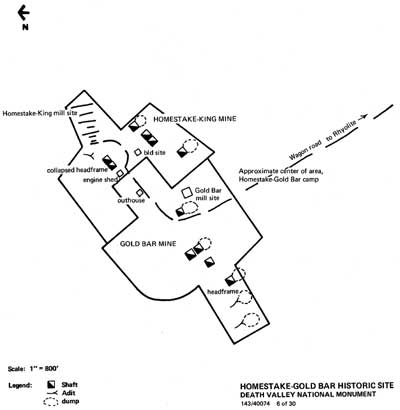
|
| Illustration 46. Sketch Map, Homestake-Gold Bar Historic Site. |
The historic structures at this complex run the range from relatively insignificant to downright impressive. The former site of the Homestake-Gold Bar camp is today marked by little more than piles of rusted cans, broken bottles, and scattered timber debris. Careful examination of the area can result in the detection of several old building sites, but to the casual observer little remains to mark the once thriving camp.
The mine sites are another matter. As usual, prospect holes, dumps and shafts dot the landscape. The Gold Bar property had at least four shafts and two adits. A crude headframe still stands over one of these shafts, but the huge ore bin and headframe of the main working shaft has disappeared. The Gold Bar Mill was long ago carted away, as described above, but the concrete and brick foundations of the mill still mark the site.
The Homestake-King ruins are far more impressive. Situated towards the top of the hill is the large working area where the main hoisting shaft of the Homestake-King was located. Extensive timber ruins of the collapsed headframe mark the spot, and the visitor can easily see the double compartment, timbered shaft under the headframe ruins. Three shafts and an adit are below the main shaft, and several more shafts may be found across the top of the ridge to the north, on the old Gold King property.
The best, however, has been saved for the last. By following the old ore road around the side of the hill from the Homestake-King shaft, one arrives at the top of the Homestake-King Mill site. Although the only remains of the mill are the concrete foundations, the very size of those foundations is utterly impressive. Six parallel rows of foundation walls step down the side of the mill for several hundred feet. Some of the foundation walls are eighty feet from side to side, and rise fifteen feet above the slope of the hill. In addition, several piles of timber debris and one large collection of used cyanide flasks may be found.
But the concrete foundations of the Homestake-King Mill, situated on the side of the hilt looking south towards Bullfrog Mountain, clearly dominate the scene. The mill foundations. are visible for miles away from the desert floor, and grow more and more impressive as one nears the site. The sheer size of the ruins, contrasted with the quiet desertion of the desert around it, forces the viewer to attempt to grasp the seemingly illogical fact that this rather isolated and desolate portion of the Nevada desert once teemed with life, activity, and hope.
The Gold Bar-Homestake complex, quite obviously, should be protected, preserved, and interpreted. The protection and preservation efforts should be centered around the mill foundations of the Gold Bar and the Homestake-King. Although both foundation sites seemed stable enough to the untrained eye of an historian, a more expert opinion should be obtained, in order to prevent any future damage to these impressive remains. The interpretation of this area, like that of the rest of the Bullfrog District which falls within the Monument boundaries, is absolutely non-existent at present. At the very least, signs or exhibits which identify the remains should be posted. At best, the vast potential interpretive value of this complex should be utilized. As stated before, this site offers the unique opportunity to compare and contrast two opposite extremes of the mining business as practiced in the early twentieth century.
As a final note, the Monument should immediately make some effort to mark its boundaries. The visitor, especially one with access to a four-wheel drive vehicle, has a choice of almost a dozen routes to take to the Homestake-Gold Bar area. Few of these roads are marked with National Park Service boundary signs, which would warn the traveler that he has entered a protected domain. Given the proliferation of souvenir and rock hunters found in this area, the marking of the boundaries is the most critical passive measure of protection which could be given to this complex.
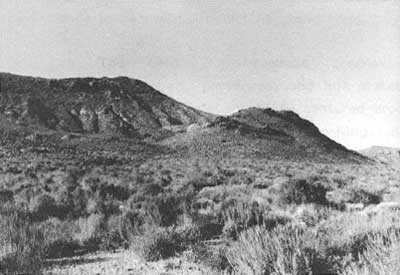
|
| Illustration 47. View of the Homestake-Gold Bar complex from the south. All traces of the camp buildings have disappeared, and the two prominent mill buildings which once dominated the scene have vanished. The Gold Bar Mill foundations cannot be seen in this view, since they are tucked behind a small ridge. In the center top are the dumps of the Homestake-King, and the mill foundations of that mine are barely visible in the shadows to the right of the picture. Compare this photo to those of 1906-1908, taken from approximately the same spot, which show the camp in various stages of activity. 1978 photo by John Latschar. |
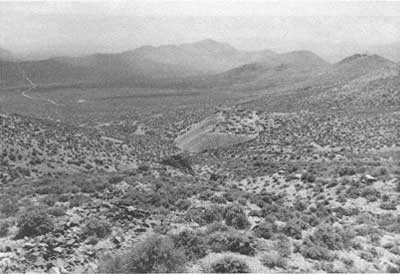 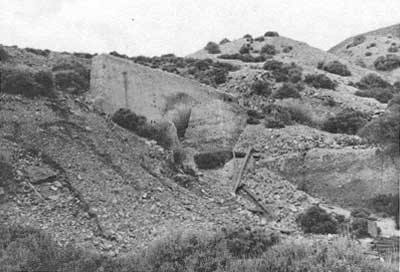
|
| Illustrations 48-49. Top: Reverse of the preceeding view, looking south from the top of the Homestake-King dump. The dump in the middle of the picture marks the former working shaft of the Gold Bar. The large gallows frame and ore bin were built on top of that dump, and the rather small foundations of the Gold Bar mill can barely be seen to the left, below the dump. The prominent wagon road in the top left of the picture leads south towards Rhyolite. Bottom: Close-up view of a portion of the Gold Bar Mill foundations. 1978 photos by John Latschar. |
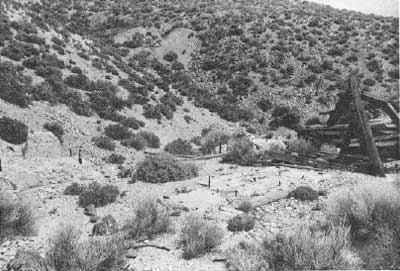 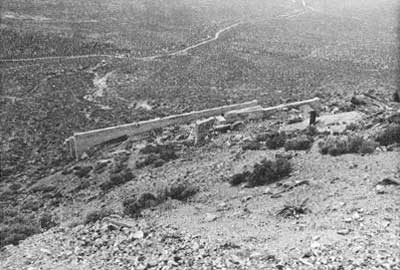
|
| Illustrations 50-51. Top: The collapsed headframe of the Homestake-King main working shaft. The old engine house, which may be seen in the 1906 photo printed above, sat in the foreground of this picture. Note the concrete and steel foundations, where the hoisting engines were mounted. Below: View of the Homestake-King Mill foundations, looking down towards the old camp site. Although depth perceptions are not evident in the photo, the mill was built on a decided slope, enabling it to utilize the force of gravity as a power supplement. 1978 photos by John Latschar. |
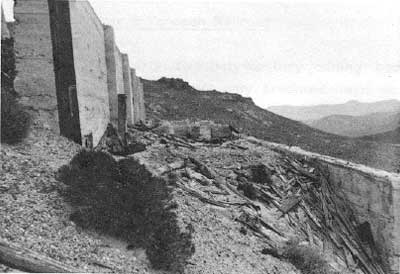 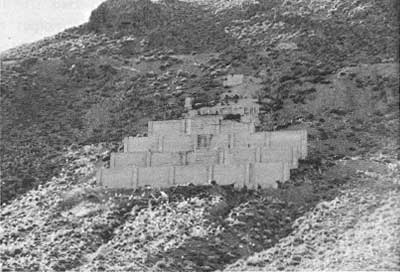
|
| Illustrations 52-53. Top: Close-up of one tier of the Homestake-King foundation walls, showing its dimensions. This wall was eighty feet in length, over fifteen feet high, and was several feet thick. Bottom: The Homestake-King Mill foundations from below. Although distances are deceiving in photographs, the distance from the bottom wall to the small concrete pedestal at the top is approximately one hundred and fifty feet. 1978 photos by John Latschar. |
7. Las Vegas & Tonopah Railroad
a. History
The early twentieth-century mining booms at Tonopah, Goldfield and Rhyolite not only produced major economic and social changes in the life of southern and central Nevada, but also brought about a major restructuring of Nevada's transportation system. As the new camps boomed and prospered, they soon outgrew the capacities of mule teams and freighters to meet their demands, and for the first time railroads were enticed into this region of Nevada. The lure of rich profits from the new camps was the catalyst which brought about the creation of new rail lines, but it was the happy geographic chance that the new camps were situated in a rough north-south line which made a new railroad link through Nevada possible.
Prior to the boom years, Nevada was served by two east-west lines which passed through the state. In the north, the original Central Pacific Railroad, part of the first continental system, served Reno. Now absorbed by the Southern Pacific, this route had been the main railroad link from Nevada to the rest of the country for several decades. In the south, the recently completed San Pedro, Los Angeles and Salt Lake Railroad connected the southern part of the state to the west coast and the Rocky Mountain region. Between Reno in the north and Las Vegas, 435 miles to the south, however, there were no rail links. Thus the fortunate chance that the new boom camps of Tonopah, Goldfield and Rhyolite appeared, in succession, in a north-south line between Carson City and Las Vegas made the possibility of the construction of new railroad line connecting those two areas a distinct possibility, the first time.
Such a railroad would cost a great deal of money, though, and the traffic volumes in the early 1900s simply did not warrant the construction of a single line. As a result, the north-south line was connected little by little by a group of independent railroads, built from one camp to another. By the time the Bullfrog boom was well underway, this process had already begun. The Tonopah Railroad Company completed its line from the north into Tonopah in July of 1904, which connected that camp with the Southern Pacific, via the Nevada & California Railway and the Virginia and Truckee Railroad. Within another year, as Tonopah and Goldfield were proven to be solid producers, and Rhyolite appeared to be following their examples, various plans were laid to continue the south-bound connections. The Tonopah Railroad became the Tonopah & Goldfield Railroad in late 1905, and shortly thereafter began construction of a line from Tonopah south to Goldfield. [75]
With the completion of a railroad to Tonopah, which was about half way between Carson City and Las Vegas, the northern half of the connection was completed. In the meantime, several plans for the southern half were beginning to take shape, at least on paper. "Borax" Smith had long contemplated a railroad which would connect his various borax mines in southern Nevada and southeastern California with the outside world, for the days of the famous twenty-mule team borax wagons had long since become economically infeasible. When Senator William Clark completed his San Pedro, Los Angeles and Salt Lake Railroad in January of 1905, Smith decided to connect his mines with that railroad at Las Vegas. Verbal agreements between Clark and Smith were reached, and Smith soon announced the formation of the Tonopah and Tidewater Railroad.
Clark, however, was also looking at the new gold camps to the north of his railroad, and slowly came to the realization that he wanted to build his own line into the interior. The agreements with Smith were thus broken and Clark announced the formation of a rival company, the Las Vegas and Tonopah Railroad. As the names implied, both these southern roads envisioned extending their lines not only to the Bullfrog district, but beyond to Goldfield and Tonopah, thus tapping the potential of all three mining camps.
Clark was the first to set to business. His engineers conducted a preliminary survey from Las Vegas to Tonopah in early 1905 and completed it late in February. The proposed line would run north towards the Bullfrog District, but would bypass the district itself by running through Beatty instead of Rhyolite. The route via Beatty would be comparatively flat and smooth, and would avoid extensive construction costs which would have been necessary to climb the mountains into Rhyolite. After several months of negotiations with Borax Smith, who was forced to shift his operations from Las Vegas on the San Pedro, Los Angeles and Salt Lake line to Ludow, California, where he would connect with the Santa Fe Railroad, construction on both roads began in the fall of 1905.
At about the same time, a third railroad entered the picture when John Brock, of the Tonopah and Goldfield Railroad, also spotted the potential of the Bullfrog District, and announced the formation of another railroad company. This one would be a nominal extension of the Tonopah and Goldfield Railroad, and would extend those lines south from Goldfield into the Bullfrog District. It soon became obvious to all parties involved, the first railroad to complete its line would have the greatest chance of success, and a race ensued.
In January of 1906, the first rails were laid on the Las Vegas & Tonopah, north of Las Vegas, and a month later the road had been completed for twenty-four miles. Although Rhyolite was ecstatic at the prospect of being connected to three railroads, the town's leaders also realized that the prestige and prosperity of the town would be threatened if rail connections were made at Beatty, four miles to the east, rather than at the metropolis itself. Rhyolite did not want to be on a branch line of any railroad, and began to take steps. After several discussions between the town and the company, an agreement was reached. The Las Vegas & Tonopah agreed to extend its line through Rhyolite, rather than bypassing the city, and the town in turn guaranteed to secure property rights and right of ways through the town. Although this change in plans meant heavy additional construction costs--the Las Vegas & Tonopah estimated that it would cost as much to build a sixteen-mile "high line" through Rhyolite and back out of the Bullfrog Hills to the north as it would to build the entire 115 miles from Las Vegas to Beatty--the town convinced the railroad that the extra expense would pay off. If the railroad ran directly through Rhyolite and the Bullfrog Hills, numerous mines would be able to ship directly on the railroad, rather than having to pay freight expenses to have their ores hauled across the hills to Beatty. Since this meant that more mines would be able to ship their ore, and that more low-grade or could be profitably shipped, the increase in freight profits for the railroad would offset the additional construction costs. Besides that, passenger traffic would be dominated by the railroad which connected directly to Rhyolite, for who wanted to go to Beatty anyway? Despite the fact that the steep grade from Beatty to Rhyolite would mean that the railroad would be forced to stop each train at Beatty and hook on additional engines to negotiate the pass, the railroad was convinced.
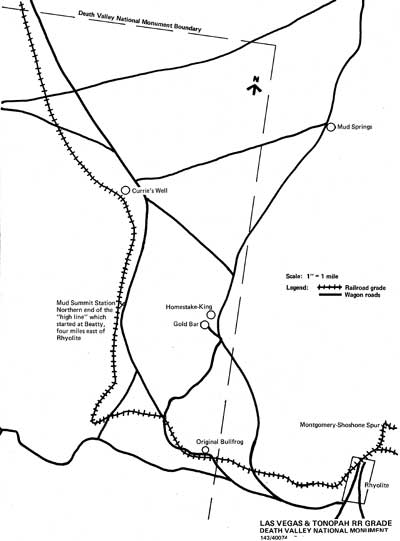
|
| Illustration 54. Sketch Map, Las Vegas & Tonopah Railroad grade. |
The Rhyolite Board of Trade put the matter to a vote of the citizens, who approved the plan. The town announced that it would provide all necessary right of ways and property rights for the railroad if it in turn guaranteed that the route through Rhyolite would be a through route, and not just a branch line. The Las Vegas & Tonopah concurred, and plans were formalized. Doubling the pleasure of Bullfroggers, the Bullfrog Goldfield Railroad, which had recently incorporated to build south from Goldfield, also announced that its terminus would be in Rhyolite. This road, however, would avoid the hilly route between Beatty and Rhyolite, and would instead build to Beatty, then swing to the south around the hills and hook back to the north, entering Rhyolite from the south.
Construction on the Las Vegas & Tonopah proceeded apace through the early part of 1906. By March, fifty-three miles of track had been laid, and graders were working eighty-four miles north of Las Vegas. To the southeast, "Borax" Smith's Tonopah and Tidewater railroad was inching out of Ludlow, but it appeared that the Las Vegas and Tonopah would win the race to the Bullfrog District. By the middle of June it had finished its grade all the way into Beatty, although the rails were still twenty-nine miles short of that town. The Tonopah and Tidewater had extended its rails seventy-five miles out from Ludlow, but the heat of the summer put a halt to its construction work. In the meantime, the Bullfrog Goldfield had finally started work on its line on May 8th, but initial progress had been slow.
The Las Vegas & Tonopah surveyed and laid out its rail yards at Gold Center, where the trains would be made up, and where northbound trains would pick up extra engines for the climb from Beatty to Rhyolite. Its future grade was surveyed through Rhyolite out to the west around the Bullfrog Hills, then back up to the north towards Mud Summit. This sixteen mile stretch, called the "high line," would constitute the most difficult part of the construction of the entire line between Las Vegas and Goldfield, for after cresting the ridge at Mud Summit, the rest of the sixty-some miles was relatively flat and smooth. The surveying of this line laid to rest recurring rumors that the Las Vegas & Tonopah would stop at Rhyolite and let the Bullfrog Goldfield handle north-bound traffic.
Grading work on the "high line" between Beatty and Rhyolite began during August of 1906, and the rails in the meantime slowly crept up the already completed grade towards. Beatty. On October 7, 1906, the first work train pulled into Gold Center on its completed tracks, and two weeks later the railroad was completed as far as Beatty. Clark had won his race, for he entered the Bullfrog District a full six months ahead of his competitors. Beatty, as usual, held a wild and grand Railroad Day Festival, and all Bullfroggers joined in the celebration, for their town was at last connected with the outside world.
In the middle of November, work on the laying of rails between Beatty and Rhyolite commenced, and on December 14, the first Las Vegas and Tonopah train pulled into the east end of Rhyolite. Freight shipments immediately followed the ceremonial first train, and long awaited carloads of lumber, supplies and mine and mill equipment began to arrive. The completion of the railroad freed the Bullfrog District from the exorbitant freight rates necessitated by long mule-team hauls over the desert, and a veritable building boom got underway, as Rhyolite began to change from a tent city to a more permanent town. Within a week of the arrival of the first train, over one hundred cars stood on the yard tracks in Rhyolite, and more were coming in each day. As soon as the confusion was somewhat cleared, the Las Vegas & Tonopah extended its track through town, before putting a halt to the laying of rails. Further construction, it announced, would await the completion of grading work in the vicinity of Goldfield.
In March of 1907, the first regular Pullman service between Los Angeles and Rhyolite was inaugurated, with daily trains. Grading work around Goldfield progressed, and the town of Rhyolite breathed a sigh of relief as it became evident that it would indeed be on the main line of the railroad, and not be left dangling at the end of a branch line. Then, in April, the Bullfrog Goldfield Railroad finally finished its line into Beatty. Although the event was not met with nearly the degree of enthusiasm which had heralded the arrival of the Las Vegas & Tonopah, it actually had much more significance, for the north-south rail line through Nevada was now complete. True, it was necessary for passengers to change trains five times between Carson City and Las Vegas, but for the first time it was possible to make the trip in relative comfort and speed.
By the end of May 1907, grading of the Las Vegas & Tonopah line to Goldfield was almost complete, and work began again on the laying of the tracks. During June the railroad slowly extended itself out of Rhyolite, around the Bullfrog Hills, and to the north towards Goldfield. By the middle of August, the rails were completed through the entire Bullfrog District and were extended as far north as Bonnie Claire, a third of the way between Rhyolite and Goldfield. Construction continued despite the financial problems brought about by the Panic of 1907, and on October 26, the ceremonial final spike was driven at Goldfield, marking the completion of the Las Vegas & Tonopah tine. Few citizens, however, were in a mood to celebrate.
Four days later the Tonopah & Tidewater Railroad entered Gold Center from the south, and linked its tracks with those of the Bullfrog Goldfield. Not surprisingly, the two railroads soon announced plans for joint cooperation, and Goldfield and the Bullfrog District were thus served by two complete southern lines. Potential passengers and shippers could travel the Las Vegas. & Tonopah all the way from Goldfield to Las Vegas, where connections to the west coast and the Rocky Mountains were possible, or they could take the Bullfrog Goldfield to Beatty and switch there to the Tonopah & Tidewater for the trip to Ludlow, California, with similar east-west connections at the southern terminus. Although the Las Vegas & Tonopah had been the first railroad to arrive in the district, the Tonopah & Tidewater immediately gained an advantage over its rival, for the latter's connections to, the west coast were quicker and more economical. The Las Vegas & Tonopah countered by advertising that its route went "all the way" and that passengers would be spared the necessity of changing trains in Beatty.
Now, that the race was over, the competing roads settled down to business--hoping that the market for hauling in supplies and equipment and hauling out ore would justify the costs of construction. The Las Vegas & Tonopah concentrated on improvements to its property, including the rail yards at Rhyolite and its passenger station, which was finished in June of 1908. Although events would prove that passenger traffic never warranted the construction of such a large station, the company reaped short-term benefits of publicity for being the owner of what was rightly called one of the showplaces of the southern Nevada desert.
Unfortunately, traffic volumes on all the railroads serving the Bullfrog District proved to be lighter than expected, since the district never became the producer as had been predicted during the early years of the boom. The Las Vegas & Tonopah made a small profit during the first year of operation, but that was the last year that it did. Due to its decision to utilize the "high line" in order to tap the mines of the Bullfrog Hills, the Las Vegas & Tonopah was saddled with heavier operating expenses than were its rivals, since all northbound trains were required to stop at Beatty and add an extra engine in order to negotiate the climb into Rhyolite. The ore from the high line never reached the predicted levels, and thus the railroad was left with the excessive costs of construction, without the ensuing profits from heavy ore shipments.
Although both the Bullfrog Goldfield and the Tonopah & Tidewater were experiencing much of the same problems, their shorter and cheaper route to the west coast helped them maintain higher shipping volumes than the Las Vegas & Tonopah was able to manage. In addition, "Borax" Smith had a monopoly upon the shipment of ores from his borax mines along the route of the Tonopah & Tidewater, which helped the revenues of that road considerably. As a final burden, the railroads were burdened with poor public relations. Almost as soon as the railroad days celebrations were over, miners and businessmen began complaining about the high freight rates charged by all the lines. As the mines developed into very low-grade propositions, freight rates announced in previous years began to look like highway robbery. Although the miners had a small point, for the prevalent rates made many mines unprofitable, most of the Bullfrog District mines would have had to be given free shipment of their ores in order to stay in business. Although all the railroads lowered their rates from time to time, no one was ever satisfied. The sentiment that the railroads were making huge profits seemed to predominate from Rhyolite to Tonopah, and as a result, the property of their lines were heavily taxed. The Las Vegas & Tonopah, for example, paid taxes to Nye County amounting to $11,942.70 at the end of 1907. [76]
To make a sad story short, the Bullfrog railroads--and in particular the Las Vegas & Tonopah--declined in direct ratio to the decline of the Bullfrog District. Passenger and freight traffic fell off as mines closed and miners left town. The exodus had a ripple effect, for a smaller population in the district meant that fewer supplies were hauled in to support the remainder. A similar story was affecting the gold camps to the north, for although both Goldfield and Tonopah far out-lived Rhyolite, mines in those northern camps had passed their peak by the 1910s and were beginning what would be a much longer period of decline. In 1911 the Tonopah and Goldfield Railroad offered to sell its line to the Las Vegas & Tonopah, thus giving the latter a direct line through most of Nevada. Senator Clark was interested, but following the death of his son on board the Titanic in April of 1912, he turned apathetic towards business affairs, and the matter was dropped.
Matters were now becoming serious, and it became evident that unless the three competing lines were somehow consolidated, that all three would fail. The smallest of the three, the Bullfrog Goldfield, was the first to take action, but its attempt to sell itself to the Tonopah and Goldfield Railroad fell flat. The Las Vegas & Tonopah then stepped in and the two railroads made plans to consolidate their lines. Since both roads had tracks running between Beatty and Goldfield, the decision was made to utilize the best parts of each line, and to abandon the remainder. Accordingly, the Las Vegas & Tonopah tracks would be used from Goldfield to a point just south of Bonnie Claire, where a shift would be made to the Bullfrog Goldfield tracks from there south to Beatty. This move would cut maintenance costs for both lines, and would enable the Las Vegas & Tonopah to avoid running its trains over the costly "high line" from Beatty through the Bullfrog Hills. Through service would run through Beatty, bypassing Rhyolite completely, although that town would still be served by a short branch line. All the track west and north of Rhyolite, however, which includes the section of track which ran through the present boundaries of Death Valley National Monument, was abandoned.
The plans were approved by the Railroad Commission of Nevada, despite the protests of Rhyolite citizens, and the new combined route went into effect in June of 1914. For the first time, the Bullfrog Goldfield Railroad made a profit--ironically, much of it came from hauling ripped-up tracks and ties from its old roadbed north to Goldfield for salvage. The Las Vegas & Tonopah, however, was not so lucky, and continued to run in the red. Service over the remaining portion of the "high line" from Beatty to Rhyolite was finally discontinued in 1916, and the rails were removed. [77]
As the years slowly passed, revenues and traffic on the Las Vegas & Tonopah continued to decline. Daily service between Las Vegas and Goldfield was maintained until February of 1917, when tri-weekly service was substituted. Then, the problems brought about by World War I spelled the end of the line. Due to war shortages and efforts to economize, the Freight Traffic Committee of the U. S. Railroad Administration ordered that all perishable and merchandise traffic which formerly traveled via the Las Vegas & Tonopah would immediately be shipped only on the shorter Tonopah and Tidewater connections to the west coast. In other words, the Las Vegas & Tonopah was not allowed to haul anything but ore, and there was not much ore to be hauled. For a short while, the railroad was run by the Railroad Administration, but that body soon decided that the Las Vegas & Tonopah was "not considered essential or necessary to the uses of the Government," and was turned loose.
By this time, it was a moot question whether the railroad was essential or necessary to anyone, and the end soon came. The Las Vegas & Tonopah had lost money every year since 1908, but never enough to make it consider abandonment of its lines. Revenues now plunged drastically and the road was faced with bankruptcy. The high prices paid for scrap metal during World War I stimulated Clark to salvage as much of his railroad as he could, and on September 18, 191-8, he applied to the Railroad Commission of Nevada for permission to cease operations. On October 31st, the last train pulled off the line and the tracks were taken up and sold. With the demise of its line, the Las Vegas & Tonopah also abandoned its passenger station in Rhyolite, and one of the last surviving structures in that dying town entered the delinquent tax list. [78]
Following the death of the Las Vegas & Tonopah, the Bullfrog Goldfield Railroad returned to its old partner, the Tonopah & Tidewater, and the two roads combined operations. For all practical purposes, the Tonopah & Tidewater operated the line for the entire distance from Ludlow to Goldfield, for the Bullfrog Goldfield had almost no rolling stock or engines left. Nevertheless, the railroad continued to operate as long as the Goldfield mines operated. As the 1910s gave way to the 1920s, those mines began to close down one after another, and revenues on the Bullfrog Goldfield slowly and surely declined. Finally, in January of 1928, that railroad was also abandoned.
Thus the Tonopah & Tidewater, which had been the last railroad to reach the Bullfrog District, was left as the last and only railroad operating in the vicinity. As the gold mines in the region began to play out, the Tonopah & Tidewater relied more and more upon its borax mines in the vicinity for revenue. Other scattered clay, marble and talc mines contributed enough freight to enable the railroad to operate feebly through the 1910s and the 1920s, and the road became a life line to the scattered population of the southern Nevada desert.
But towards the latter part of the 1920s, the borax mines began to close, and the life of the Tonopah & Tidewater was threatened. The Borax Consolidated Company, the parent of the Tonopah & Tidewater, continued to operate the road at a loss, preserving the rails and stock in case of future need, but heavy losses year after year became too much for it to handle. In 1938, the Tonopah & Tidewater applied for permission to abandon its lines. Local patrons of the road caught the ears of their politicians, and approval of the abandonment was delayed for several years, as means were sought to keep the line operating. But those efforts were ultimately unsuccessful, and on June 14, 1940, the Tonopah & Tidewater ceased operations. The railroad tracks were left in place for two years, in hopes that the railroad could resume, but the need for scrap metal during World War II caused them to be salvaged in 1942 and 1943. The last Bullfrog district railroad had finally died.
The demise of the railroads did not end their influence upon the transportation history of southern Nevada, for during the early days of highway construction in that state, the old roadbed of the Las Vegas & Tonopah was designated as part of the state highway system. When construction of U. S. route 95 between Las Vegas and Carson City began, which was the first major north-south highway through the state, the road was built along the old grade of the Las Vegas & Tonopah from Las Vegas to Beatty. Today, the traveler heading north out of Las Vegas towards Beatty and Carson City will travel along the same line which carried so much hope and optimism during the days of the Bullfrog boom.
b. Present Status Evaluation and Recommendations
Due to the use of the old Las Vegas & Tonopah grade as a base for highway 95, all traces of the railroad bed have disappeared between Las Vegas and Beatty. Still visible to the visitor, however, is the old "high line" which ran from Beatty into Rhyolite and then through the Bullfrog hills to the north. This portion of the road, which was the first part of the railroad to be abandoned in 1914, winds for twelve miles through Death Valley National Monument. For most of this distance the old grade is clearly visible against the desert floor, and with its cuts and fills is in quite good condition, considering the ravages of time and weather.
With a few exceptions, today's visitor may walk or drive on the old roadbed from Rhyolite to the Original Bullfrog Mine, up through the cuts towards Mud Summit, north to Currie's Wells and on north out of the Monument's boundaries. The walk is a haunting one, for while tracing the route on its lonely way across the desert landscape, one can almost he the whistle and rumbles of trains gone by. Just north of Mud Summit, more concrete evidence of the past may be found in the ruins of an old section camp. Here, where the helper engines were dropped after the trains had climbed the grade up the "high line," may be found the site of several edifices which supported the railroad. Concrete foundations, a ground cistern and what is probably the foundations of an old water tank mark the spot. While there is not enough left at the site to make it particularly significant in itself, its location along the railroad grade makes it worthy of protection.
That portion of the Las Vegas & Tonopah Railroad grade which winds its way through Death Valley National Monument will be nominated to the National Register. The construction of this railroad had regional as well as local significance, since it formed a major part of the first and only north-south rail line through the state of Nevada. Although the section within the Monument boundaries was abandoned before the Las Vegas & Tonopah itself folded, the fact that it constitutes a major portion of the remaining visible grade makes its preservation important.
The story of the Las Vegas & Tonopah should be interpreted for visitors, in order to introduce to them the role which railroads played in the life and death of early twentieth-century mining camps, and the grade itself should be protected. In itself, the site of an abandoned railroad grade is as startling and as nostalgic a reminder of the dead hopes of bygone eras, when men attempted to wrestle a fortune from the forbidding deserts of southern Nevada, as is the lonely Homestake-King Mill foundations standing guard over a deserted desert.
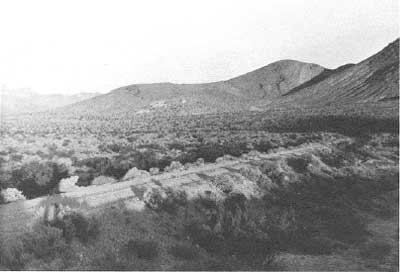 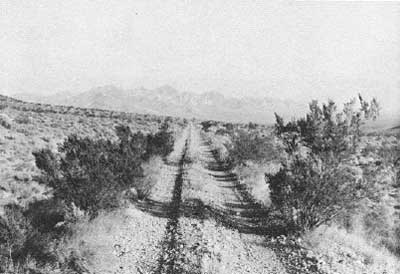
|
| Illustrations 55-56. Top: Las Vegas & Tonopah Railroad grade, looking west towards the Original Bullfrog Mine from a point approximately one mile east of the Death Valley National Monument boundary line. The dumps of the Original Bullfrog are barely visible in the center background. Bottom: Portions of the railroad grade, looking southeast from the point where the Hometake-Gold Bar wagon road leaves the railroad, about 2 miles northwest of the Original Bullfrog. The grades in these two pictures are clearly marked, as they have been used for many years as auto roads. 1978 photos by John Latschar. |
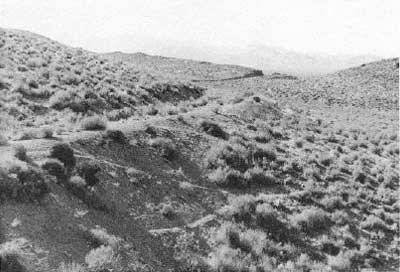 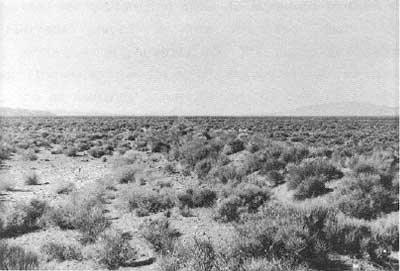
|
| Illustrations 57-58. Top: A portion of the Las Vegas & Tonopah grade, looking northwest from Currie Well. Notice the fill in the background, and the cut through the small ridge in the background. Bottom: The grade runs straight as an arrow once it leaves the hills and valleys of the Bullfrog district. In this photo, taken two miles north of Currie Well, the road bed may be discerned as it meets the horizon in the background. This portion of the grade is less obvious, since it has not been used as an auto road. 1978 photos by John Latschar. |
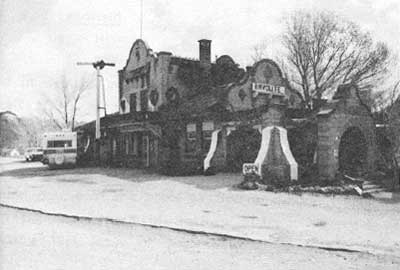 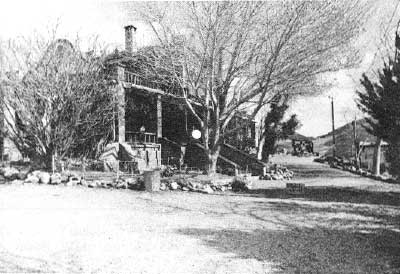
|
| Illustrations 59-60. Top and bottom: Front and rear view of the Las Vegas & Tonopah passenger station in Rhyolite. Since the demise of the railroad, the station has been used variously as a private residence, a casino, a gift shop, and a restaurant and bar. Although the structure is now in good condition, the present owner is very old, and local residents have no idea what will happen when she dies. Although the station itself is structurally intact, numerous changes have been made. The trees surrounding it, for example, were no more than seeds during the highlight of Rhyolite. 1978 photos by John Latschar. |
8. Leadfield
a. History
The ghost town of Leadfield has become identified in western mining lore as an example of fraud, deception and deceit at its worst. Located in the middle of Titus Canyon about twenty-two miles west of. Beatty, Leadfield boomed briefly in 1925 and 1926. The extensive promotion which surrounded the camp, the unsavory character of its chief promoter, and the swift and sudden demise of the boom has led to unkind treatment at the hands of popular writers of western history. Betty J. Tucker, writing in a 1971 issue of Desert Magazine is a good example:
This town was the brain child of C. C. Julian, who could have sold ice to an Eskimo. He wandered into Titus Canyon with money on his mind. He blasted some tunnels and liberally salted them with lead ore he had brought from Tonopah. Then he sat down and drew up some enticing, maps of the area. He moved the usually dry and never deep Amargosa River miles from its normal bed.
He drew pictures of ships steaming up the river hauling out the bountiful ore from his mines. Then he distributed handbills and lured Eastern promoters into investing money. Miners flocked in at the scent of a big strike and dug their hopeful holes. They built a few shacks. Julian was such a promoter he even conned the U. S. Government into building a post office here. [79]
So goes, the usual, tale, which is fairly well duplicated by most writers of popular lore over the past forty-odd years. The true story, however, is somewhat different. Although Leadfield did set a record of sorts for being one of the shortest-lived towns in western mining history, there was more to it than merely an out-and-out stock swindle. Nor can C. C. Julian be blamed solely for the life and death of Leadfield.
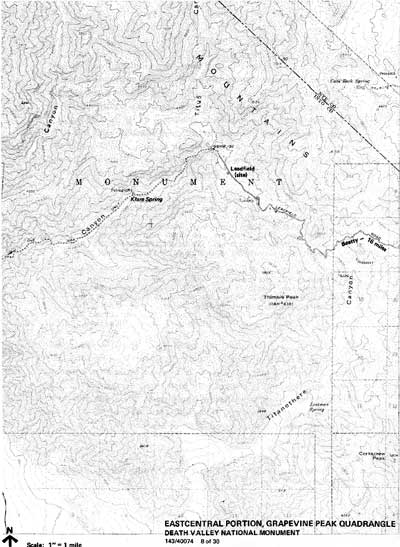
|
| Illustration 61. Map of Leadfield area. |
Leadfield, in fact, had ore from the beginning, which was in 1905, not in 1925. During the early days of the Bullfrog boom, Titus Canyon, like most of the territory surrounding the Bullfrog District, was examined by hopeful prospectors. In the fall of that year, W. H. Seaman and Curtis Durnford staked out nine lead and copper claims in the canyon,. and came into Rhyolite with ore samples that assayed as high as $40 to the ton. The prospectors were soon bought out by a consortium headed by Clay Tailman, a local attorney and promoter, and the Death Valley Consolidated Mining Company was incorporated. The company immediately began a development and promotional campaign, and shares of its stock were sold for 2-1/2¢ each.
As usual, the news of the strike stimulated other prospectors and companies to get in on the potential bonanza, and claims were filed for miles around the Death Valley Consolidated property. The Bullfrog Apex Mining & Milling Company, for example, which we have already seen trying to exploit ground near the Original Bullfrog, purchased a group of four claims next to the Death Valley Consolidated. The former company, in the meantime, went to work, and as initial prospects looked encouraging, the price of the stock rose to on the local exchanges.
By May of 1906, the Death Valley Consolidated had progressed far enough to start, taking out its better ore for shipment to the smelters. The company soon realized,, however, that the long and arduous trip between its mine and Rhyolite and the high freight rates prevalent between Rhyolite and the far-off smelters, made the shipment of its ore absolutely unprofitable. As a result, the company ceased operations, and after a brief six-month long life span, the Death Valley Consolidated Mining company disappeared. [80]
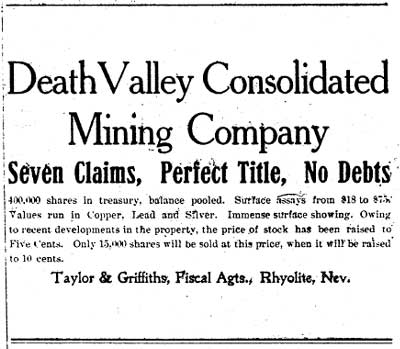
|
| Illustration 62. Advertisement from the Rhyolite Herald, 23 March 1906. |
So matters stood for almost twenty years. Then, in March of 1924, three prospectors named Ben Chambers, L. Christensen and Frank Metts wandered into the canyon and began to stake out numerous claims on some lead deposits which they found. The three men 'worked their claims for over a year, before selling out to a local promoter named John Salsberry. Salsberry had been involved in Death Valley mining since the Bullfrog days, and was a former promoter of several mines on the west side of the valley, including some in the Ubehebe Mining District in the early 1900s, and the Carbonate Mine in the 1910s. Salsberry purchased twelve claims from the three prospectors and a few weeks later formed the Western Lead Mines Company, with 1,500,000 shares of stock worth 10¢ each. Salsberry extended the prospecting work in the district and by the end of 1925 the Western Lead Company had accumulated over fifty claims in Titus Canyon and had started to work. A compressor plant was installed to power the company's air drills, and eighteen men and six trucks began to build a long and steep auto road out of Titus Canyon towards the Beatty highway.
In January of 1926, the company built a boarding house, and began to lay a pipe line from Kiare Spring, two miles down the canyon, to the mine site. The young camp was entering the boom stage. Following an enthusiastic Associated -Press report on the new camp, the Inyo County Recorder reported that location notices were pouring into his offices. By January 30th, the town had been officially named Leadfield, and half a dozen mining companies were in operation. Sales of the stock of Western Lead Mines Company were opened on the San Francisco exchange in late January, and within twenty-four hours 40,000 shares had been sold, with the price soaring to $1.57 per share.
Eastern California, and especially Inyo County, was long overdue for a mining boom, and it seemed that the entire county jumped on the bandwagon. Hard times had begun to depress the county's economy, and this new boom was just the shot in the arm which the local merchants had been waiting for. Likewise, Beatty, on the other side of the state line, began to experience a' revival in its economy, and the small railroad town, which had barely eked out an existence since the collapse of the Bullfrog boom, found itself as the new supply metropolis for the miners and companies swarming into Leadfield. No one was willing to look this gift horse in the mouth, and no one questioned the reality of the new boom--to do so would mean a swift ride out of town on a pole as a "knocker."
Then, in early February, came the announcement which seemed to assure the future of Leadfield. C. C. Julian, the "well known oil promoter of Southern California, who had been much in the limelight of late years on account of his spectacular oil operations," had bought into the Western Lead Mines Company, and was its new president. With the backing of such a successful and skilled promoter, Leadfield seemed assured of obtaining the necessary financial support to take it from a prospecting boom camp into a producing mine town. The Inyo Independent greeted the arrival of Julian with a glowing description of his character and abilities. "Julian is recognized as one of the greatest promoters of the country and it is a certainty that with his enthusiastic backing that something will come of Leadfield if there is anything there. Quite a different endorsement would be printed in later years, after the mines had folded and everyone was looking for a scapegoat. [81]

|
| Illustration 63. Life in the early days of a boom camp was always hectic, and a man had to sleep whenever and wherever the opportunity presented itself. Although this photo is undated, the proliferation of autos and the construction in the background indicates that it was taken during the early days of the boom. Photo courtesy of Death Valley National Monument Library, #8189. |
The boom was now on in earnest. During February, the Western Lead Company was reported to have a hundred men working in its mines and on the Titus Canyon road, and talk of building a 500-ton mill was heard. When the road was completed in late February, a steady stream of trucks began entering the canyon, carrying timber, machinery and supplies. The Western Lead Company expanded its payroll to 140 men, and at least six other companies were engaged in serious mining. Average values in the tunnels of the Western Lead Mine were 8% to 30% lead, with seven ounces of silver to the ton, more than enough to make the mine a paying proposition if the ore held out as exploration continued.
The California State Corporation Commission, however, was not so impressed with the company, which had failed to secure a permit before it began selling shares of stock. Rumors of investigations by the Commission raised the righteous indignation of local folk, who refused to allow anyone to try to prick their balloon. The local attitude of Inyo County was well summed up by the Owens Valley Herald
. . . the State Corporation Commission is using its every endeavor to try and prejudice the people against this latest promotion of Julian's. This commission has never sent a man into the Leadfield district to look it over, and it would appear that the stand they have taken is purely spite, just because Julian at one time refused to be dictated to by arrogant members of that Commission. The Commission does not seem to realize that in the stand they are taking that they [are] trying to hinder the development of the resources of this State, and the Commission also does not seem to realize that such arbitrary methods have no place in any development anywhere.
After all, the paper pointed out, Julian was not trying to swindle anyone. He had started a promotional campaign with full-page advertisements in the Los Angeles papers, but he clearly underlined the risks involved. "In the advertisements that he has recently been running in Los Angeles papers he has told in plain words just what he thought of the proposition and has advised people who could not afford to take a gamble not to buy any stock in it--for, as is well known, all mining development is a gamble." In addition, Julian had publicly invited any reputable mining engineer in the world to make a visit to the Leadfield District. If he did not find conditions as stated by Julian, then all expenses of his trip would be paid. In spite of the interference by the Corporation Commission, the paper concluded, "the future of Leadfield seems very bright, and it would not be at all surprising if the mines there did not turn out to [be] the biggest lead producers that the world has ever known." This Inyo County newspaper, obviously, reflected the attitude of the citizens--they desperately wanted and needed a mining boom, and the last thing they wanted was the over-zealous interference of the State of California.
As the paper could well have pointed out, Julian was far from being the only promoter singing the praises of the Leadfield District, for numerous other companies were also trying to cash in on the boom. Such companies, by March of 1926, included the Leadfield New Roads outfit, presided over by Walter J. Frick, who announced that his company had good shipping ore in its tunnels, and would begin regular ore shipments soon. This company had just built a mine office on its property, and was bringing in additional machinery in order to rush the development work. Other companies in business included the Burr-Welch, the Leadfield Carbonate, the Joplin and the Joplin Extension companies, the South Dip mine, the Leadfield Metals, the Last Hope, the Cerusite, the Sand Carbonate and several others. There was, of course, a company called the Western Lead Extension, in the best traditions of mining booms.
But the Western Lead Mines Company, Julian's pet, was leading the pack. It was forging ahead with its development work, with one of its tunnels six hundred feet inside the mountain. The company purchased a 180-horsepower Fairbanks-Morse diesel engine in March, as well as a second air compressor to power its machine drills. The town of Leadfield was also trying to keep pace with the boom, which was attracting miners from all over the country, and announced that a large hotel would soon be built. The cosmopolitan nature of the boom was emphasized in early March, when eighteen former Alaskan miners sat down in Leadfield for a reunion dinner. [82]
Then on March 15th, came the day which put Leadfield on the map, when the first of Julian's promotional excursions pulled into Beatty. A specially-chartered train pulled into the sleepy town on Sunday morning and disgorged 340 passengers, who had been chosen from among the 1,500 who applied for the trip. Together with another 840 visitors from Tonopah and Goldfield, the entourage overwhelmed Beatty until loaded into ninety-four automobiles for the trip through Titus Canyon into Leadfield.
After bumping over the spectacular new road and down into Leadfield, the visitors were served a sumptuous outdoor feast by the proprietor of the local Ole's Inn, who reported that he dished up 1,120 meals. The dinner was served to music provided by a six-piece band imported from Los Angeles. Lieutenant-Governor Gover of Nevada gave the key-note speech, ridiculing the persecution of Julian by the California Corporation Commission, and praising Julian for overcoming the numerous obstacles which modern governmental bureaucracies put in a man's path. Several other speeches followed, including one by Julian, voicing much the same opinion. During the afternoon the Tonopah orchestra played for those who wished to listen or dance (twenty-four women had come on the train), and the more serious visitors were conducted on a tour of the Western Lead Mine by John Salsberry. The mine, said Salsberry, was still in the early stages of development, but more serious work would get under way with the arrival of over $55,000 worth of machinery which the company had recently ordered. The visitors were then driven back to Beatty for another night of partying, before going home. The trip, obviously, was a big success, and Western Lead stock advanced 25¢ on the San Francisco market the next day.
The Leadfield boom was now in its height. Plans were announced to build a forty-room hotel, and a week after the grand excursion the town had its own newspaper, the Leadfield Chronicle By the end of the month of March, Western Lead stock had soared to $3.30 a share, and over 300,000 shares in the company had been sold. In addition to the general public, ore buying and smelting concerns were becoming interested in the camp, and several sent representatives to the district to discuss reduction and smelting rates. The Tonopah & Tidewater Railroad, eager for more business, also sent representatives to Leadfield, in order to estimate the amount of ore which the mines might be sending over its tracks. [83]
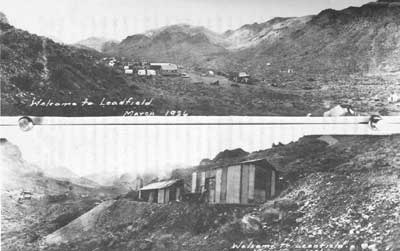
|
| Illustration 64. Two views of Leadfield, taken in March of 1926. The top view looks up the canyon to the northwest, and the bottom from the opposite end of the canyon, looking southeast. The buildings in the foreground of the bottom view belong to the Western Lead Mines. Company. Photo courtesy of Special Collections Library, University of Nevada, Reno. |
In the months following the great train excursion, Leadfield continued to develop. More companies, including the Western Lead Extension, were given permission to sell their stocks on the exchanges of various states, and several, including the New Roads Mining Company, began to sort their high-grade ore for shipment. Salsberry, manager of the Western Lead Company, announced plans to build a 400-ton concentration plant at Leadfield, and new'" mining companies, such as the Western Lead Mines Number Two, opened for business. Since it cost $18 per ton to haul ore from Leadfield to the railroad terminal at Beatty--which prohibited the shipment of most of the ore--local operators began to call for an extension of the railroad to Leadfield. The Tonopah & Tidewater, however, coldly replied that definite "plans for building a railroad spur into Leadfield have not been made, as present business does not warrant its construction."
During April, the town continued to grow. The new 180-horsepower diesel engine for the Western Lead Mine arrived and was placed on its concrete foundation near the portal of the main tunnel, next to the twelve-drill air compressor. The machines, unfortunately, were not put into immediate use, due to delays in the shipment of fuel oil. The New Roads Company, Western Lead's greatest competitor, continued to sack its high grade ore for shipment, and its new air compressor and air drills arrived. Then, on April 30th, the townsite of Leadfield was officially surveyed, and the town's plat was submitted to Inyo County officials for approval. The ambitious plat showed 1749 lots, arranged into 93 blocks. The central street was aptly named Salsberry street, while the least desirable lots, which sided upon a small ravine, were also aptly named Poverty Gulch. Significantly, all the land upon which the town was platted was upon the claims of the Western Lead Company, which donated that land to the townsite company. Although their names do not appear, it thus is obvious that the directors of the Western Lead Company were working closely with the directors of the townsite organization. The plat was approved by Inyo County officials the following month.
But in the meantime, the State of California was breathing hard upon Julian's neck. The Corporation Commission hauled a brokerage company into court for selling Western Lead stock without a state permit. The company argued that the stock which it had sold was not treasury stock of the Western Lead Mines, but was Julian's personal stock in the company. The former required a state permit, but the latter did not. Expert witnesses were called to testify, and according to the Tonopah Mining Reporter, fifteen to twenty qualified mining engineers and geologists testified that the Western Lead Mine was a quite legitimate proposition. "No testimony, except that of two engineers for the commission, was unfavorable." if the sale of stock was found to be illegal in California, the paper said, sales would merely shift to Western Lead's offices at Reno, from which California buyers could telegraph their orders.
But the continued investigations by the state of California began to hurt the sales of Western Lead stock, and another factor began to take a toll. Shortly before Julian had become involved in Leadfield, he had sold his controlling share in the Julian Petroleum Company to a former partner. His former partner shortly thereafter had engaged in a fraudulent overissue of Julian Petroleum stock, which soon caused that company to collapse. Although it appears that Julian had nothing to do with that affair, his name was firmly linked to the petroleum company in the public mind, and his credibility began to shrink. In one two-day period, the price of Western Lead dropped 175 points on the west coast trading boards, and the company never recovered from the panic which set in. [84]
Nevertheless, Julian, the Western Lead Mine, and the numerous other mining companies involved in the Leadfield boom continued to pursue their exploration and development works. Late in May, the sixteen men working in the New Roads Mining Company opened a good strike of lead ore. At about the same time, Julian bought into that company, which gave him control of the two largest mines of Leadfield. With both the New Roads and the Western Lead companies showing steady improvement, Julian announced definite plans to construct a large milling plant at Leadfield.
As summer approached, the Leadfield boom showed no signs of peaking. More companies came into the district and began operations, including the Boundary Cone Mining Company, the Pacific Lead Mining Company, and several others. The new companies found favorable public response on the west coast stock markets at first, for the continued boom in Leadfield made it appear that the California Corporation Commission was indeed playing a sour grapes role. The district even showed signs of becoming a producer, as the New Roads Company announced that its first shipment, consisting of two or three carloads of $50 to $90 ore, would soon be ready.
The Corporation Commission, however, had other ideas, and in late June of 1926, ordered that sales of Julian's personal stock in the Western Lead mines must immediately cease on the Los Angeles stock exchange. The decision was made due to "the evidence introduced at the hearing. . . that the sale of shares of the capital stock of the Western Lead Mines Company, a Nevada corporation, in the State of California, would be unfair, unjust, and inequitable to the purchasers thereof." It is interesting to note, in light of the heavy criticism which Julian has received in later years, that the commission was careful to omit any reference to any fraudulent or illegal activities on the part of Julian.
But despite this heavy blow to the financial fortunes of Julian, developments at Leadfield proceeded. The Mining Journal a respected Arizona publication, printed a long detailed report on the Leadfield District in July, which helped to restore public confidence. "Indications are that the lead deposition in the Grapevine Mountains along the edge of Death Valley is one of the large deposits of the west and one that can be made commercially a factor in the lead production of the country." Once again, private and uninterested geologists and engineers seemed to be indirectly accusing the Corporation Commission of persecuting Julian. The mines agreed with the independent experts and continued to work. The Burr Welch Mine reported the location of new ore deposits, and the Boundary Cone Mining Company ordered and installed a new 25-horsepower hoist and headframe. The new plant had a lifting capacity of 500 tons per day, and the company increased its work force to twelve miners. The New Roads Company let a contract for the driving of another 100 feet in its main tunnel, and announced plans for early ore shipments.
At the same time, during late July, the Western Lead Mining Company and its president, C. C. Julian, brought a $350,000 damage suit against the Los Angeles Times and the California Corporation Commission, saying that the paper and the Commission had slandered Julian and the company without due cause and without sufficient evidence. The suit, however, was quickly thrown out of court for insufficient cause, "it being the duty of the corporation commission to investigate stocks and securities offered for sale in California."
During August, another new mining company, the Pacific Lead Mines No. 2, was incorporated and began work. The California Corporation Commission gave this company permission to sell its stock, 1,000,000 shares of which were offered to the public at 254 each. This decision was important, for it indicated that the Commission had finally been persuaded that Leadfield itself was a legitimate mining boom. The Commission would allow the sale of stock in Leadfield companies which were not controlled by Julian. In the meantime, the U.S. Postal Service had also decided that Leadfield was a family permanent mining camp, and on August 25th a post office was. opened in the young town.
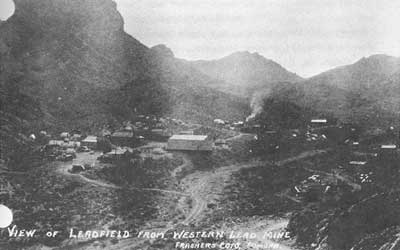
|
| Illustration 65. View of Leadfield, looking southeast down Titus Canyon from the Western Lead Mine. Undated, ca. 1926. Photo courtesy Western History Collection, University of Colorado, Margaret Long Collection. |
During September and October, drilling and tunneling continued in Leadfield's mines. The incline shaft of the Boundary Cone Mine reached a depth of 200 feet, and the Pacific Lead Mines, Inc., reported lead assays of 8 percent in its ore. But in late October, two events took place which spelled the end of Leadfield. The main tunnel of the Western Lead Mine finally penetrated the ledge which the company had been tunneling towards, where its geologists had felt the best lead deposits would be. Instead of finding high-grade lead ore, the company found almost nothing. The ore assayed only 2 percent lead, far too small a percentage to mine profitably, considering the high freight costs.
This would not have been the killing blow, however, if the company had been able to regroup and look elsewhere for the elusive lead ore But at almost the same time, the California Corporation Commission dealt Julian another blow when it halted sales of stock in the Julian Merger Mines, Inc. This holding company, which Julian apparently intended to use as backup financial support for the troubled Western Lead Mine Company, had been his last financial resort. When sales of Julian Merger Mines were forbidden, Julian's hopes were crushed, and his empire fell apart. One writer later declared that Julian expended nearly $3,000,000 buying up stock after the decision was announced, desperately attempting to keep the system from collapsing. But even if this were true, which seems rather unlikely, the effort was futile. Julian was now broke, which meant that the Western Lead, the New Roads and the Leadfield Townsite companies were also broke. With the leading mining companies and the leading promoter of Leadfield out of the picture, investors in other companies quickly lost heart, and the collapse of Julian's companies had a domino effect. The other mines slowly closed, one after another, and Leadfield became a ghost town in a matter of several months. The Post Office, opened only few months before, closed in January of 1927. [85]
As usual, the failure of a mining district lead to a flurry of law suits. Several individuals sued the New Roads Company for back wages arid debts, and for their efforts won the dubious title to the mine. Julian appealed the decision to halt sales of Julian Merger stock to the Second District Court of Appeals of California, but lost his appeal in February of 1927. Early in the summer of that year, the Western Lead Company, with no further hope of developing its property, removed its heavy machinery and the pipe line to a mine which the company owned in Arizona. By July of 1927, the Mining Journal reported that the only work in the district was being done by seven lonely miners who were still sinking in the Burr Welch Mine, using hand tools.
Between 1927 and today, little activity has taken place in Leadfield. The National Park Service reported that sporadic prospect work was done in Titus Canyon as late as 1959, but no actual mining has been done. Julian, in the meantime, went on to the Oklahoma oil boom, where he organized the Julian Oil and Royalties Company. After several years of operation, he was indicted for using the mails to defraud investors, but he jumped bail and fled to Shanghai, China in 1933. A year later he committed suicide at the age of forty. [86]
Miners, prospectors, promoters and newspapers usually look for a scapegoat after the failure of a mine or a mining district, and in the case of Leadfield they had a ready-made villain at hand. After Julian was indicted in Oklahoma in 1933, everyone conveniently forgot that he had never been indicted or even considered for indictment for any of his activities in Leadfield, and the story of that ghost town gradually grew into what it has become today--the story of an out-right fraud from the very beginning, instigated solely by C. C. Julian. Such an opinion was quoted at the beginning of this section.
In fairness, that interpretation of Leadfield must be revised. In the first place, it is quite obvious that there was ore at Leadfield, and that it was not put there by Julian. He in no way salted the mines, for the existence of lead ore in the district had been known as far back as the Bullfrog boom days of 1905. As pointed out above, the concensus opinion of mining engineers and geologists during the boom days was that there was lead ore in the district, and that opinion was shared by the California Corporation Commission, which allowed companies other than Julian's to sell their stock. Finally, in another conveniently forgotten report, the California Bureau of Mines and Geology reported in 1938 that the main ore-bearing ledges of Leadfield carried lead ore of five to seven percent per ton, in add to five ounces of silver per ton--enough ore to support a mining operation.
A second major point to keep in mind in that Julian did not start the Leadfield boom, and that he had plenty of help in supporting the boom once it had started. Julian was not even involved in the Western Lead Mine until several months after the boom had begun. Then, like so many other mining promoters, he hurried to get in on the ground floor. And the boom, once started, had the whole-hearted support of the citizens of Inyo County, California and Nye County, Nevada. The economies of both counties needed all the help they could set, and no one promoted the mines and attacked the interference of the California Corporation Commission with more fervor than the local newspapers. These things are quickly forgotten, however, once a boom has died. But it should be more than evident that Julian neither started the Leadfield boom nor was solely responsible for promoting it.
Finally, as a side note, it should be emphasized that the collapse of Julian's financial structure came at the worst possible time for Leadfield. When sales of Julian's various stocks were halted, his mines and others had spent thousands of dollars on the preliminary development work necessary to produce a paying mine. Miners had been hired, tunnels and shafts had been driven, machinery had been ordered, and the Titus Canyon road had been built. Then, just before the mines were ready to begin shipping ore and turning into producing companies, the collapse of Julian's finances brought about the desertion of the district. Although it seems doubtful that Leadfield had enough ore to support more than a small mining company or two, indications are that without the sudden panic of the fall of 1926, that mine or two could have survived. Harold Weight, one of the few writers who has not jumped on the blame-Julian bandwagon, gives the only satisfactory assessment of Leadfield. " . . . we will never know whether the camp, honestly financed and developed, would have made that big mine. We'll never know whether that once, Julian, as he protested, was making an honest effort to develop it."
We cannot close this section without acknowledging the one very real thing which Julian did--which was to build the Titus Canyon road. This effort, which cost an estimated $60,000, was no mean feat. The road winds up through the mountain passes for over fifteen miles from Leadfield to the Beatty highway, and climbs from an elevation of 3,400 feet at the highway to 5,200 feet through the passes and back down to 4,000 feet at Leadfield. The road was rightly considered an engineering marvel at the time, and today presents the visitor with one of the most spectacular routes in Death Valley National Monument. Without Julian, that road would not have been finished, a point which awed visitors fail to realize when reading the popular literature which castigates Julian for promoting the ghost town of Leadfield. [87]
b. Present Status Evaluation and Recommendations
The road into Leadfield is dotted with mines, dumps, tunnels and prospect holes, which may be seen from almost two miles east of the town site to two miles west of it. The townsite itself is covered with wood and tin debris and faint scars of numerous tent and wooden building sites. Extant remains include four wood and tin buildings, three of which were connected with the mines, and one which appears to be an old store building. Other structures include a well-preserved dugout, complete with square-set timbering on the inside, and the cement foundations of the mill, which represent the only part of the mill which was ever built.
Leadfield is on the National Register of Historic Places, but for all the wrong reasons. The historian who prepared the nomination form relied upon the popular writers for his evidence, and as a result, his statement of significance reiterates the popular myths: "Located in Titus Canyon, this mining town began in 1925 as a promotion scheme based on spurious claims. C. C. Julian advertised the town, making exaggerated claims . . .
The significance of the site lies in the fact it was an example of one of the get-rich-quick schemes of the wild 1920s. This statement should be revised, for Leadfield not only belongs on the National Register, but it belongs there for the right reasons.
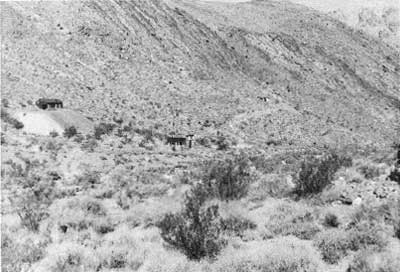 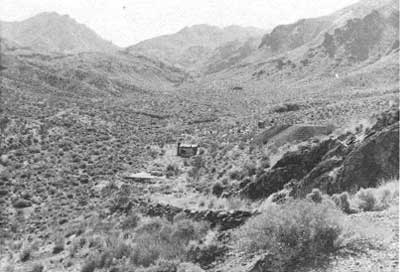
|
| Illustrations 66-67. Top: Leadfield in 1978, looking northwest up Titus Canyon. The old store building is in the center, with a mine building on the dump above. The buildings of the Western Lead Mine may be seen in the distant background. Below: Opposite of the above view, looking at the store from the dumps of the Western Lead Mine. Note the mill foundations in front of the store. 1978 photos by John Latschar. |
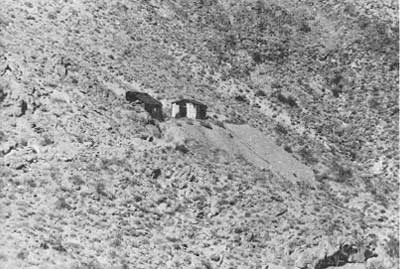
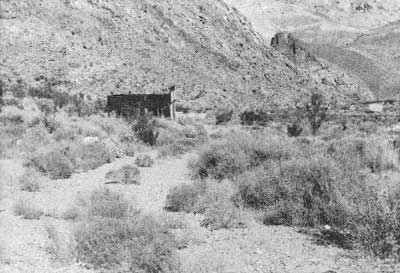
|
| Illustrations 68-69. The two frame and tin buildings of the Western Lead Mine, viewed from the southeast. Below: Main street, Leadfield, in 1978. Although not discernable in this picture, the ground on both sides of the old street are covered with former building and tent sites. 1978 photos by John Latschar. |
9. Miscellaneous Bullfrog Hills Properties
This section will cover a number of the less important sites within the Bullfrog Hills area. Some of these properties were identified with the Bullfrog District mining boom, while some are from later years, but for want of a better means of organization, all will be lumped together and discussed here.
a. Happy Hooligan Mine
The Happy Hooligan Mine, situated on the east slope of the Grapevine Mountains, about eleven miles west of Rhyolite, was one of the earlier discoveries within the Bullfrog District. The mine was first located by three prospectors named McMann, Stockton and Wilson in May of 1905. Within a month the rich surface ore brought in by the prospectors led to the sale of their five claims to Curtis Mann and the Gorrill brothers, who incorporated themselves as the Happy Hooligan Mining Company.
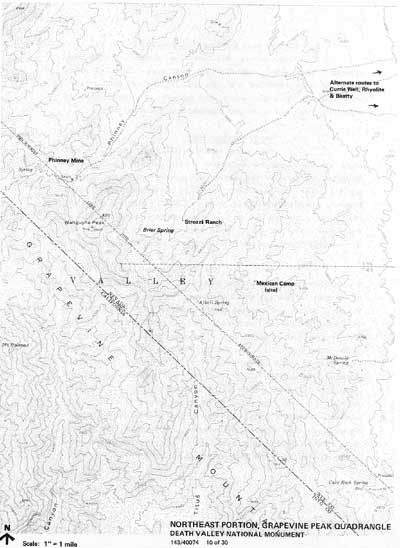
|
| Illustration 70. Map of the Grapevine Mountains. |
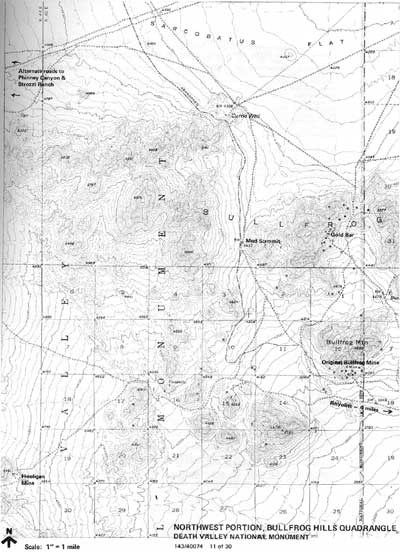
|
| Illustration 71. Map of the Bullfrog Northwest Portion of the Bullfrog Hills. |
In July of 1905, a visitor left a description of the month-old workings at the mine site. The mine itself consisted of an open surface cut and a discovery hole, he wrote, where ore values of $22 to the ton had been uncovered. The miners working at the Happy Hooligan lived in a large cave about one-half mile west of the mine, near a spring. The abundance of water and of wood--which was unusual for the Bullfrog District--made the camp a most pleasant place to visit and work. The owners of the Happy Hooligan informed the visitor that they had extensive development plans for the mine, including the erection of a mill at the water source. As usual, the publicity given the Happy Hooligan by this and other visitors soon resulted in the area around the mine becoming covered with location notices. For example, the Bullfrog Apex Mining Company, discussed before, located seven claims in the immediate vicinity of the Happy Hooligan in July of 1905.
Apparently due to the extreme heat of the summer, very little work was done on the Happy Hooligan between July and September of 1905. With the arrival of cooler weather, however, mining began in earnest in October, and ore values uncovered during that fall proved encouraging. The mine announced that ore ranging from $10 to $100 per ton was found in the surface trenches in October, and the following month an exploration shaft was begun. By the end of November, Curtis Mann reported that the ore values persisted with depth, as good ore had been found in the bottom of the new shaft, which was now seventy feet deep. Development was increased, and the company began to cut a wagon road from Rhyolite west to its mine, while Mann enthusiastically predicted that the company would build a stamp mill within six months.
As 1905 closed, indications at the mine continued to be encouraging, according to its owners. W. W. Stockton, the mine superintendent, reported that the ore vein was two feet wide and that the three shifts of miners employed on the property had sunk the inclined shaft to a depth of 120 feet. But F. L. Ransome, the government geologist who visited the Bullfrog District late in 1905, recorded a different impression. The ore vein was rarely more than a few inches in width, he reported, and the future of the Happy Hooligan would depend entirely upon what conditions were uncovered as the shaft went deeper. [88]
In January of 1906 the Happy Hooligan reported that values, were increasing with depth, and that the company had ordered a gas hoist for the property. Curtis Mann made a trip to San Francisco, where he arranged for the sale of Happy Hooligan shares on that city's stock exchange. Work continued through February and March, and the company announced that it would soon be ready to sack its high-grade ore for shipment. Simultaneously, the company opened an advertising campaign, and within three days after its first large ad appeared in the Rhyolite Herald had sold 50,000 shares.
During March, the company began construction of a blacksmith shop and a boarding house on its property, finally letting the miners escape their somewhat primitive accommodations in the cave. The road to the property was finished and the Rhyolite Herald reported that it was suitable for auto travel. Ten men were employed at the mine and the company began construction of an ore bin, in anticipation of the arrival of its hoist. On the 30th of that month, Taylor & Griffiths, one of Rhyolite's leading stock brokerages, wrote that sales of Happy Hooligan stock were satisfactory, with most purchases being made by eastern investors. The present price of 20¢ per share led the brokers to declare that they "recommend the purchase at these figures. We expect to see it go higher." It should be noted, however, that Taylor & Griffiths recommended the purchase of every stock which they discussed in their market report, all of which could coincidently be purchased at their offices.
As April went by the blacksmith shop at the Happy Hooligan was completed, and the company received a supply of 500 ore sacks, in order to prepare its high-grade ore for shipment. The company had started a new working shaft, which was down eighty-five feet, and expected that the arrival of the railroad in a few months would enable the Happy Hooligan to ship the high-grade ore at a profit. Within a month the 500 ore sacks were filled and waiting, despite delays caused by high winds which had blown down the new blacksmith shop. By the end of May, the company had finally located its hoist, which had been lost on a railroad siding during shipment, and began preparing the ground for the installation of it.
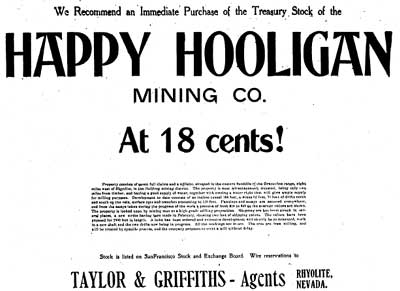
|
| Illustration 72. From the Rhyolite Herald, 2 March 1906. |
During the hot months of July and August, work was suspended at the mine, although whether this was due to the heat or to the lack of funds is not known. On September 14th, the company's stockholders voted at their annual meeting to resume work at the mine in the "immediate future." The long-delayed hoist was expected at any time, and the company announced that it had plenty of money to pursue development work for a number of months. Investors, however, were somewhat suspicious of the dearth of work at the mine since May, and stock prices began to slip. The high of 20¢ per share which the company had enjoyed in March had fallen to 16¢ by May and slumped further to a low of 9¢ by late September, when work was resumed at the mine.
During the first week of October, the Happy Hooligan reported that the cement foundations for the long-delayed hoist were nearly complete, that the new working shaft was down to 130 feet, and that the company had 500 sacks of ore waiting on its dump--which indicated that the company had not sacked any ore since May, when it had reported 500 sacks ready for shipment. Then, on October 19th, the long-awaited 15-horsepower gasoline hoist finally arrived, and was soon installed. With the new hoist working, sinking was resumed in the shaft, and the mine began to sack more high-grade ore. As these operations picked up during October and November, investors again took heart in the prospects of the company and stock prices started to rise. Shares in the Happy Hooligan sold for 10¢ each in October, and then for as high as 16¢ in early November, before closing that month at 14¢. With some of the money from the stock sales, the Happy Hooligan increased its estate by purchasing twelve adjacent claims, which had been located and briefly worked in previous years by prospectors who had since given up hope. [89]
The Happy Hooligan began to experience financial difficulties in early 1907. Despite the excellent showings which the company reported in its mine, and the fact that it had a carload of high-grade ore ready to ship to the railroad, the mine shut down in January and did not resume operations until April. In the meantime, however, the Happy Hooligan talked a good fight, announcing that grand development plans were being finalized and that the mine had $200,000 worth of ore blocked out.
By this time, the announcements from the Happy Hooligan were becoming somewhat contradictory. In May of 1906, the company had announced that it had 500 sacks of high-grade ore ready for shipment, and in March of 1907 it again stated that 500 sacks were waiting at the mine--despite the fact that the company had announced several times in the interim that more ore was being sacked. Either the company's management was not sure what was going on, or the Happy Hooligan was very clumsily trying to fool the public. Not many people were fooled, however, and Bullfroggers began to ask why the company did not ship its high-grade ore, now that the railroads had arrived in the Bullfrog district. Investors asked these same questions, and prices of Happy Hooligan stock fell from 12¢ in January to 9 on April 5th, when work was finally resumed in the mine.
After over a month of work, things had not changed much. By the end of May, the company still could count only 500 sacks of ore on the dumps, but it did announce that a shipment would soon be made. Contrary to that announcement, however, the mine was then closed, before any shipments were made, which makes one wonder if those 500 sacks of ore ever existed. For the rest of 1907 the Happy Hooligan was idle, and the only work performed at the site for the next three years was the minimum necessary annual assessment work to enable the company to retain title to its claims. In 1911, however, even that was not performed, and the Happy Hooligan property re-entered the public domain of the state of Nevada.
Although the story is not at all clear, the Happy Hooligan had apparently run out of development funds in May of 1907, and before refinancing could be obtained, the Panic of 1907 had wiped out any chance that the company could ever resume operations. As a strange epilogue, stock in the Happy Hooligan remained on the trading boards long after the mine had closed. When work ceased in May of 1907, Happy Hooligan was selling at 3-1/2¢ per share, but instead of dropping completely off the board when the mine closed, the stock hung on for almost another year. Prices slowly slipped from 3¢ to 2¢ and then to 1 per share through the rest of 1907, but not until March of 1908 did the stock finally disappear from the trading boards.
Details regarding the Happy Hooligan mine after its closure in 1907 are sketchy, although it is certain that nothing significant took place on the property during the ensuing decades. Physical evidence indicates that someone lived at the the mine and attempted to work it on a very small scale during the 1930s, and in 1951 the property was actively owned under another name. It is evident, however, that nothing more that surface scratching and prospecting took place during these periods. The mine is idle today and bears every indication of having been so for quite a number of years. [90]
Remains at the Happy Hooligan site are not impressive, and consist mostly of small dumps around shallow adits and shafts. Car parts litter the site, as well as assorted tin and wood debris, most of which seem to have come from a crude sort of reduction attempt in the 1930s era. An abandoned frame and tin shack may be found about one-half mile west of the mine, which is also tremendously littered with car parts and junk. The debris is the sort which one would expect around the home of an unknown desert hermit, who probably took refuge there during the depression, and feebly tried to work the mine. There is nothing at this site which deserves protection, preservation or interpretation.
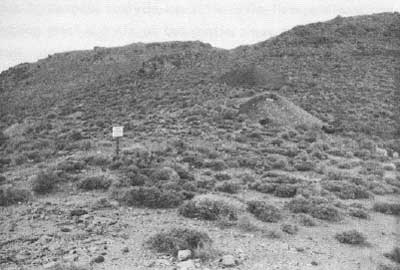
|
| Illustration 73. Site of the Happy Hooligan Mine, showing the two main dumps. 1978 photo by John Latschar. |
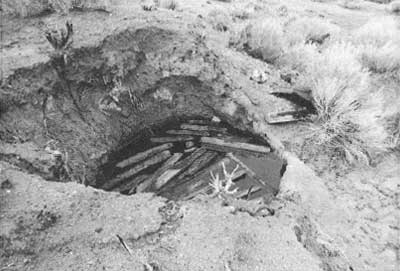
|
| Illustration 74. The main well at Currie Well, showing the deteriorated remains of earlier attempts to improve the water source. 1978 photo by John Latschar. |
b. Currie Well
Currie Well's claim to fame rests mostly on its use as a desert watering hole for stages and trains traveling between Rhyolite and Goldfield. Located some eleven miles north of Rhyolite, or seven miles north of the Original Bullfrog Mine, the water from this site was first used to supply thirsty horses, mules, teamsters and passengers traveling through the area. The site was claimed in succession by several miners and entrepreneurs, who tried to eke out a living by selling water to travelers and by providing meals for men and forage for animals. There is no indication that these efforts, which lasted intermittently from 1907 to 1909, ever paid off. Sporadic efforts were also made in later years to improve the well site, with no obvious degree of success, and in 1911 two intrepid souls attempted to start a farm garden and alfalfa field. Again, the short life of these operations indicates that they were entirely unsuccessful.
The two brief spurts of real activity which surround the well site came during 1907, when the Las Vegas & Tonopah Railroad's construction crew made the place a work camp due to its water source, and during 1909, when the owner of the well tried unsuccessfully to improve the water flow in order to pipe it to adjacent mines. These spurts of activity were brief, however, and soon died out. Several short-lived mining companies also briefly tried to develop their claims in the area, but all these efforts died a quick and merciful death. [91]
The area around Currie Well is littered with various types of debris which tell the story of brief and unsuccessful attempts to exploit the water rights. Piles of barbed wire depict the site of an old corral, probably the one used for stage horses during the stop-over. Various piles of junked sheet and tin metal are left behind by those who attempted to control the flow of water from the well, which seemed to prefer seeping out of the ground at unlikely and unwanted spots. The only remains of any note are the ruins of two small beehive furnaces. Some people believe that these crude furnaces mark an attempt to smelt ore from local mines, but it is much more likely that they were used by the railroad construction crews as open-air blacksmith forges. None of these remains are of National Register significance. Until a historical archaeologist can determine more about them, these sites should be treated with benign neglect.
c. Mexican Camp
Mexican Camp, located in the Grapevine Mountains about thirteen miles west of Rhyolite, was the site of a short-term wood cutting operation during the early years of the Bullfrog boom. Located at a small, intermittent spring, the camp was the headquarters of a group of Mexicans (hence the name), who cut timber from the surrounding hills, and hauled it out to Rhyolite via a trail which connected the camp to Titus Canyon. Operations at the camp appeared to be marginally successful, until the arrival of the Las Vegas & Tonopah Railroad in the Bullfrog District in December of 1906. After that, the Mexicans could no longer compete with the price of lumber brought in by the railroad, and the camp was abandoned. The site of Mexican Camp has apparently remained on USGS maps to this date primarily because no one knew what it was and thus dared not take it off. There is nothing of historic significance at the site today, although it may have historical archaeological potential. [92]
d. Phinney Mine
The Phinney Mine, located about eighteen miles northwest of Rhyolite in the Grapevine Mountains, is the site of a small-scale, two-man mining attempt during the 1930s. The mine was first located by Charles E. and F. C. Phinney of Beatty in 1930, and between then and the end of operations in 1938, the two men managed to ship out approximately fifty tons of ore worth $17 per ton--for a grand total of $850. Not surprisingly, with the advent of better times towards the end of the depression era, the Phinney Mine was abandoned, and Charles Phinney moved to Beatty, where he died in 1952. [93]
Structures at the site include two adits and small dumps associated with them, a small pipe line which funneled water from a spring above the mine down to the work area, and a decrepit twelve- by twenty-foot cabin built on the mine dump. The cabin shows all intentions of plunging off the side of the dump in the near future, due to erosion, and no one should be particularly concerned if it does.
About one-half mile above Phinney Mine' is the site of another small-scale mining attempt, which also appears to date from the depression era. Remains at this site consists of a tent site, an old ore loading dock and a small shaft with a collapsed hoist. No known name can be associated with this mine for certain, and the site has no historical significance. [94]
e. Strozzi Ranch
The Strozzi Ranch site, located two miles southeast of the Phinney Mine, or about sixteen miles northwest of Rhyolite, was the scene of a 1930-era ranching effort in the Grapevine Mountains. The site was homesteaded by Caesar Strozzi around 1931, and was seasonally used between then and 1947. Apparently Strozzi lived at the ranch during the summer months and resided in Beatty during the winter. Since his tax lists show assorted numbers of cattle, goats and chickens throughout these years, he evidently used the ranch as a summer grazing ground, and herded his animals back to Beatty for the winter.
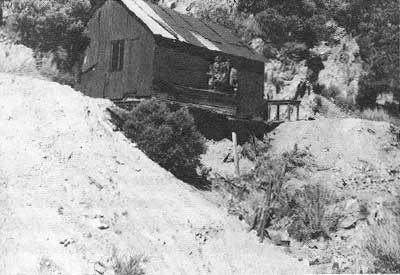
|
| Illustration 75. Decrepit wood and tin shack on the dump at Phinney mine, emphasizing its precarious future. 1978 photo by John Latschar. |
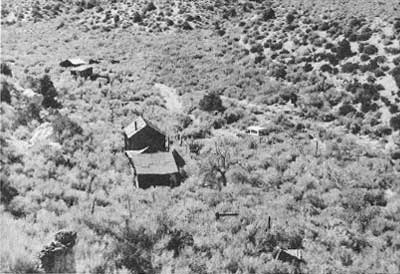
|
| Illustration 76. View of Strozzi's Ranch. The tallest building in the center of the picture is the main living quarters, and support buildings are scattered up and down the small valley. The roof of the dugout is visible to the right of the vehicle. Note the fence posts scattered about. 1978 photo by John Latschar. |
The ranch is located just north of Brier Springs, which Strozzi used for a water source, and evidence at the site that he also grew several small crops. A few peach trees, for example, may still be found fighting a desperate battle against the weeds. During the sixteen years that Strozzi utilized the ranch site, he erected several major improvements. Today the visitor may see the remains of a main house constructed of wood and tin, and five shacks, which served as a blacksmith shop, a chicken house, and the like. In addition, two dugouts are on the property, one of which is in fairly good shape. Extensive fragments of fence posts and fencing material indicate efforts which Strozzi took to keep his livestock under control. The National Park Service has added to the scenery of the site through the installation of two port-a-johns for the benefit of picnickers, who cannot reach the site anyway since the access road is completely washed out.
In the absence of more detailed information, the Strozzi ranch seems to be the site of one man's efforts to exploit free grazing rights on a seasonal basis, rather than a year-around residence. The attempt has no historical importance, and the buildings at the ranch do not deserve preservation. Although Strozzi's son is still alive and living in Beatty, he was uncooperative when asked for information by a representative of the National Park Service, which is not an unusual attitude among the local population. [95]
| <<< Previous | <<< Contents >>> | Next >>> |
deva/hrs/section4a.htm
Last Updated: 22-Dec-2003